编译器结构
词法分析 Lexical analysis or scanning
检测输入字符串中不属于我们语言的那部分符号
词法分析把程序字段变成关键字words or 词法单元tokens
如
if x == y then z = 1; else z = 2;
分号,标点,分隔符都是词法单元
语法分析syntax analysis parsing
试着去判断是否格式正确或者是否是有效程序(语句中是否存在格式错误或没用解析树)
if then else包含三部分
predicate条件判断,then语句和else语句
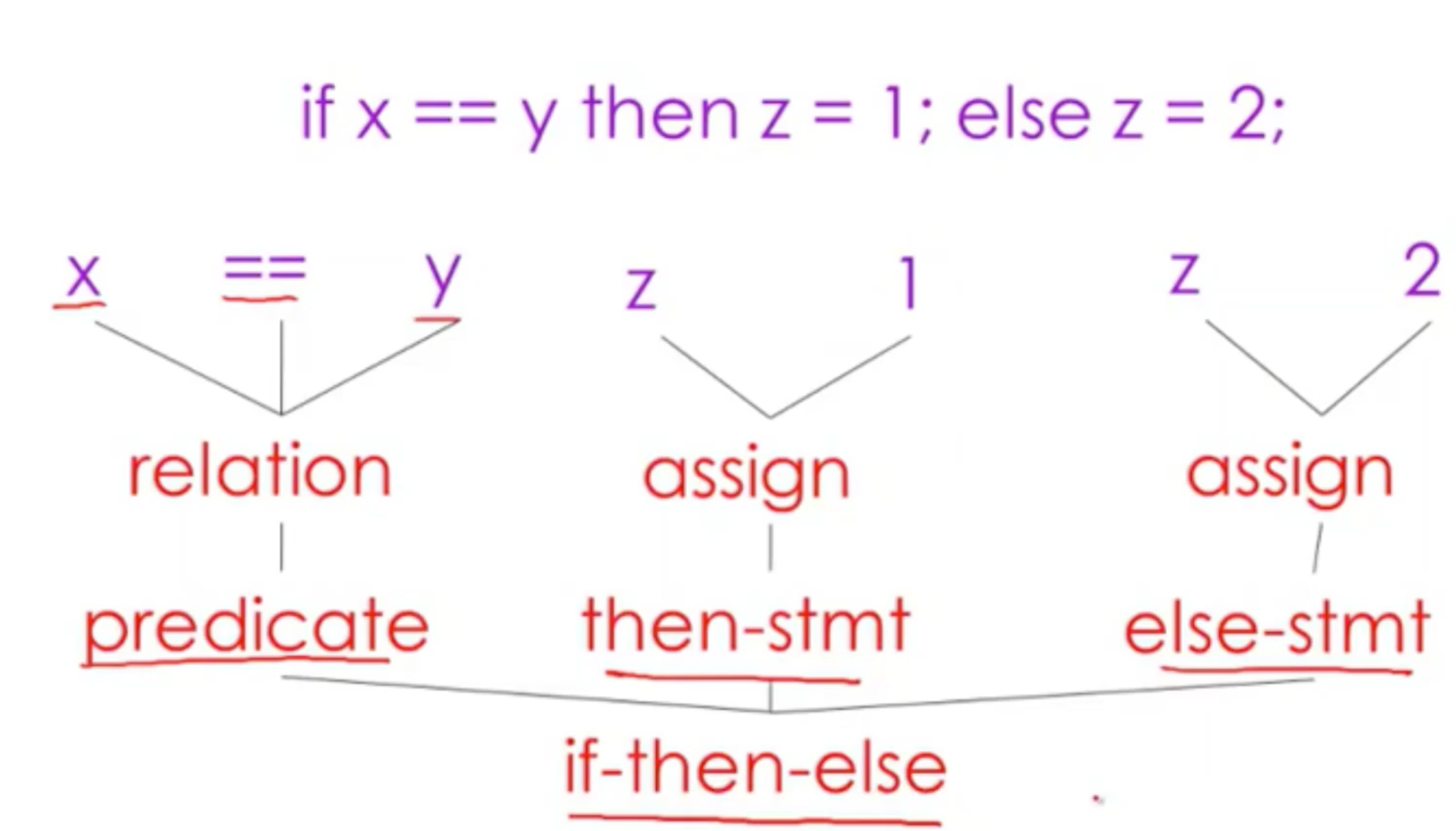
语义分析 semantic analysis
尝试去找出矛盾的地方
优化 optimization
修改代码使之使用更少的资源
代码生成
高级语言转变成汇编
Cool语言
class Main {
i : IO <- new IO;
main() : Int { { i.out_string("Hello wordld!\n"); 1;} };
};
Int 是return type。
class Main {
i : IO <- new IO;
main() : IO { { i.out_string("Hello wordld!\n"); } };
};//一旦打印完string就退出
class Main {
i : IO <- new IO;
main() : Object { { i.out_string("Hello wordld!\n"); } };
};//Object 返回类型
class Main {
main() : Object { { (new IO).out_string("Hello wordld!\n"); } };
};
下面是继承的写法
class Main inherits IO{
main() : Object { { self.out_string("Hello wordld!\n"); } };
};
class Main inherits IO{
main() : Object { { out_string("Hello wordld!\n"); } };
};
词法分析
目标是将输入流划分为词素。
从左到右的扫描字符串,有时必须对输入字符串向前看,才能弄清楚当前字符串和子字符串在语言中的角色
变量名称:字母开头
字符串-> 语法分析器 ->变成token<class, string> parser解析器
foo = 42 -> <Id, “foo”> <operator, “="> <Int, “42”>
有以下几类:
- 空格whitespace
- keyword
- identifiers
- numbers
这些子字符串称为词素(构成词的要素),<token class, lexemes词素>,这就是一个token
正则表达式
基础表达式
单字符
‘c’ = {‘c’}
Epsilon
Epsilon = {”"} = 单个字符的空字符串 != 空字符串
复合表达式
Union
A + B = {a|a属于A} U {b|b属于B}
A并B
Concatencation 级联
如[a,b]与[c,d]级联得到[ac,ad,bc,bd]
AB = {ab | a属于A ^ b 属于B }
Iterator 串联
A* = 0到无穷个A串联
匹配变量名
A+ = AA* = 至少一个A
digit = ‘0’ + ‘1’ + ‘2’ + ‘3’ + ‘4’ + ‘5’ + ‘6’ + ‘7’ + ‘8’ + ‘9’
letter = [a-zA-Z] 匹配所有字母
letter(letter+digit)* 字母+0或多个字母和数字的组合
空格 ’ ’ + ‘\n’ + ‘\t’
opt_function = (’.‘digits)?
Opt_exponent = (‘E’(’+’ + ‘-’)?digits)?
###词法规范
当输入值有两种不同的前缀,且这两种都是有效的词法单元时,就应该选择最长的那个,最长匹配原则Maximal Munch
当匹配到两个规则的时候,如keiword,identifiers,会优先匹配第一个choose the one listed first。
捕获有可能错误字符串的正则表达式并赋予其最低优先级
有限自动机Finite Automata
定义
- 一组能读取的输入字符串
- 一个有限状态的集合
- 一个特殊的集合被设定为开始状态
- 一组用于接受状态的集合(读取完可接受状态输入后自动结束,否则拒绝输入
- 有一些用于状态转换的集合
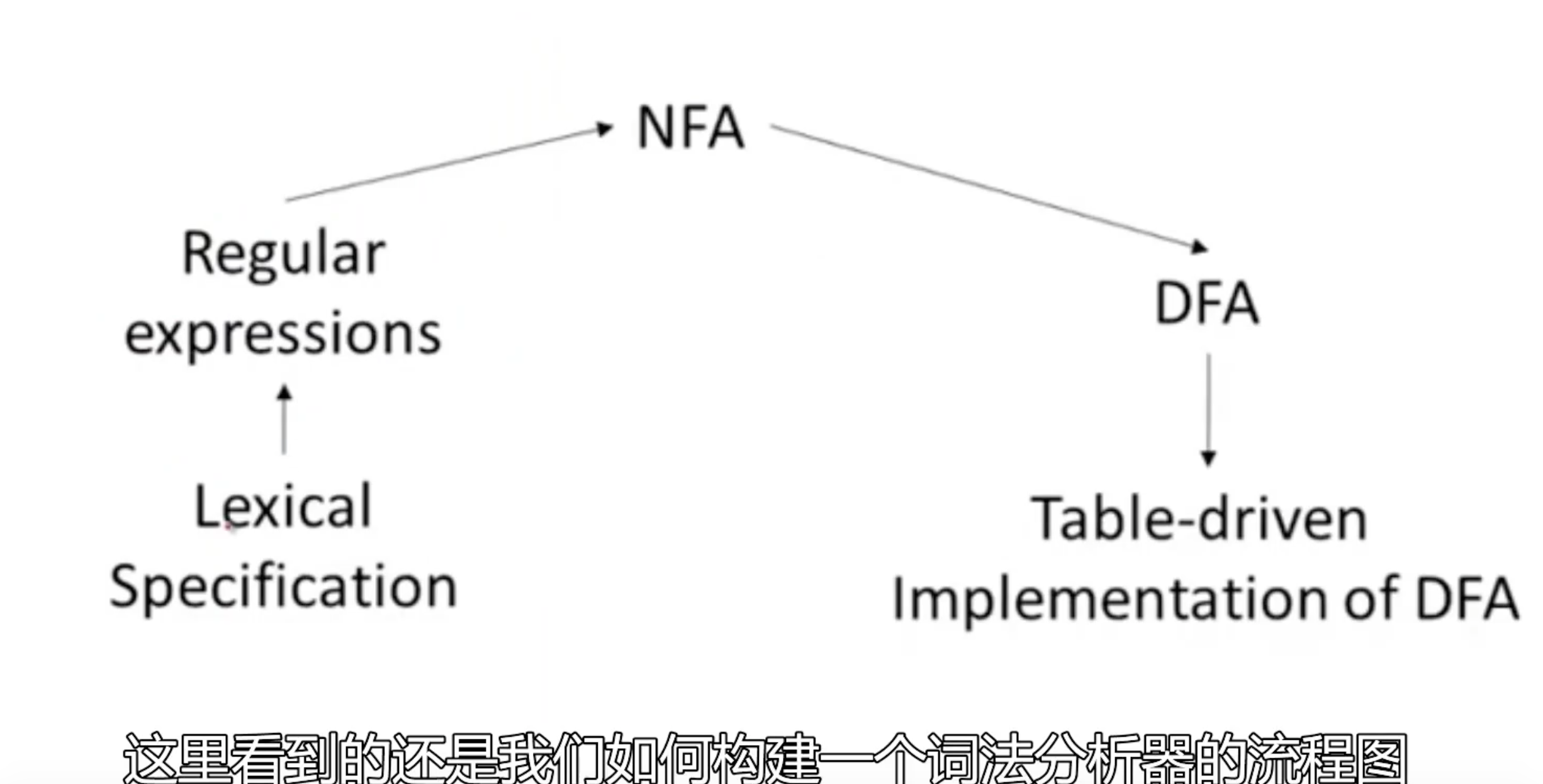
Exampls
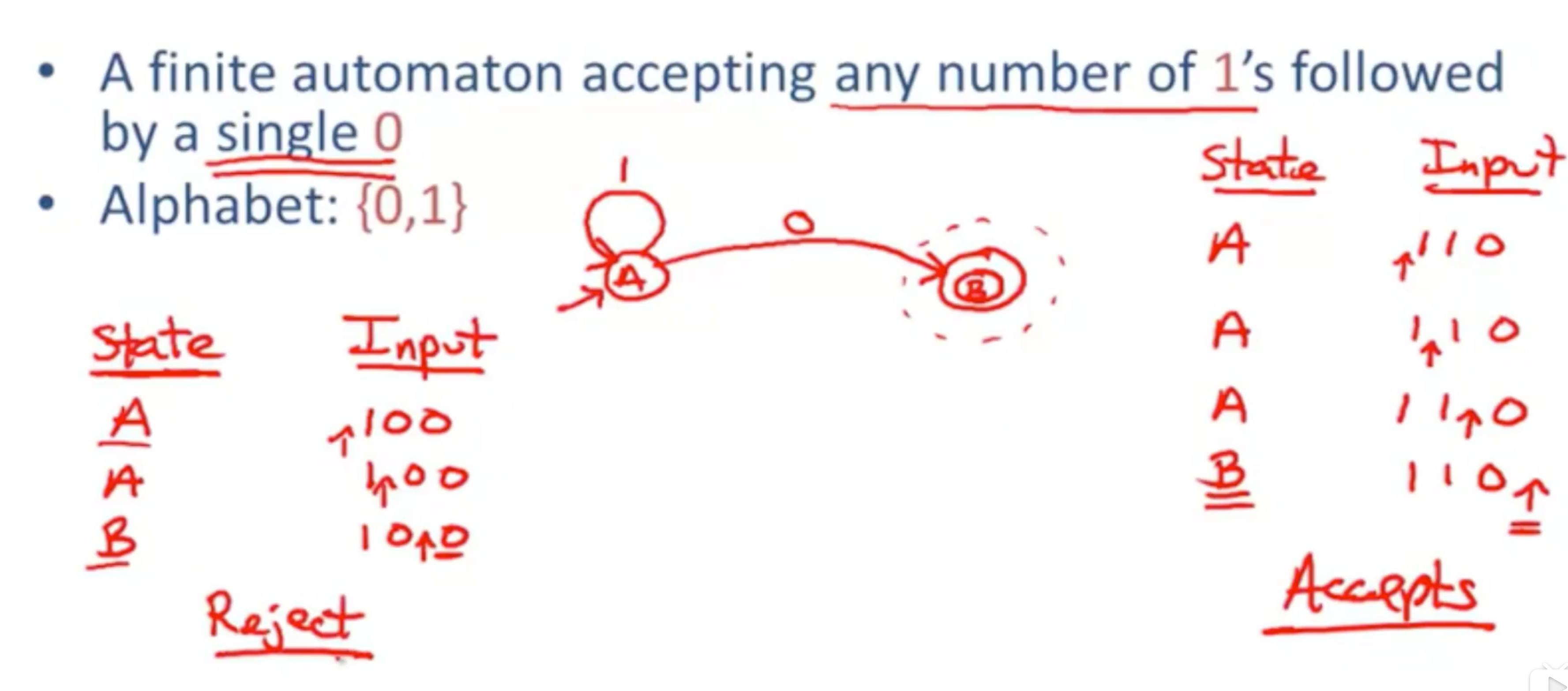
确定性自动机和非确定性自动机的区别

DFA只有一条道可以通过
NFA基于输入执行,可能处于许多不同的状态,只要有任何一条路径可以接受,就会处于接受状态 ,这个字符串就属于这个NFA可以接受的语言
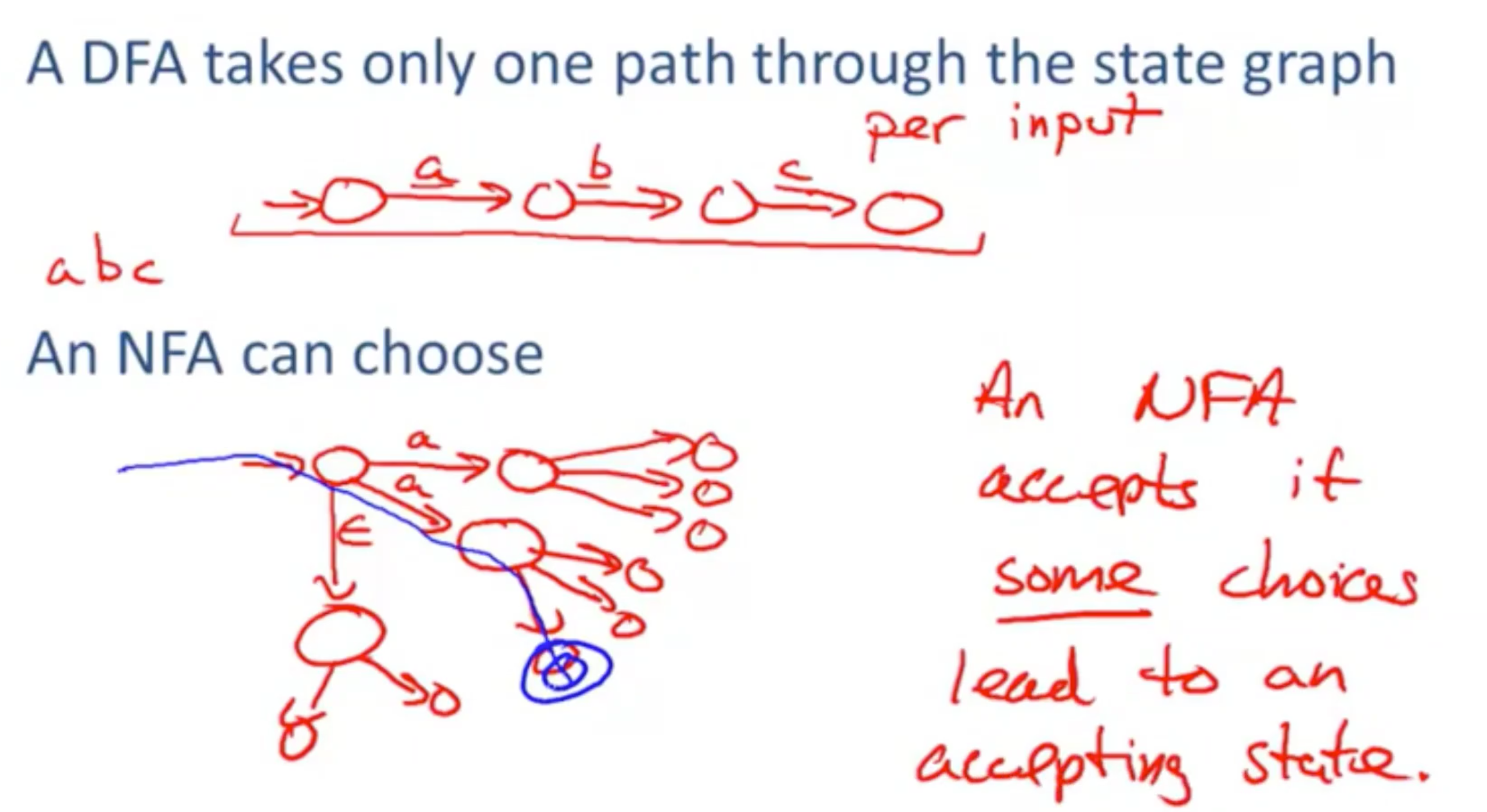
NFA要远比DFA来的小,可以成倍缩小,DFA执行速度更快
将正则表达式转换为NFA 非确定性有限自动机
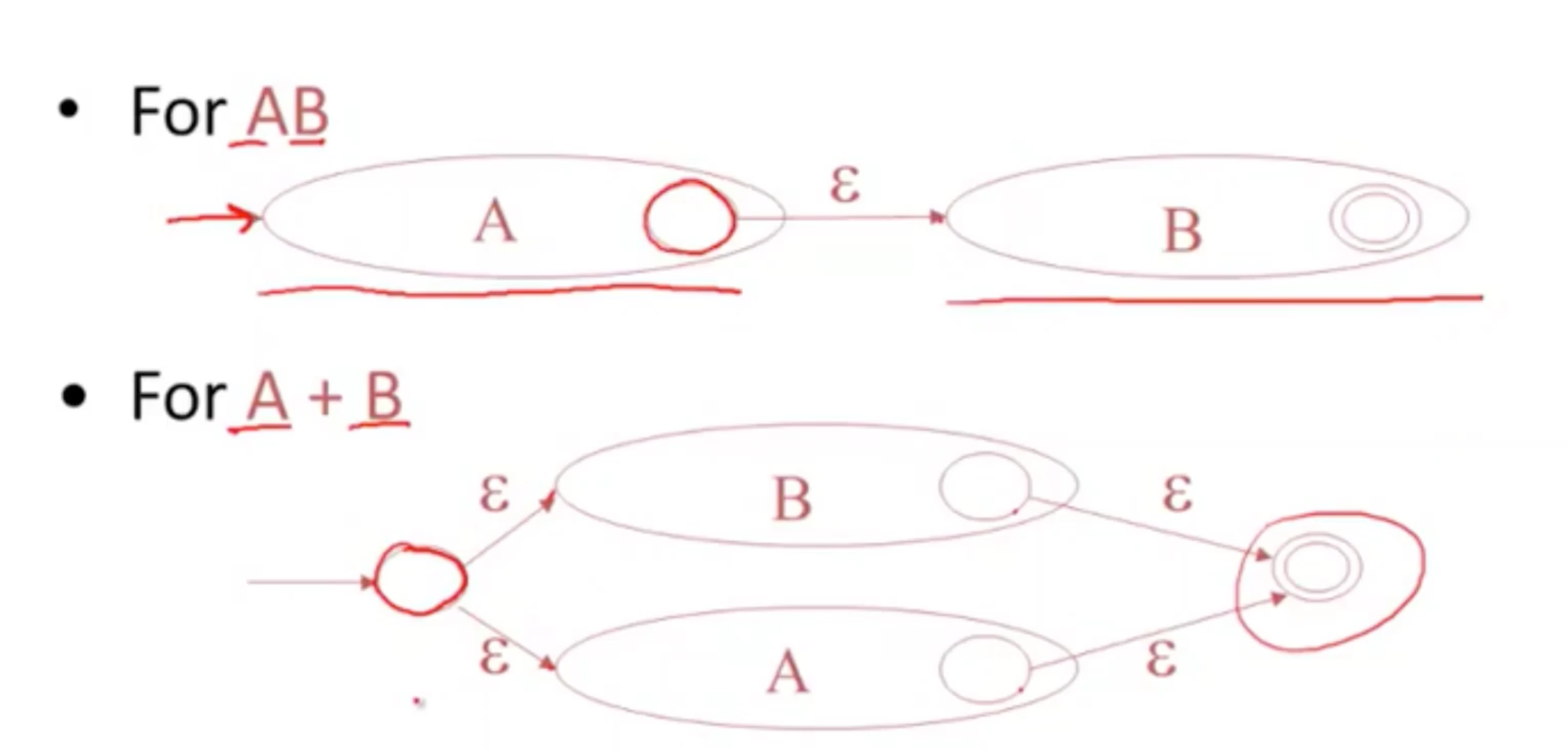
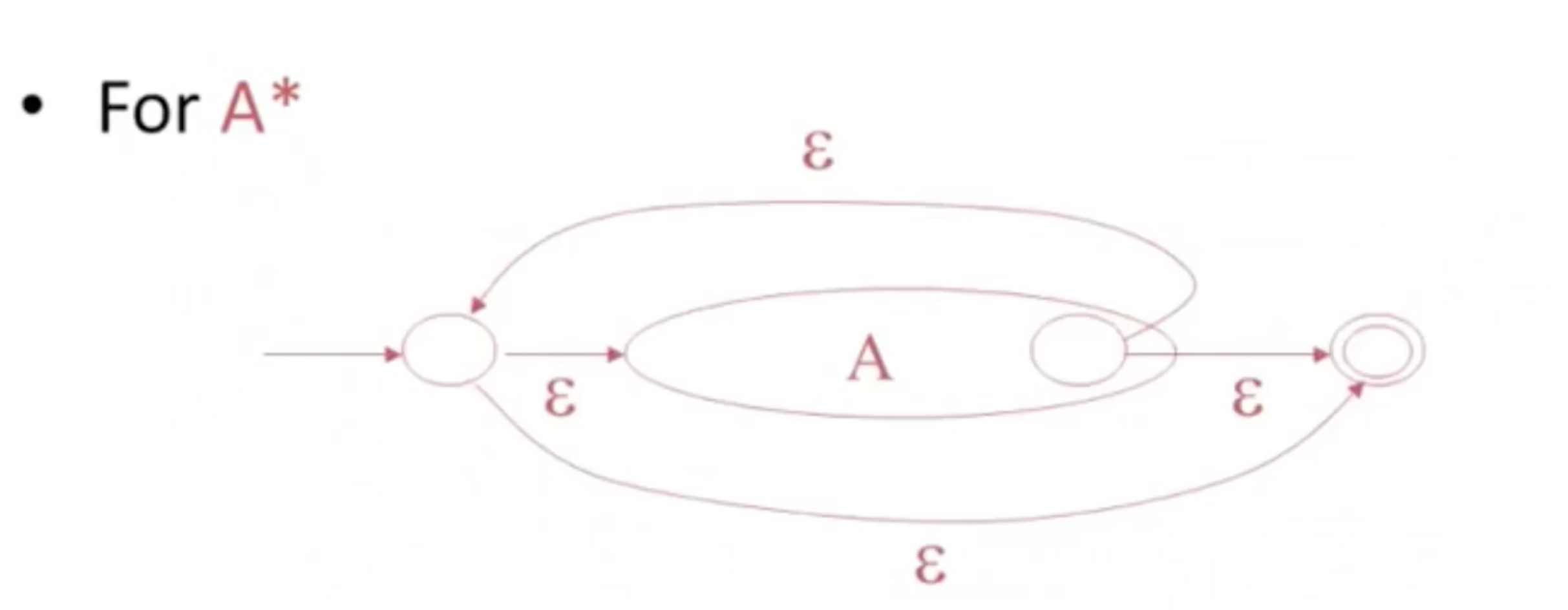
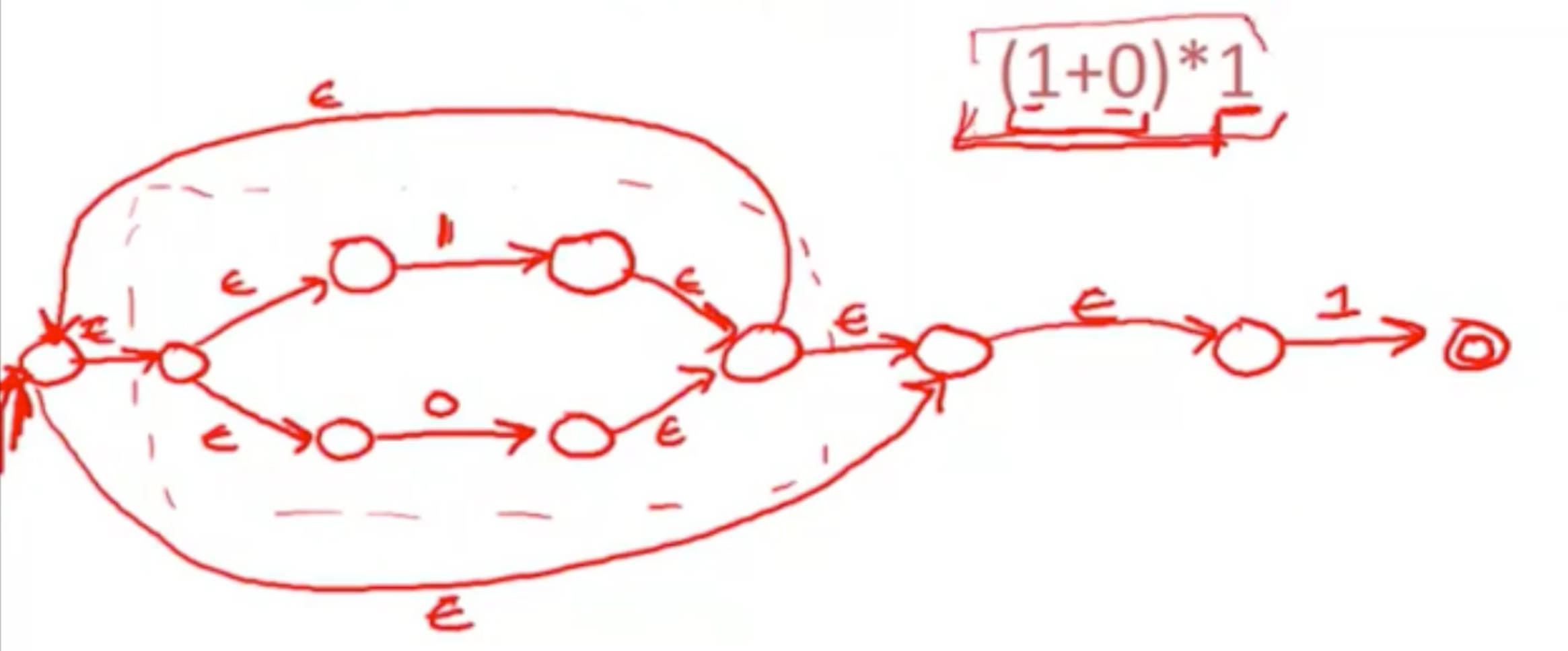
NFA to DFA
Epsilon-closure:是状态选择,可以是一组状态,但只针对单个状态进行处理,只关注那些仅通过空跳就可以到达的状态。
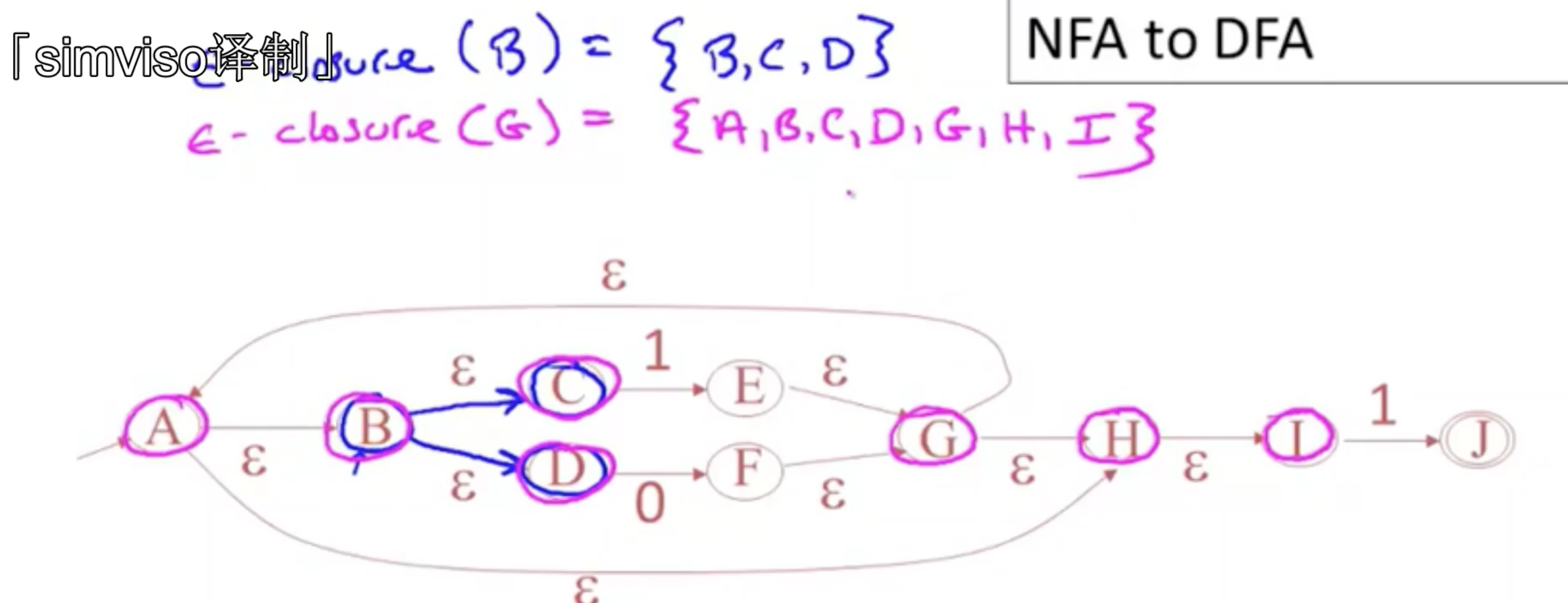
N种状态,可用状态数量子集|S| <= N,公用2^N -1种非空子集
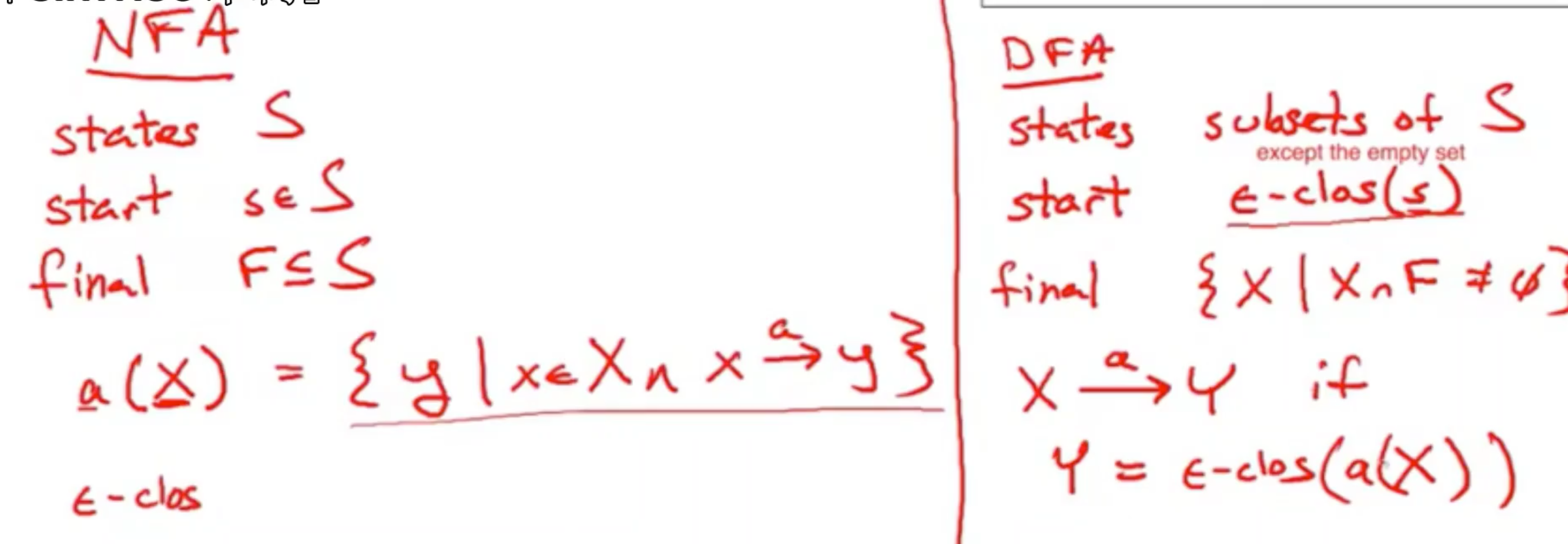
所维护的每一个属性都指代一条计算执行路径,DFA的状态记录了NFA基于相同输入可能进入的可能状态集
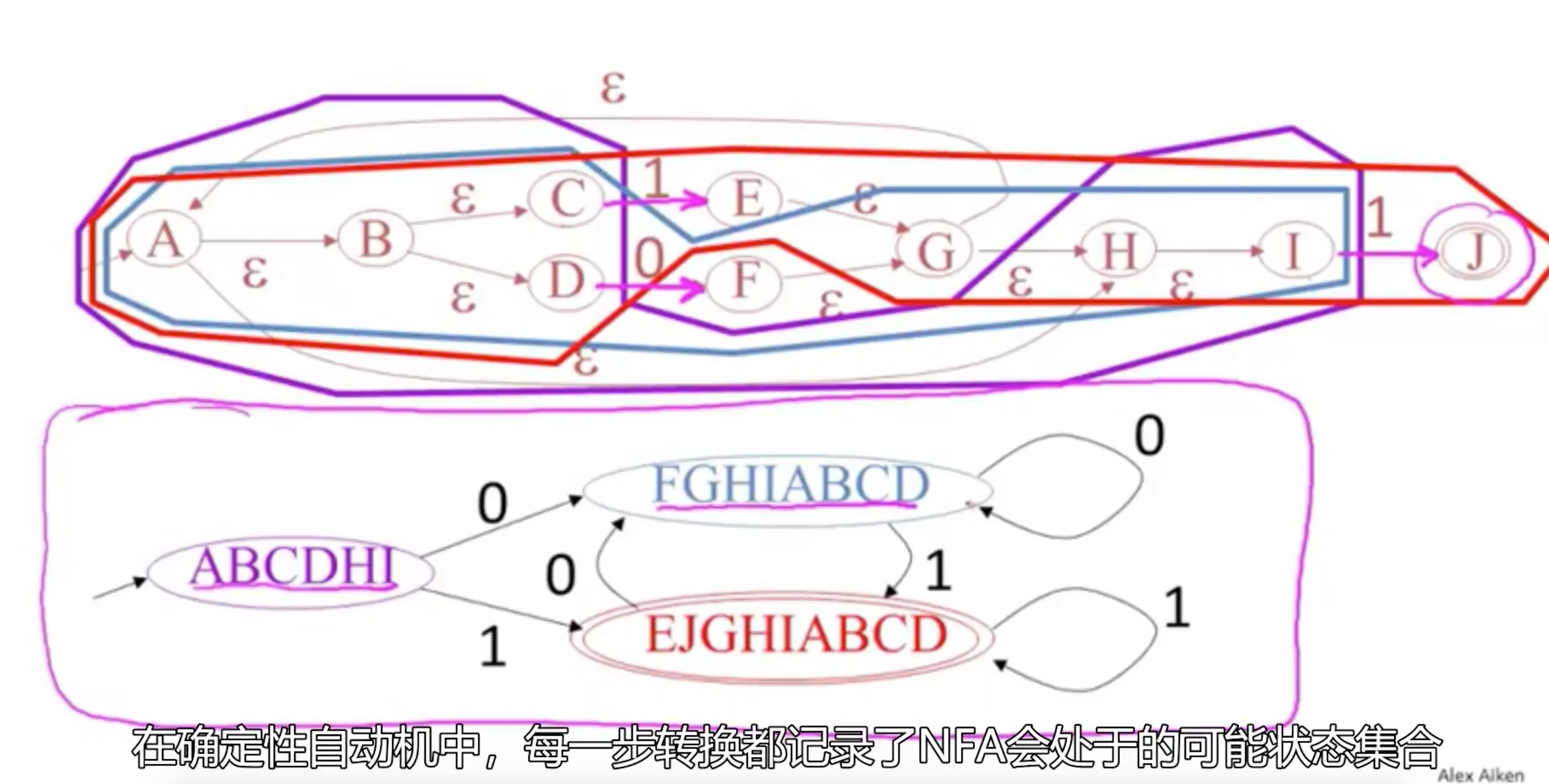
原视频讲解链接:link 11:15秒
实现有限自动机


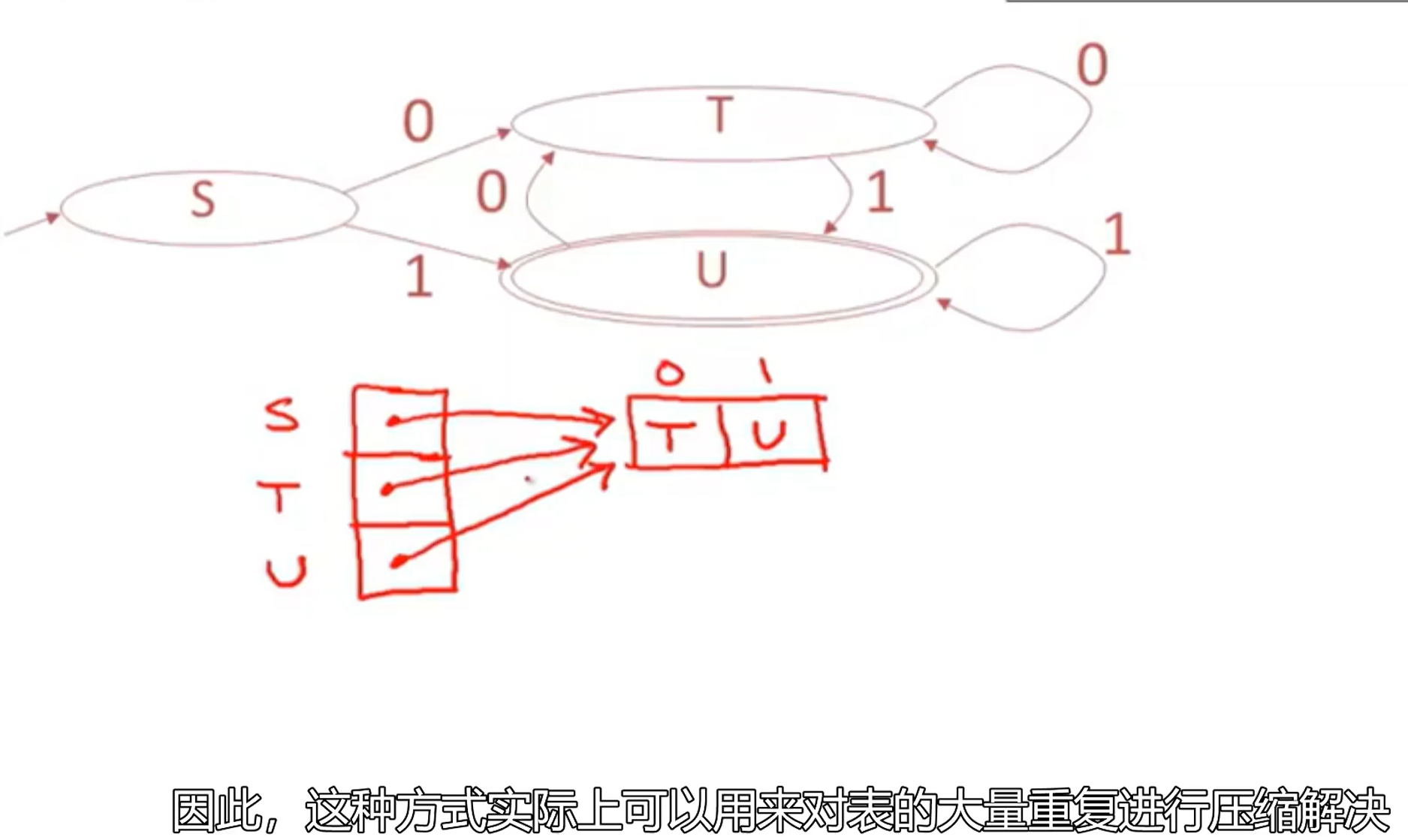
实现NFA
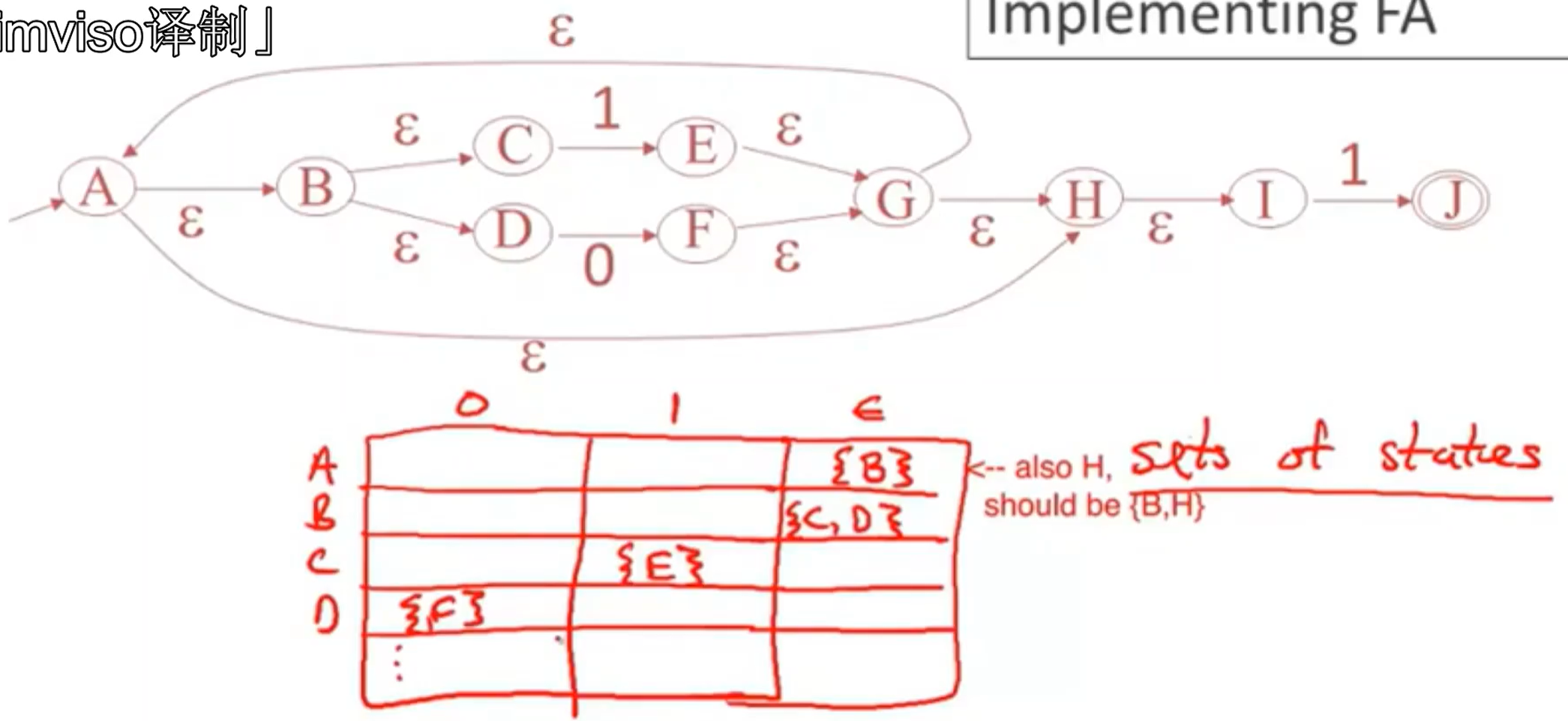
节省了大量表空间,但是
执行速度比确定性自动机慢很多
总结
DFA执行速度更快,结构上较为松散
NFA速度较慢,结构紧凑
PA2
https://github.com/mrbelieve128/Stanford-Compilers-PA/tree/master/PA2
解析器 Parsing

上下文无关文法 context-free grammar
- 不是所有token都是程序
- 解析器parse需要分辨有效和无效的字符串
所以需要
- 需要中算法来分辨有效token
- 算法来分辨有效token和无效token
上下文无关的文法自然而然地用于描述这种递归结构

上下文无关的文法包含
- A set of terminals T
- A set of non-terminal N
- A start symbol S (S 是 N之一)
- A set of productions (是指一个符号跟着一个箭头,紧接着一串符号)

推导
Example
Grammer
E -> E+E | E*E | (E) | id
String
id * id + id
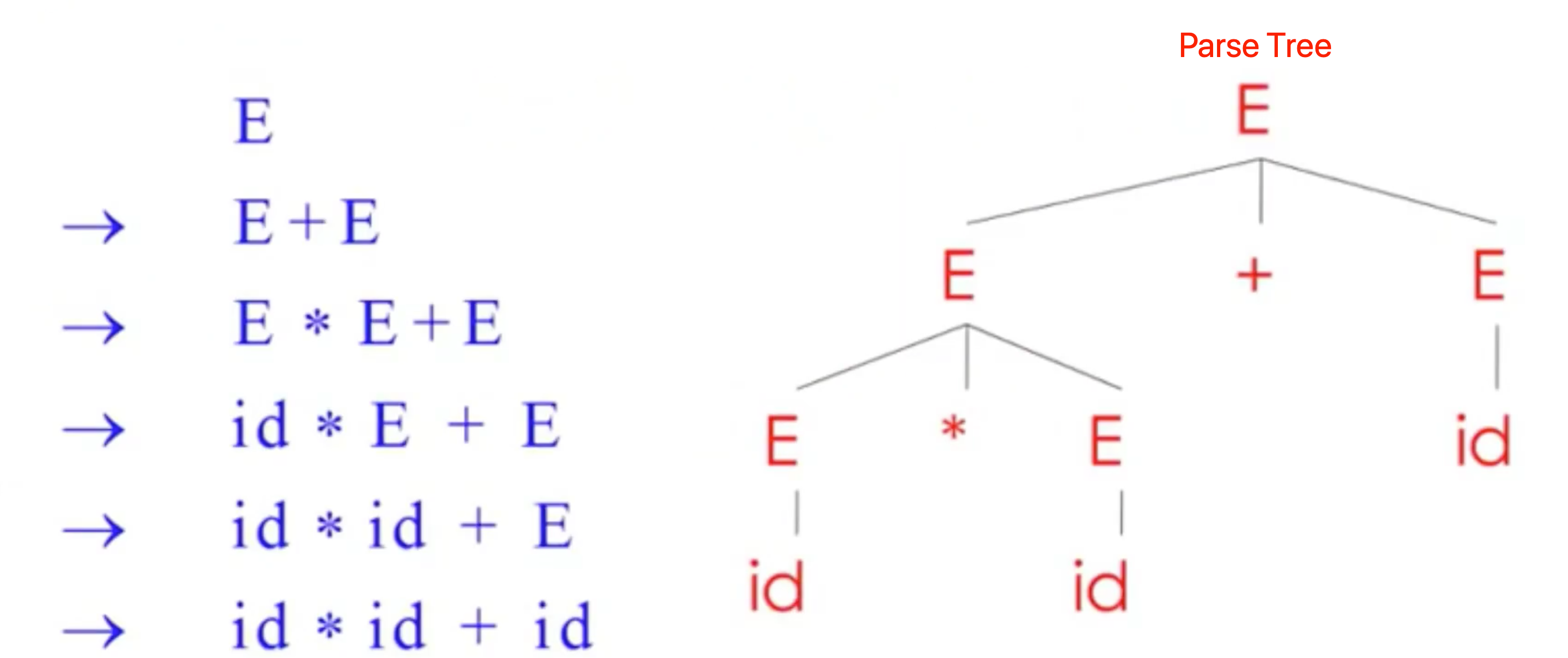
A parse tree has
- Terminals at the leaves
- Non-terminals at the interior nodes (内部节点)
叶子结点的中序遍历结果是原始输入
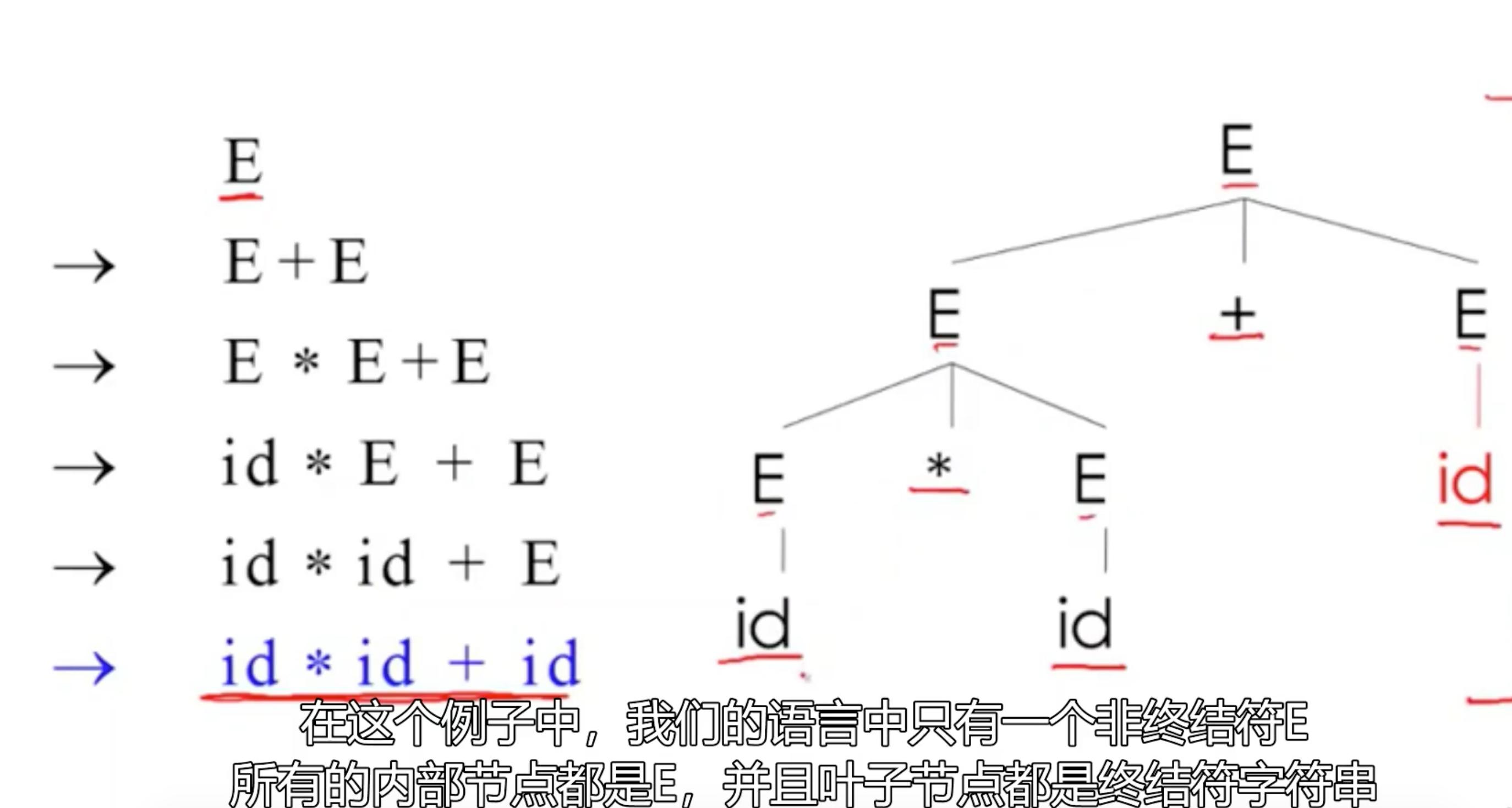
解析树也展示了操作间的关联性,但输入字符串并没有展示
如上图,**""要比"+"**号更优先,因为号是+号的子树
上图这个例子是最左推导(在每个步骤先替换最左边的非终结字符)也有个等价概念最右推导
最左和最右推导生成的解析树都是一样的
总结
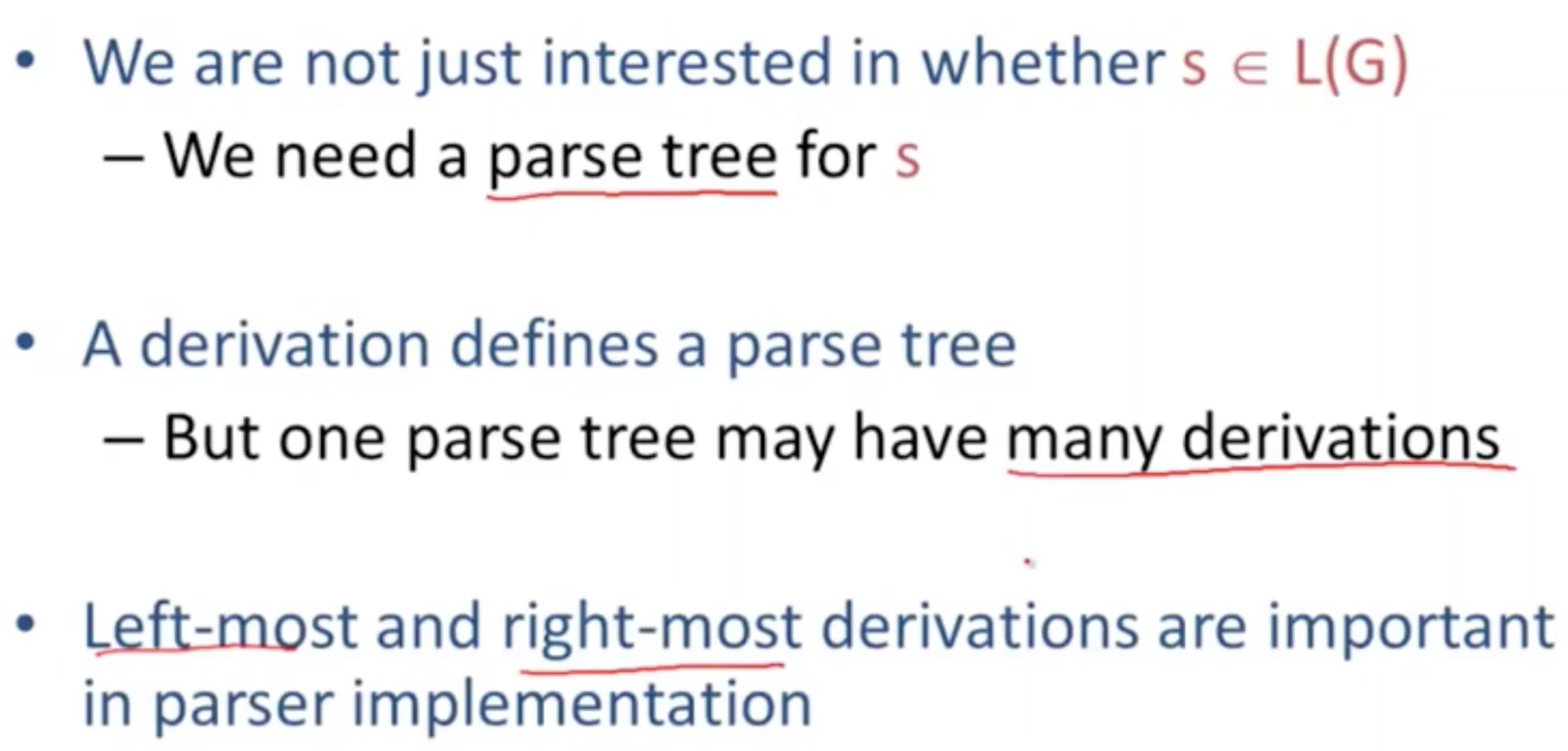
Ambiguity 歧义性
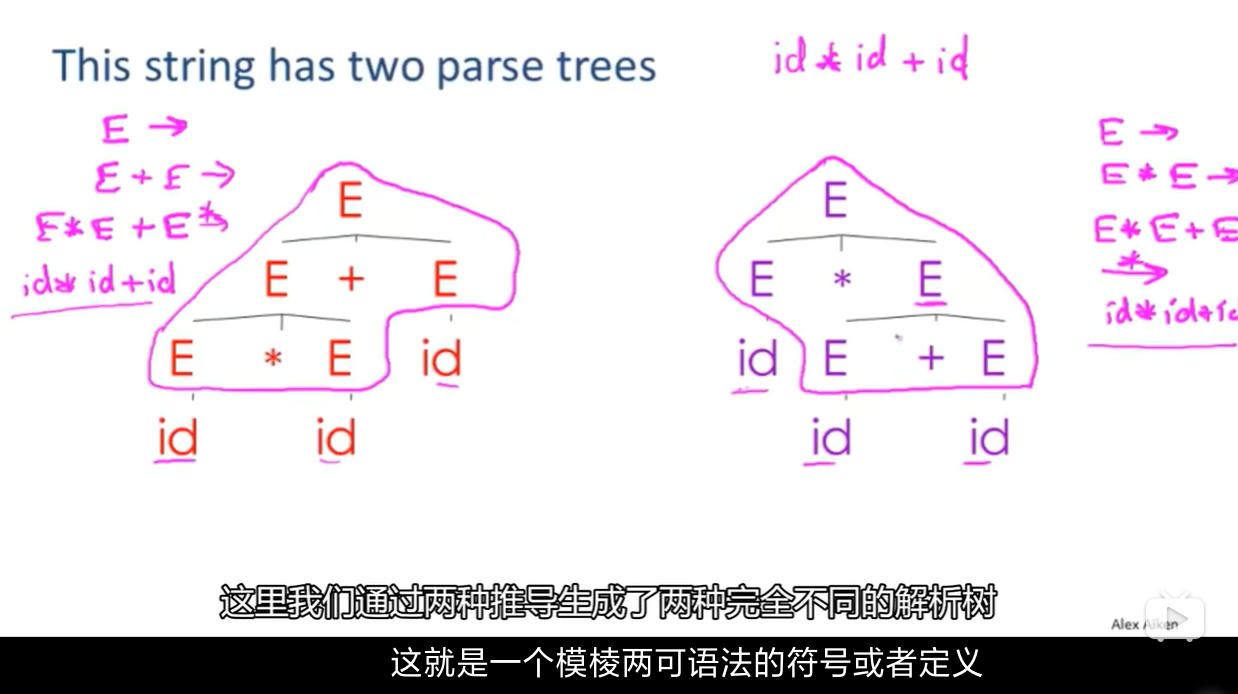
- 如果对于某个字符串有多个解析树,那么这个语法就是模棱两可的。或者说,对于某个字符串有多个最右推导或者最左推导,那么这个字符串就会有两个截然不同的解析树,语法也会变得有歧义
- Ambiguity is BAD
消除歧义性得最直接办法是重写语法,生成相同语法但生成单一解析树
E -> E’ + E | E’
E’ -> id * E’ | id | (E) * E’ | (E)

if-then-else结构
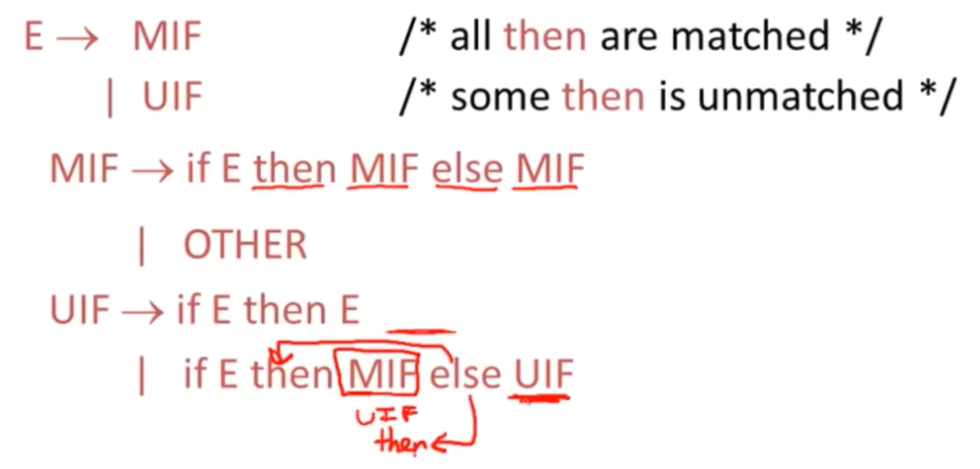
总结
-
Impossible to convert automatically an ambiguous grammar to an unambiguous one
-
User with care, ambiguity can simplify the grammar
sometimes allows more natural definitions
We need disambiguation mechanisms
-
Instead of rewriting the grammar
Use the more natural (ambiguous) grammar
Along with disambiguating declarations
-
Most tools allow precedence and associativity declarations(优先性和关联性声明) to disambiguate grammars
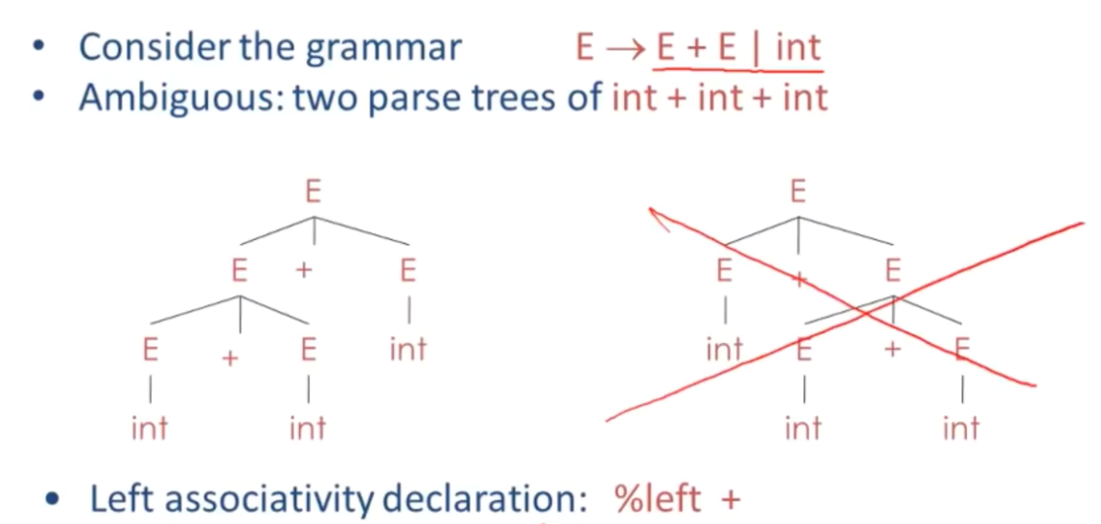
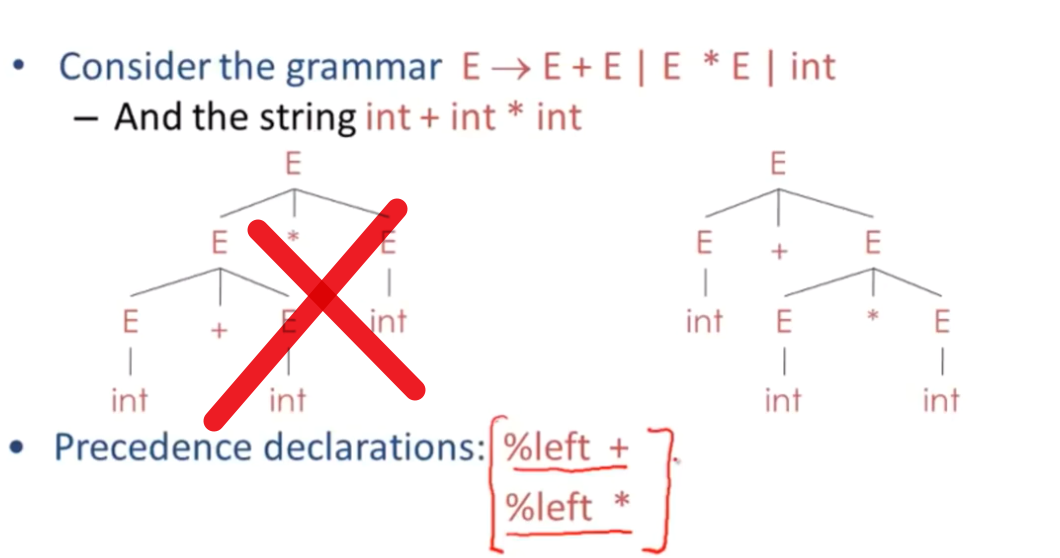
错误处理
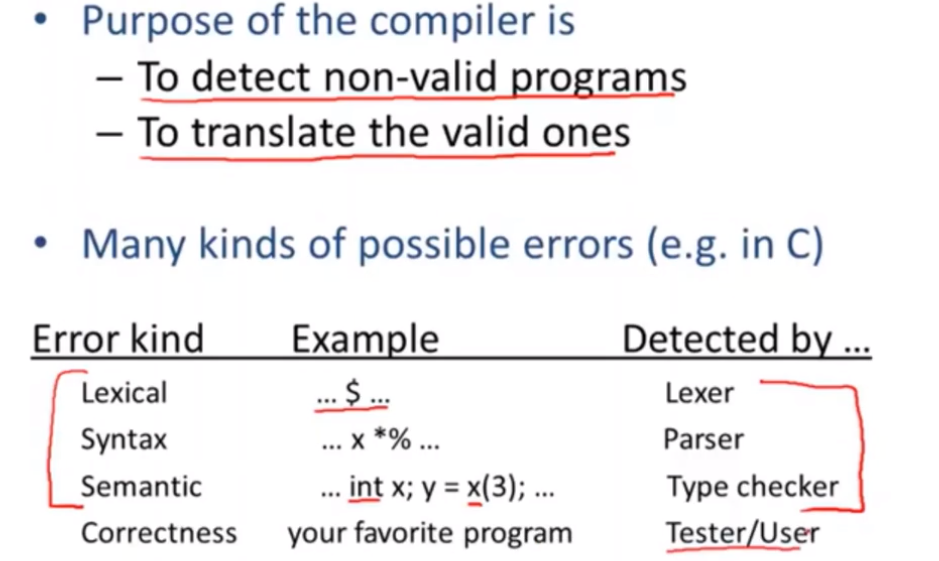
紧急模式
最简单,最广泛使用的
检测到错误,解析器会开始抛弃 token直到找到作用明确的token

错误产生式
将常犯的已知错误指定为语法中的替代产生式
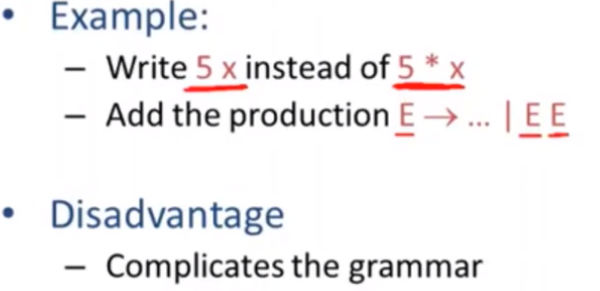
自动局部或全局校正
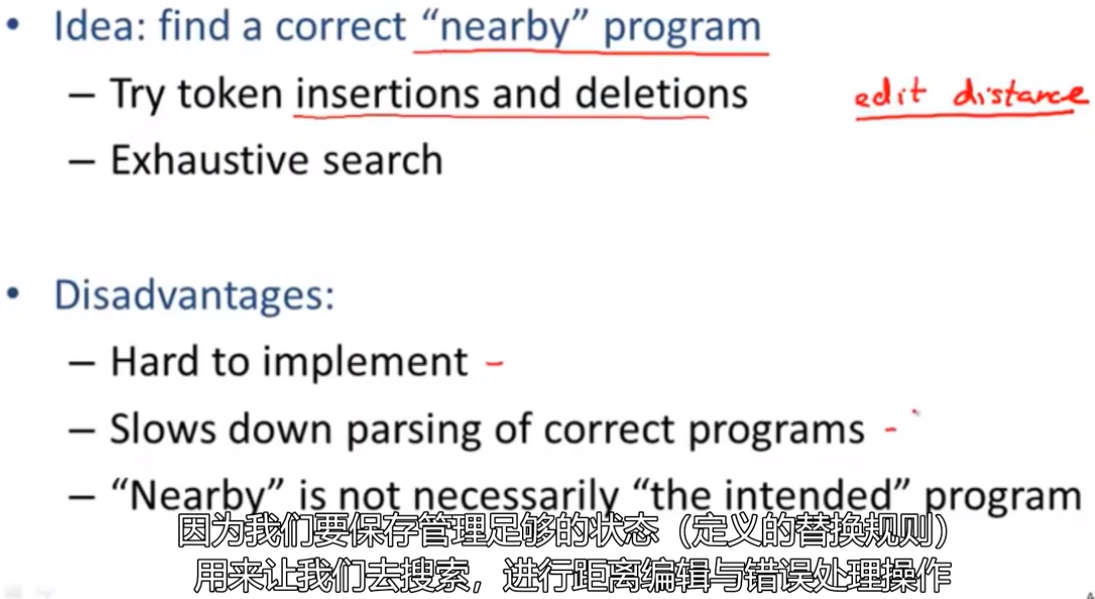
抽象语法树 Abstract Syntax Trees
- Like parse trees but ignore some details
- Abbreviated as AST (简称AST)

下图表示了上图相同的内容
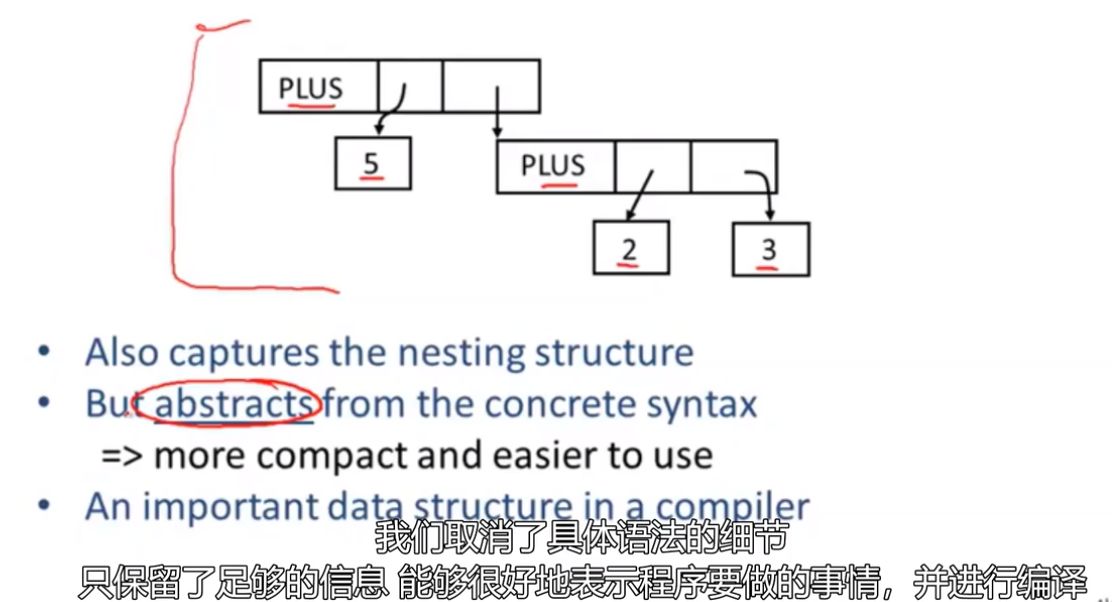
递归下降解析
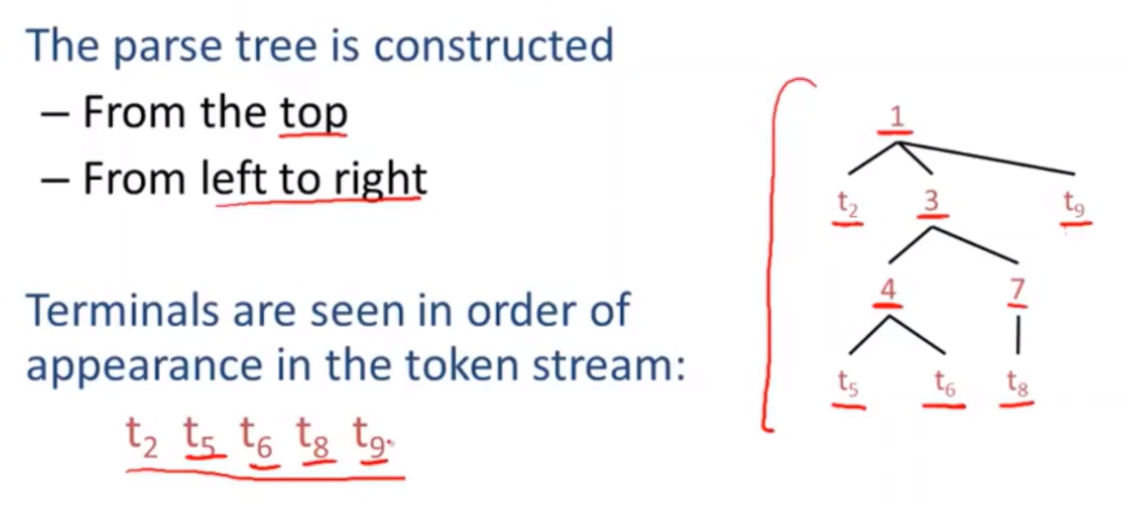
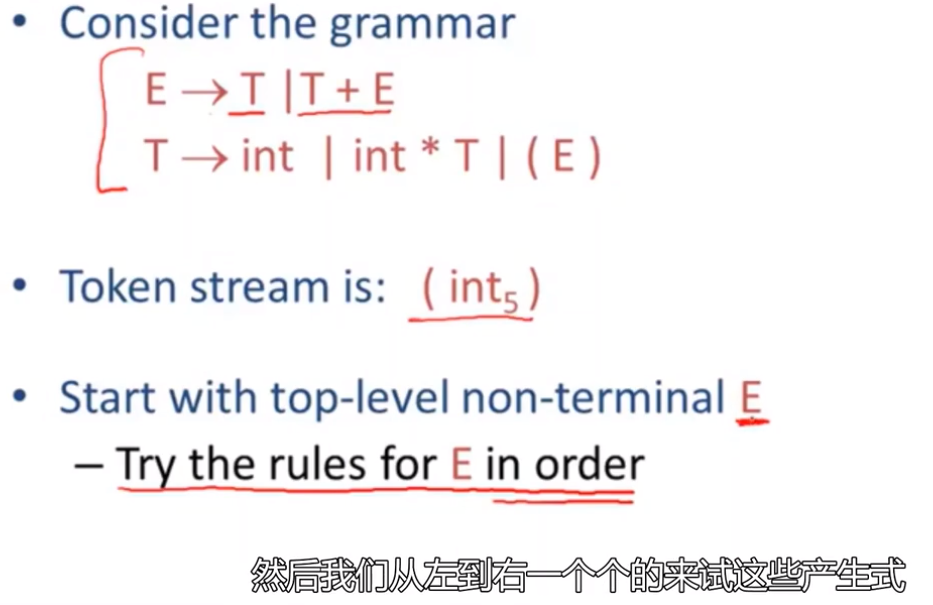
将E变成与(int)相同的格式使之可以匹配,则算解析成功,所以E->T->(E)->(int)
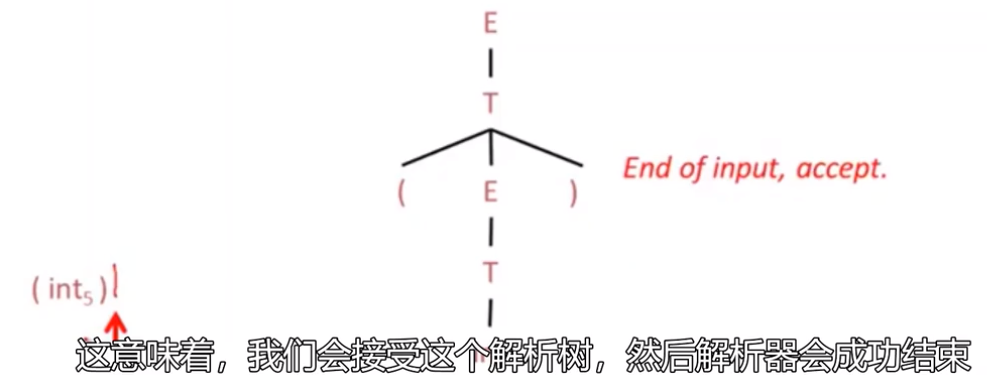
递归下降算法
- Let TOKEN be the type of tokens
- Special tokens INT, OPEN, CLOSE, PLUS, TIMES
- Let the global next point to the next input token
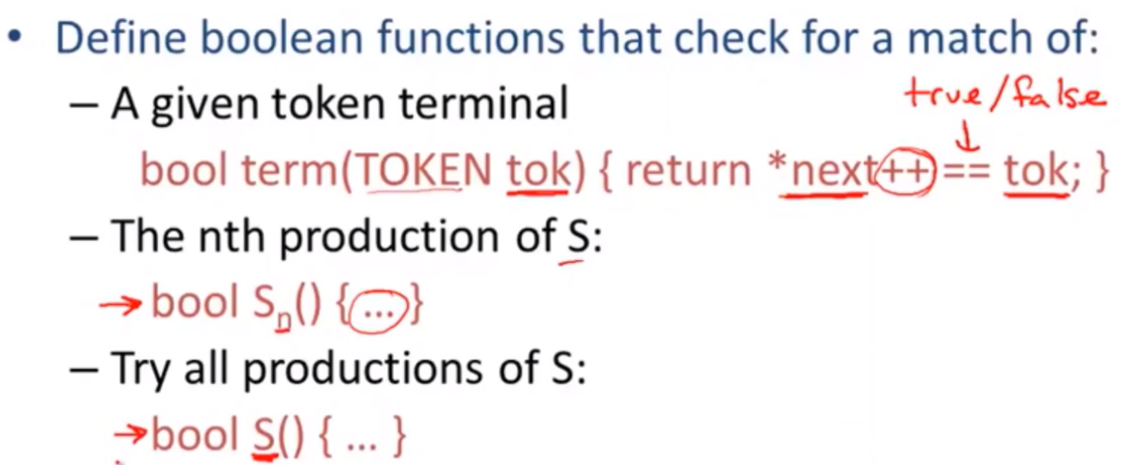
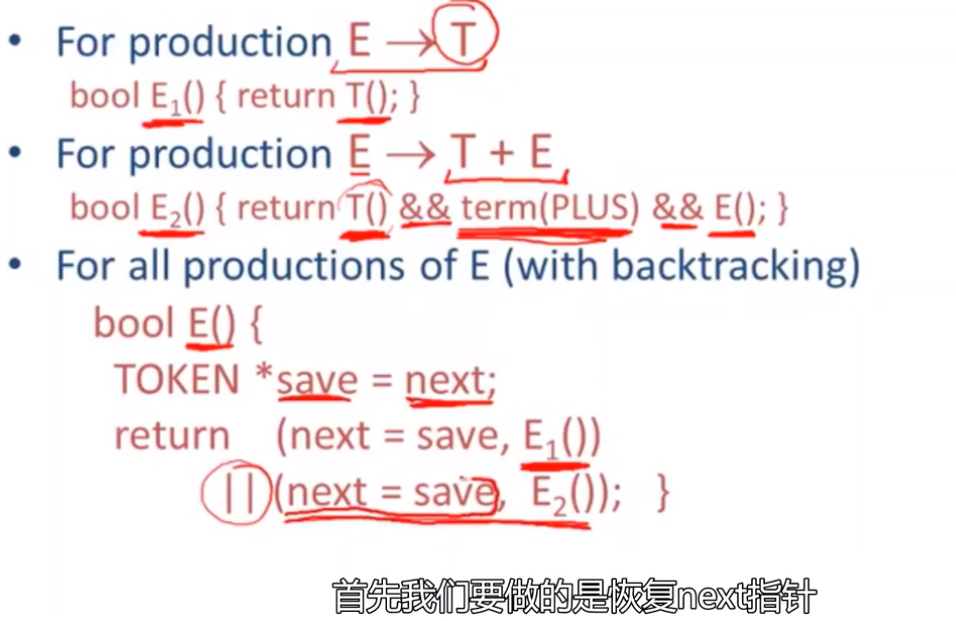
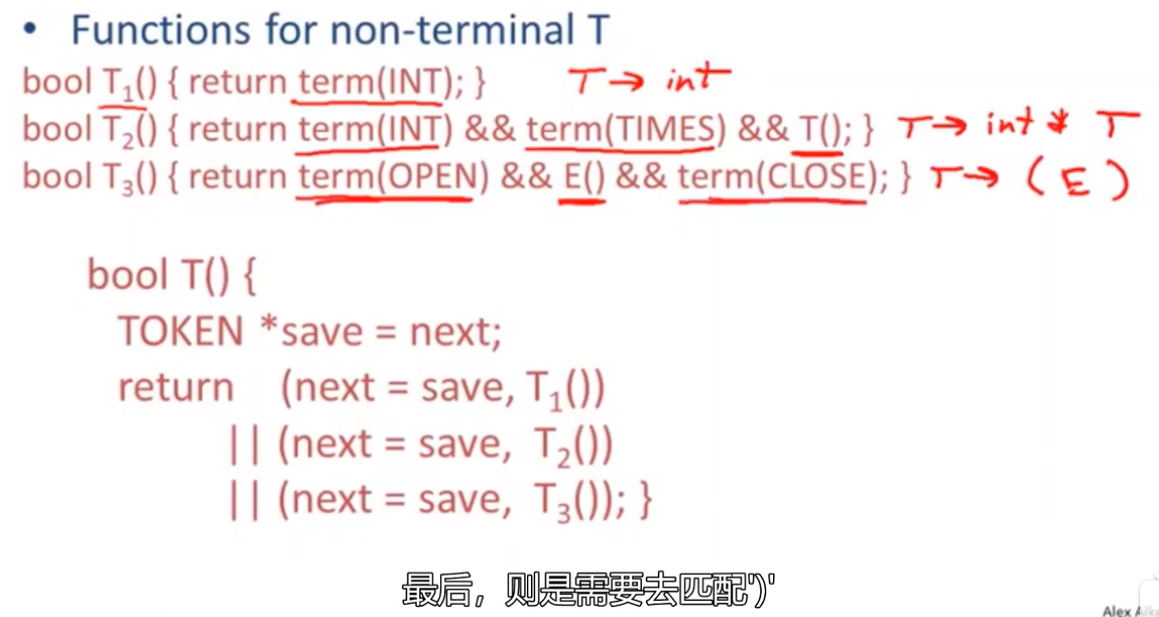
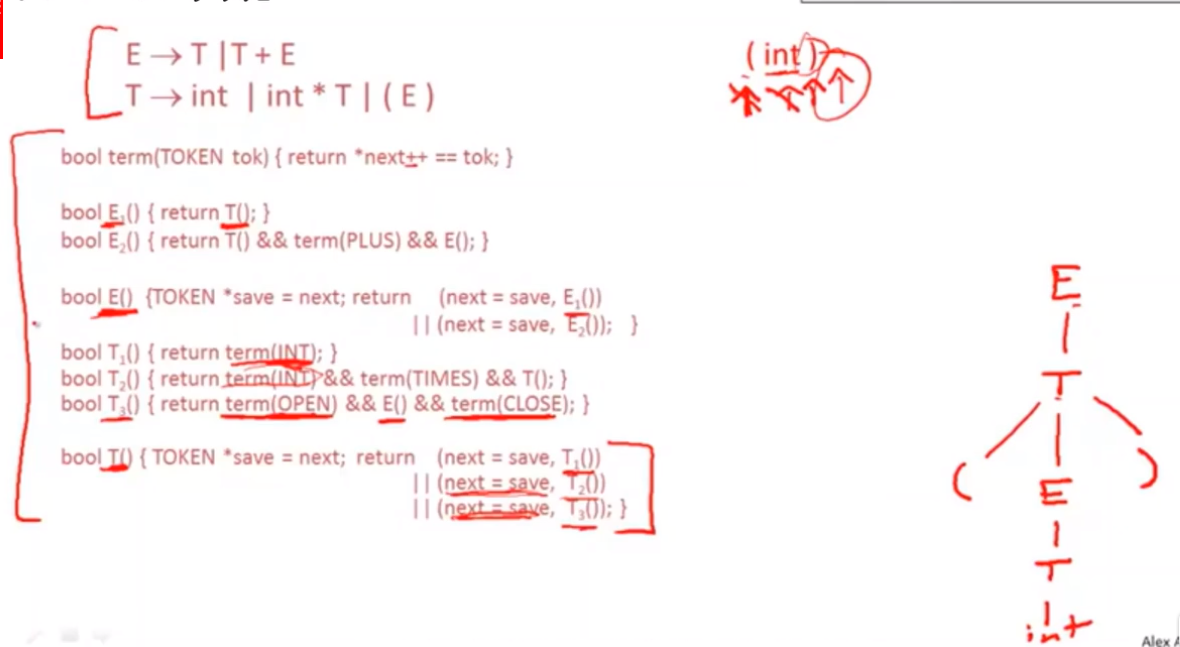
递归下降的局限性
- if a production for non-terminal X suceeds
- canno backtrack to try a different production for X later
- General recurisive-descent algorithms support such “full” backtracking
- Can implement any grammar
递归下降解析的主要难点-左递归 left recursion
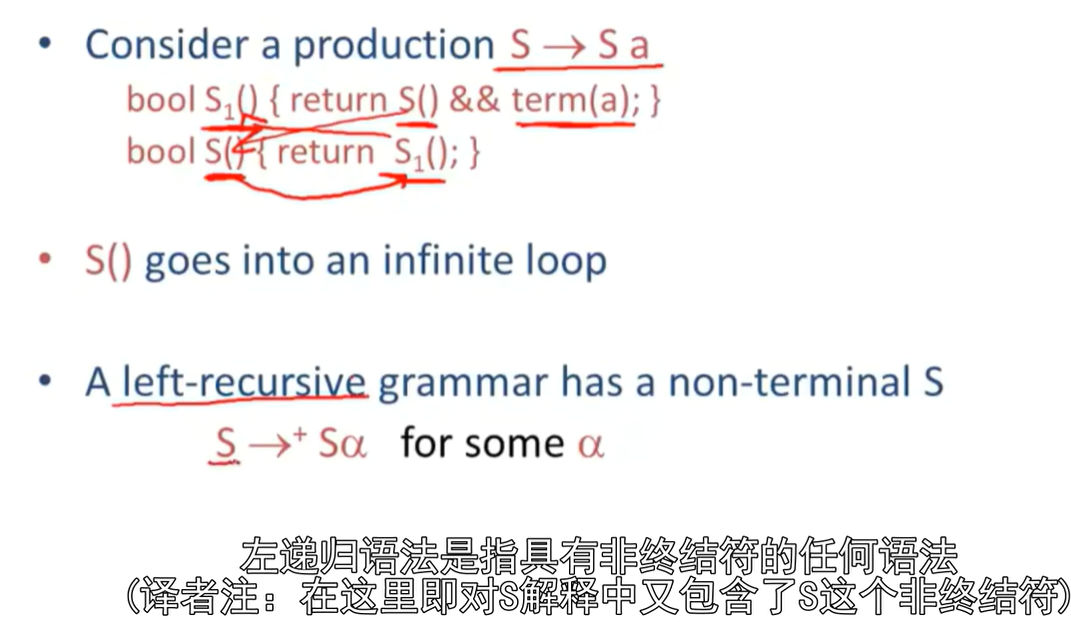
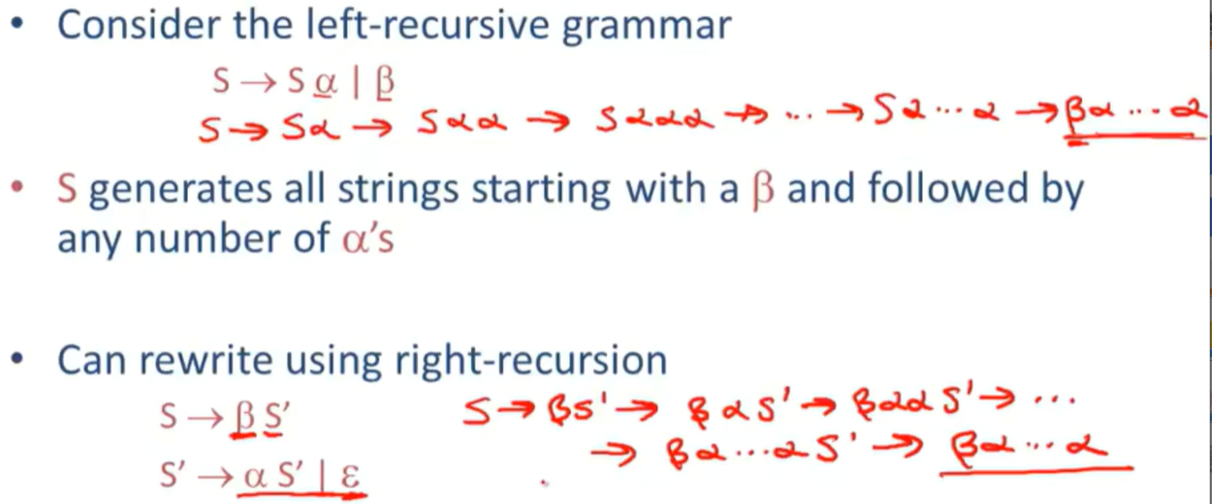
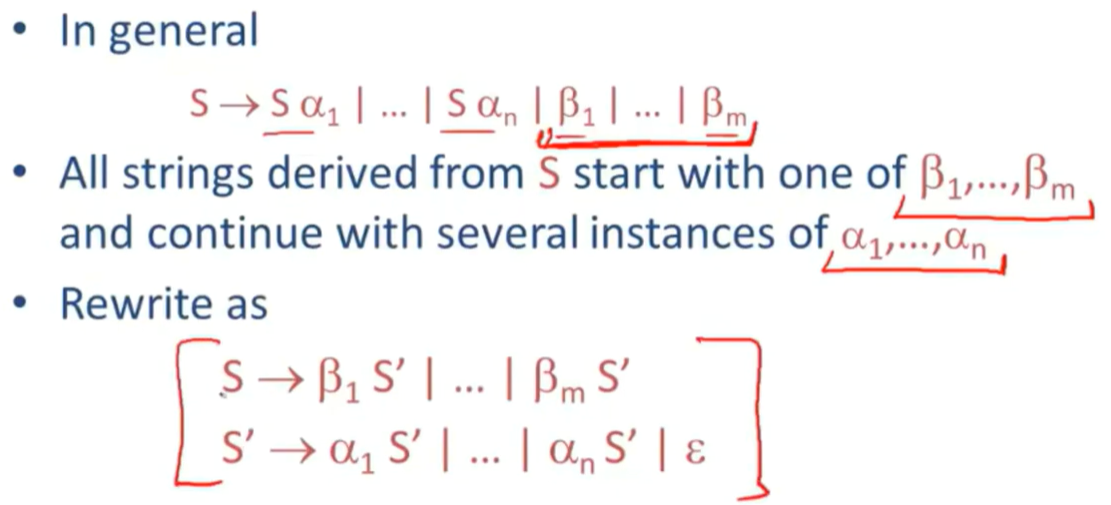
PA3
https://github.com/mrbelieve128/Stanford-Compilers-PA/tree/master/PA3
预测解析 Predictive Parsers
预测解析和递归下降很像,依然是自上而下,但能从不出错的预测该使用哪一个产生式,并得出正确的解析。
- 根据输入字符串中出现的内容,来尝试得出该使用哪个产生式。只适合语法形式很固定的情况
- 不需要回滚操作。解析器可以完全肯定要使用的产生式
接受 LL(K) 语法 (left-to-right 从左到右 left-most derivate 始终基于解析树上最左非终结符 k tokens lookahead)
如
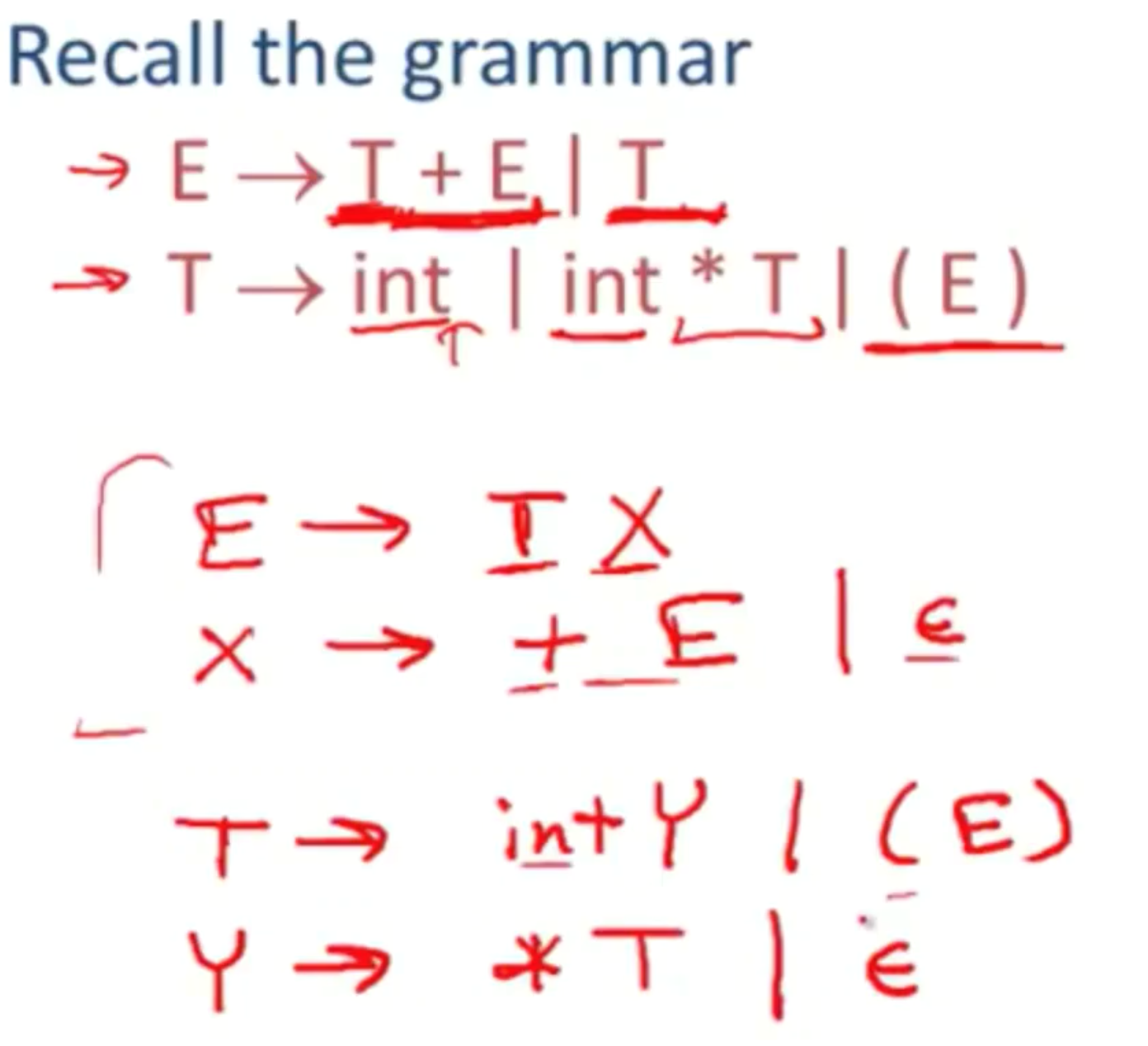
实际上是使用表格记录数据

使用栈记录边界
- 把最左终结符或非终结符始终放在栈顶
算法
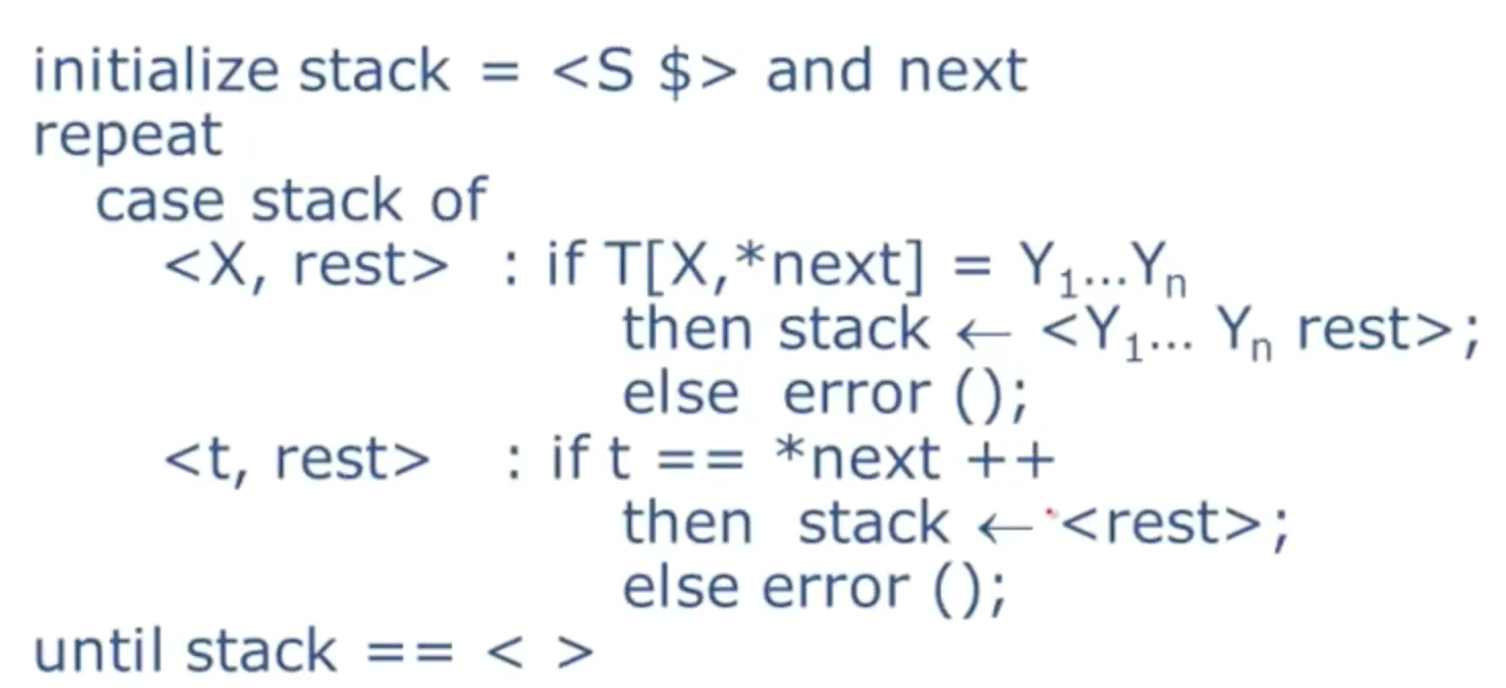
- 使用S和$初始化栈。
- $标记栈底,可以看作输入结束的标记。
- 如果栈顶是最左非终结符,根据解析表来查找非终结符为X和下一个输入字符所对应的产生式右手边内容,然后弹出栈顶的X。如果不符合就会报错,因为没有回滚操作,没有办法解析字符串。
- 如果栈顶是终结符的话,试着匹配输入,匹配成功就移动到下一个输入元素,然后弹出栈顶元素。如果不符合就会报错,因为没有回滚操作,没有办法解析字符串。

First集 First Sets
构建LL(1) 解析表
non-terminal A, input singal t
什么时候T[A,t] = α(意思是解析表上[A, T]这一单元格里的内容是α
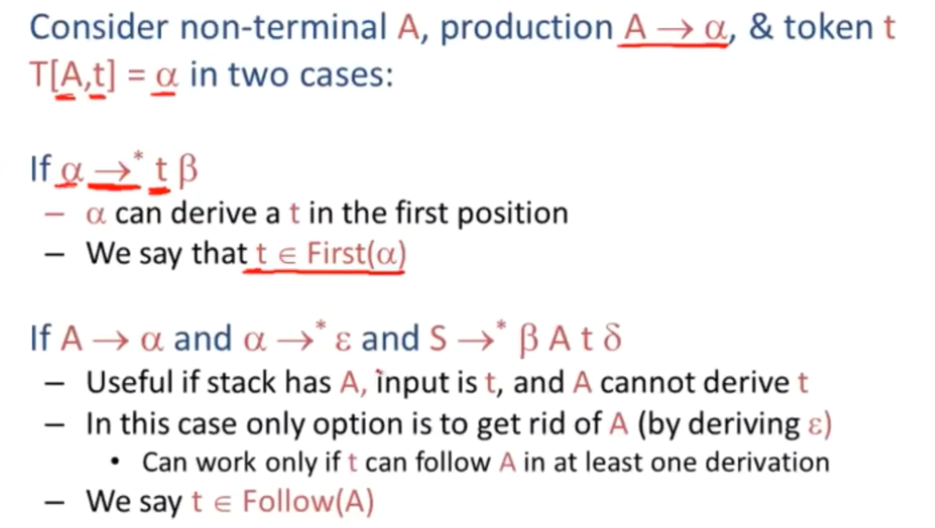
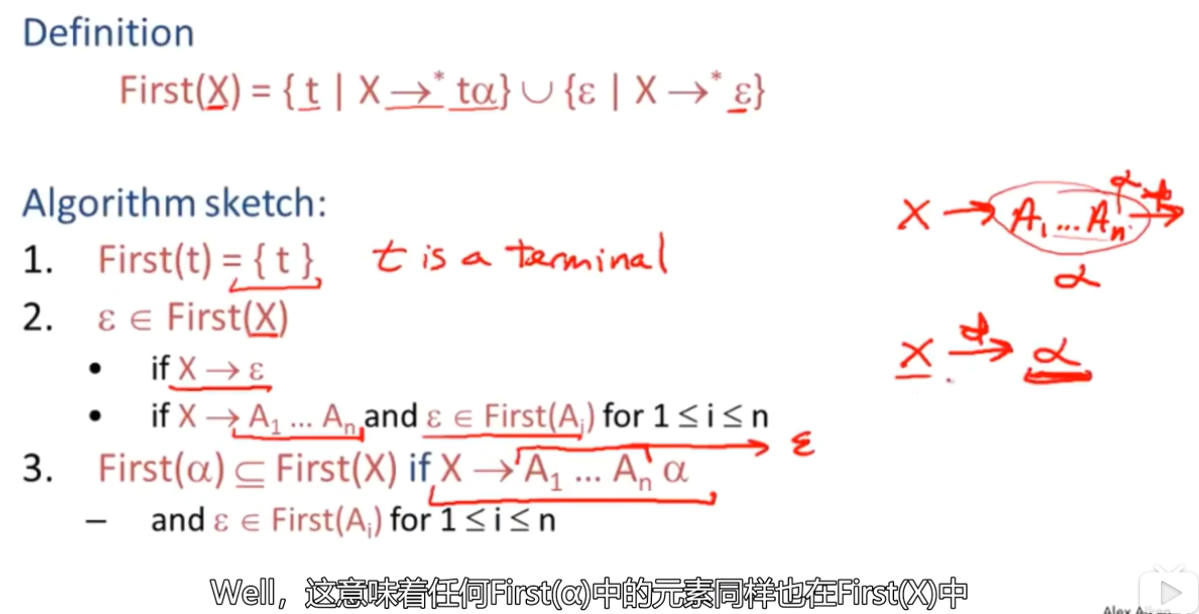
例子
左边是terminal的first集,只包含自身,右边是non-terminal的
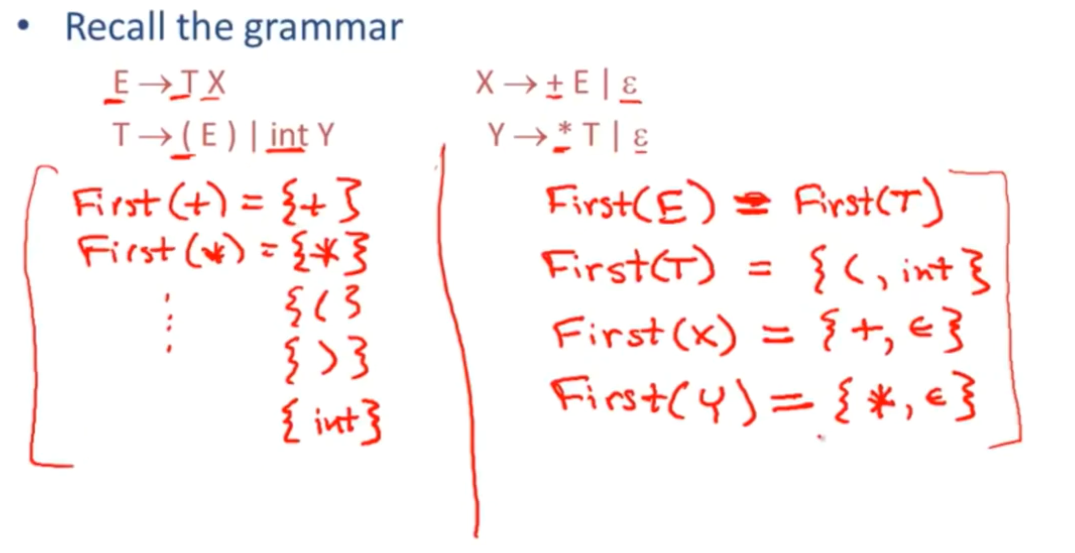
Follow集 Follow Sets
Follow集中的元素是那些被用到的元素而不是生成的符号。ε不会加进Follow集中

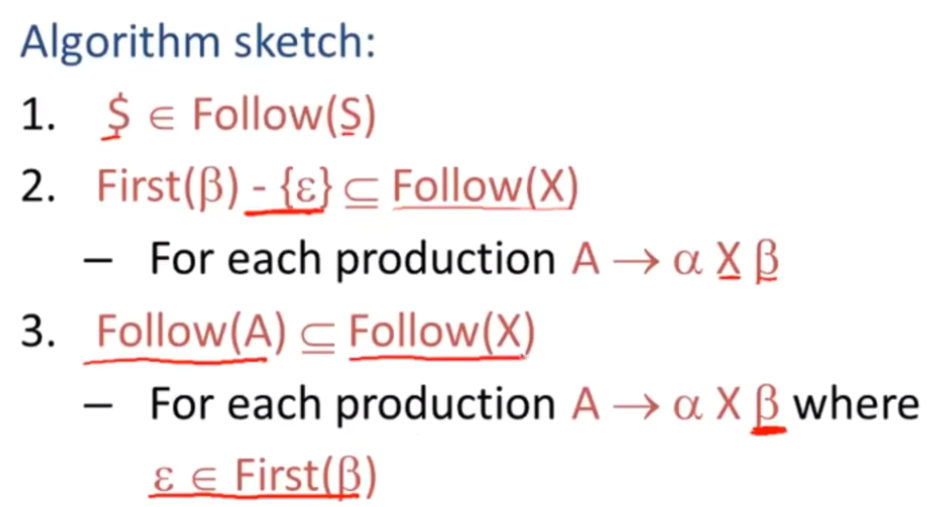
一些规则
出现在产生式右侧末尾的,如E -> TX Follow(E) 是Follow(X)的子集

而在E -> TX 中,X可以消除,所以Follow(E) 同样是Follow(T)中的元素
’ ( ‘的Follow集就是First(E)中所有元素,而First(E) = First(T)
Follow(’+’) = First(E)
Follow(int)因为可以Y可以变成ε,所以Follow(T)中的元素也会是Follow(int)中的元素
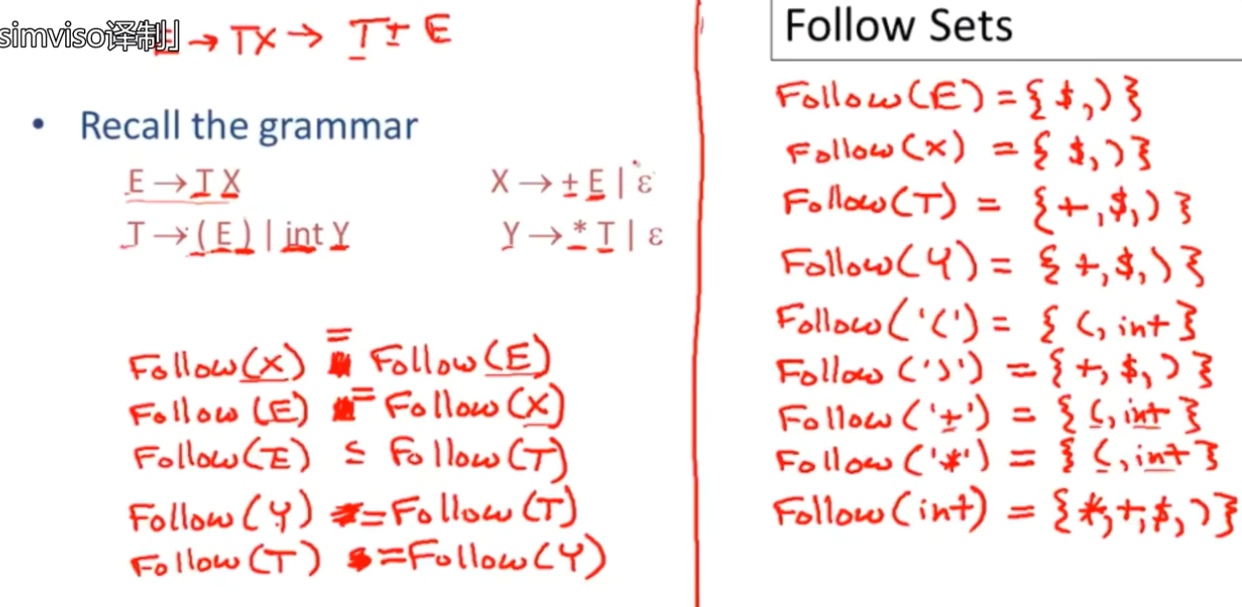
LL(1)解析表
目标是为上下文无关语法G构建出一个解析表T
语法/规则

例子
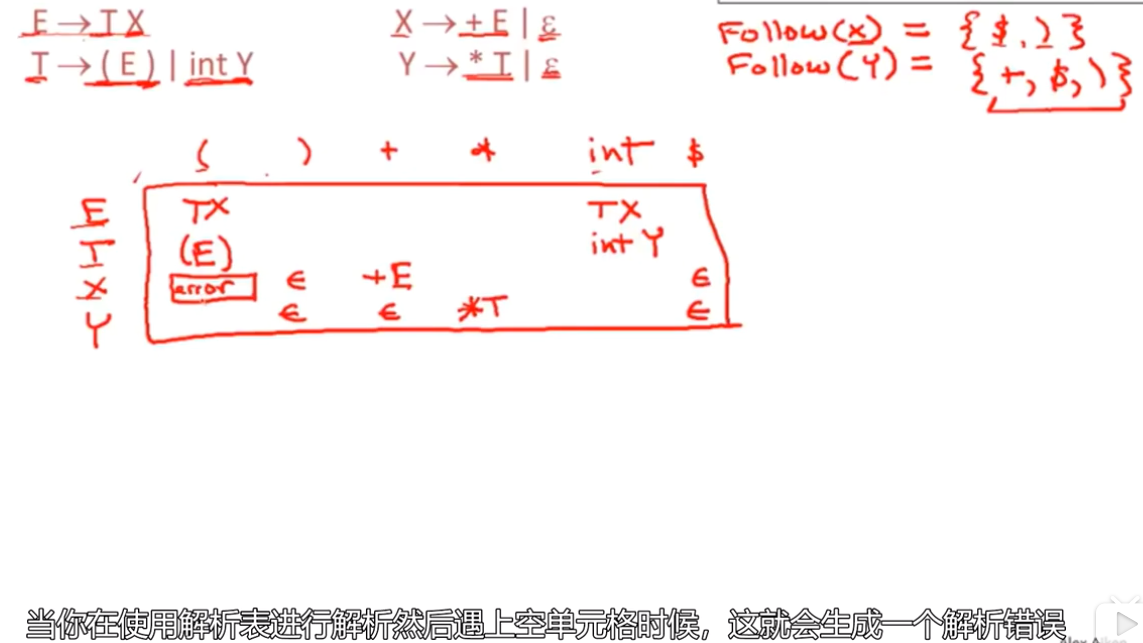
根据字母(非终结符)和符号(终结符)来预测和匹配完整的对应关系
构建完解析表的时候,如果表格内的某些单元格中有多种操作的话,每种情况下的操作就不是唯一的,这就不是LL(1)语法。

自下而上的解析 Bottom-Up Parsing
Bottom-Up 解析比top-down 递归下降解析 更通用,且同样高效
Bottom-Up是大部分解析生成工具所使用的一种首选方法
- 不需要提取左因子语法
- 回归到“正常”语法,但仍然需要对**+号和号*的优先权进行编码
- 不会处理语义混淆的语法
Bottom-Up解析 会进行归约,既通过反转产生式,逆向替换,将字符串规约为起始符号
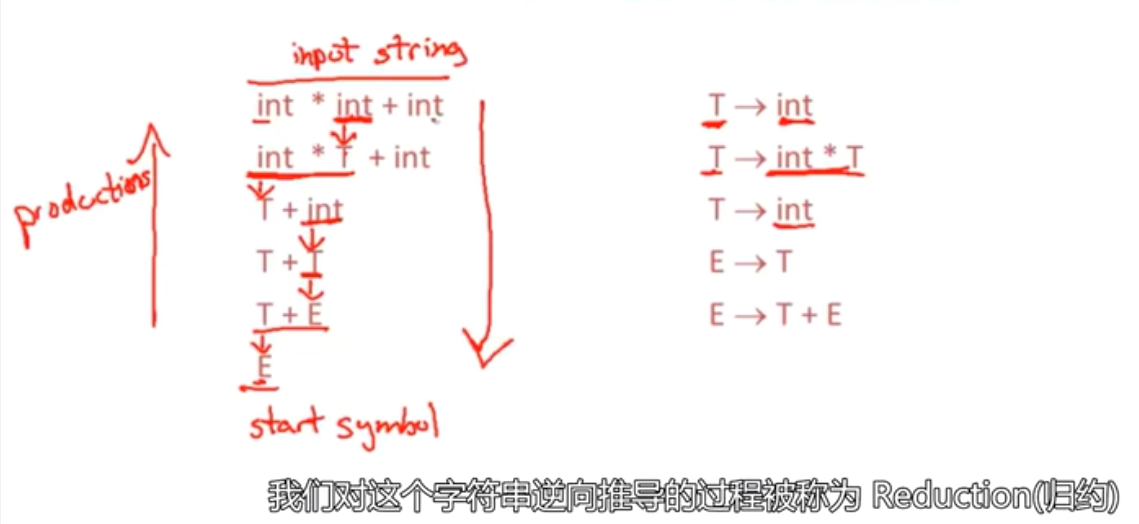
从下往上看,是最右推导
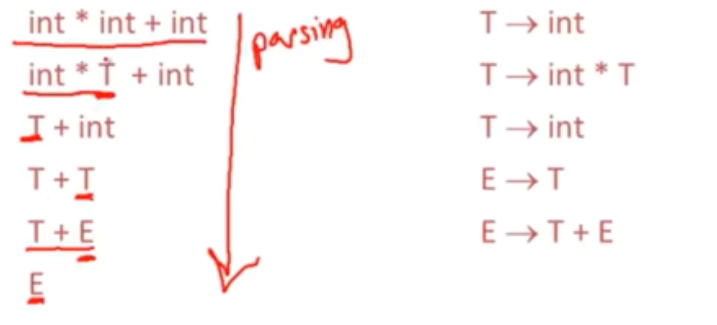
解析树,也是从下往上生成的
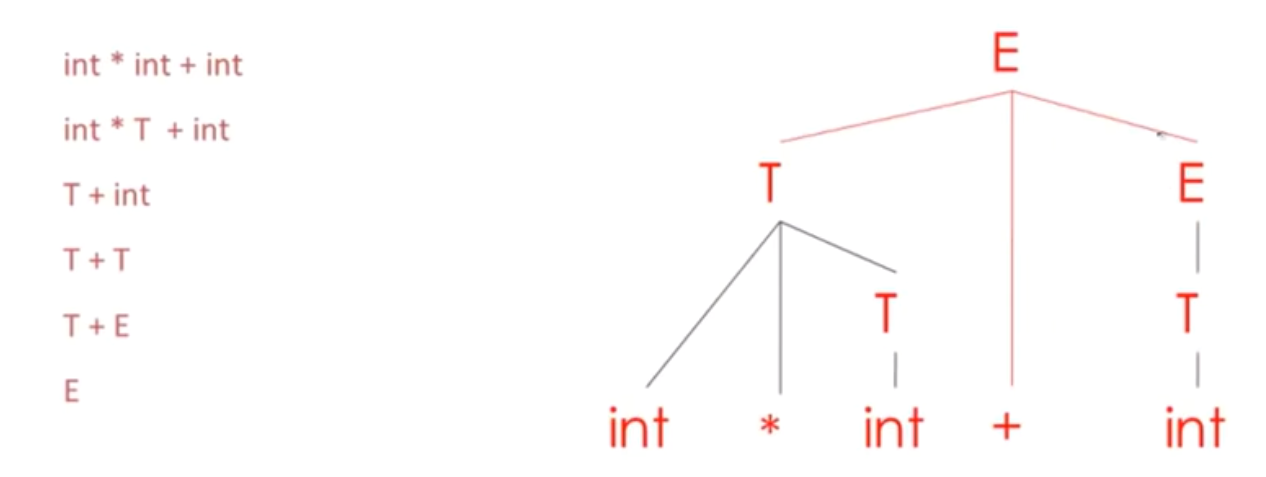
移位规约解析 Shift Reduce Parsing
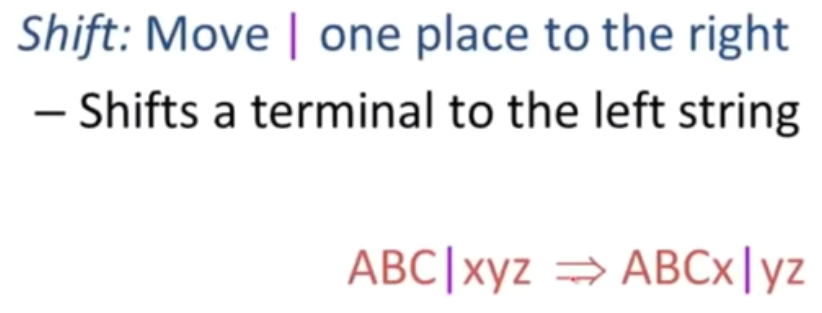
在执行规约操作前,始终得需要得到足够多的输入(移位足够多次)
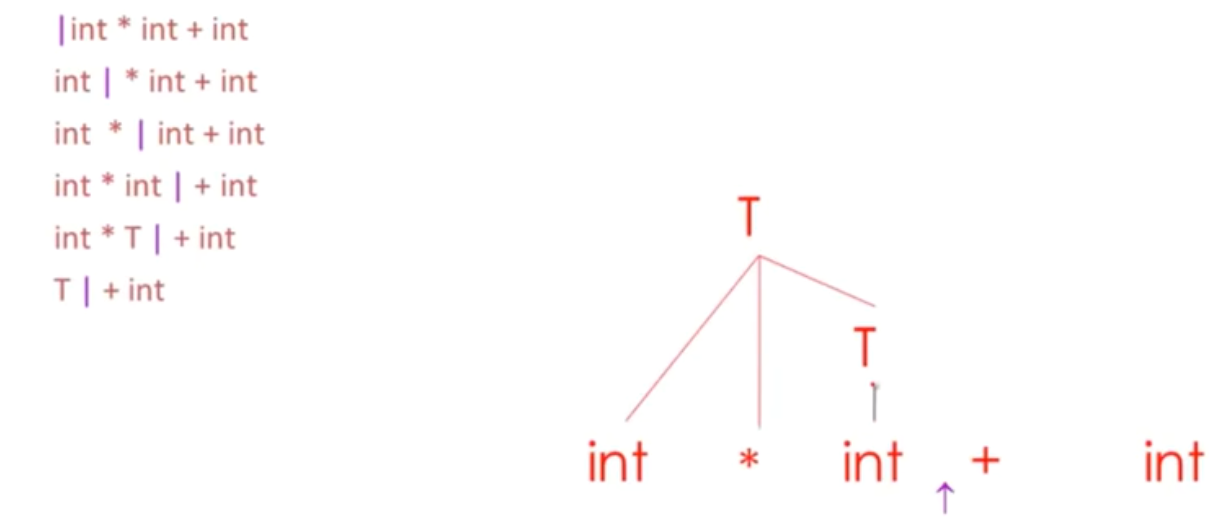
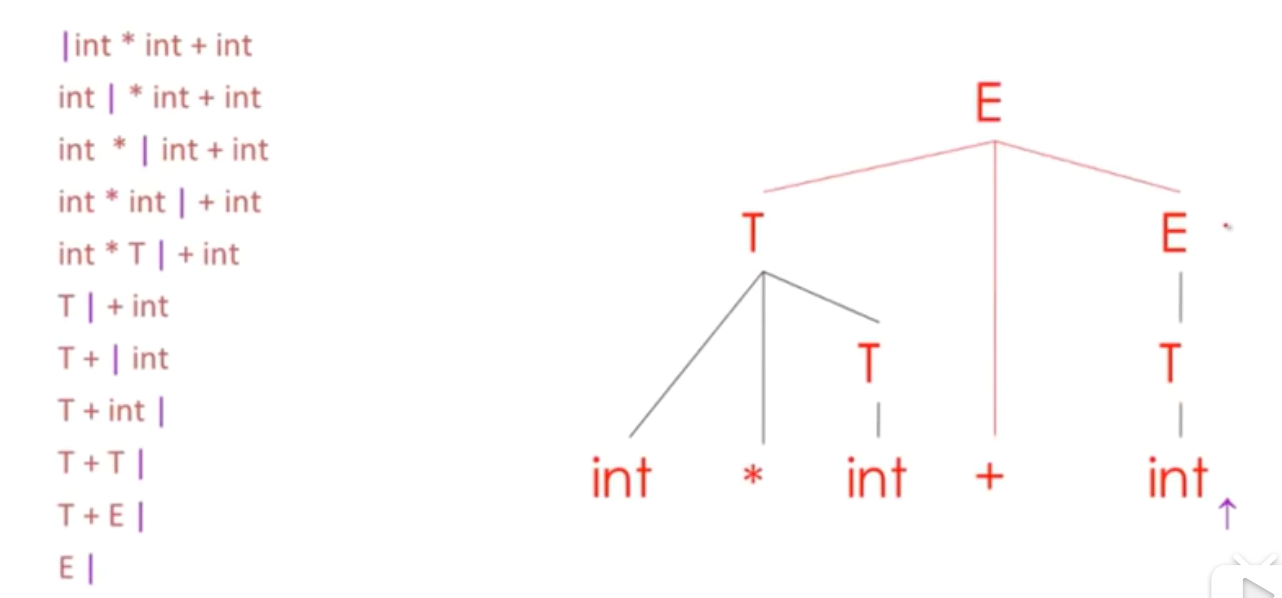
- 竖线左边的字符串能够由一个栈实现,栈顶就是那个竖线的位置
- Shift移位操作会push一个terminal进入栈
- 规约操作,将一些符号弹出栈,这些是产生式右手边的内容。接着会把一个非终结符压入栈中,这歌非终结符是产生式左手边的内容
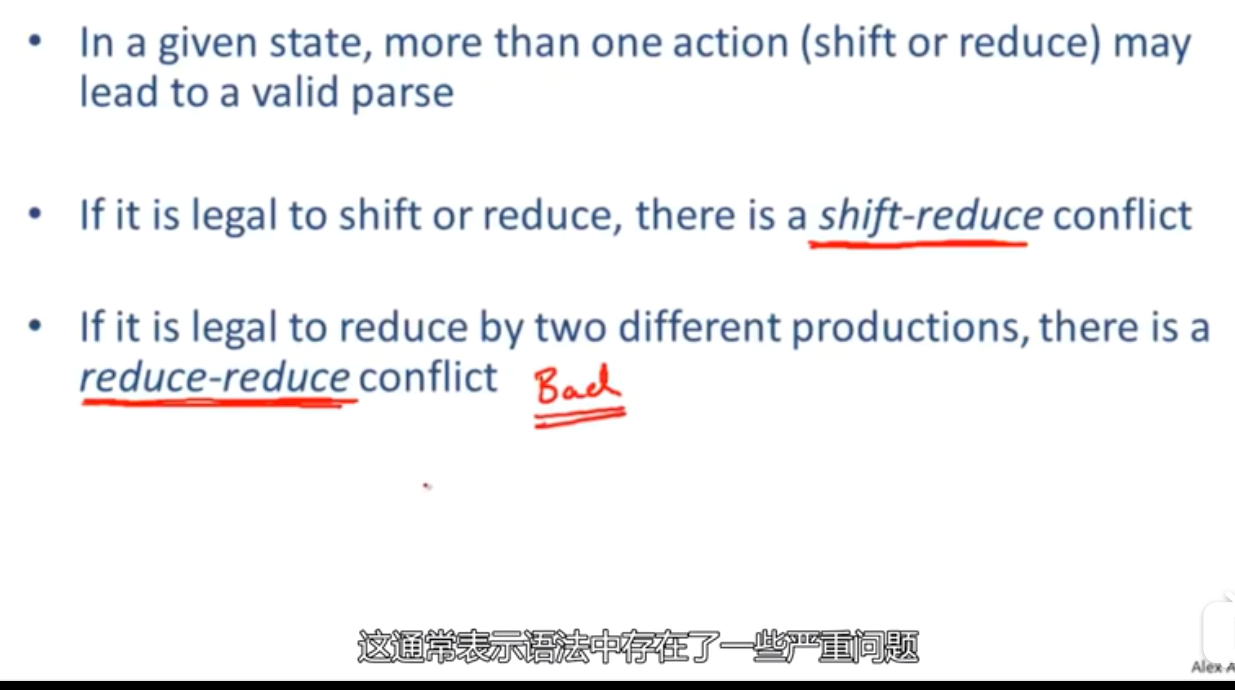
句柄 Handles
句柄就是一个规约点,可以允许解析器通过进一步的规约操作回到开始符号位置。(句柄就是包含了一个可规约的操作路径)
在shift-reduce解析中,句柄只会出现在栈顶
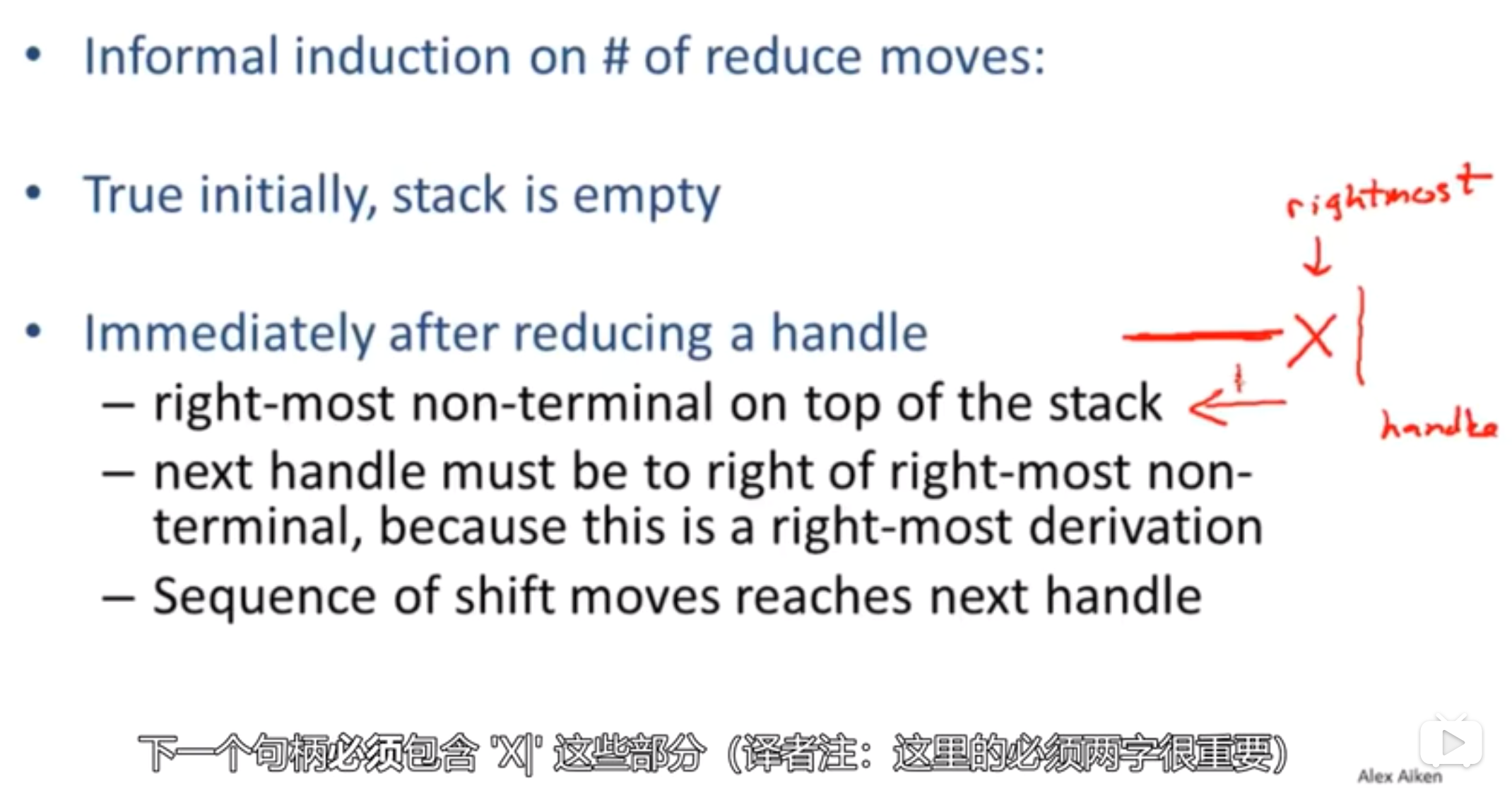
句柄识别
L代表从左到右扫描,R代表最右推导,K代表了需要向前看k个数量的token
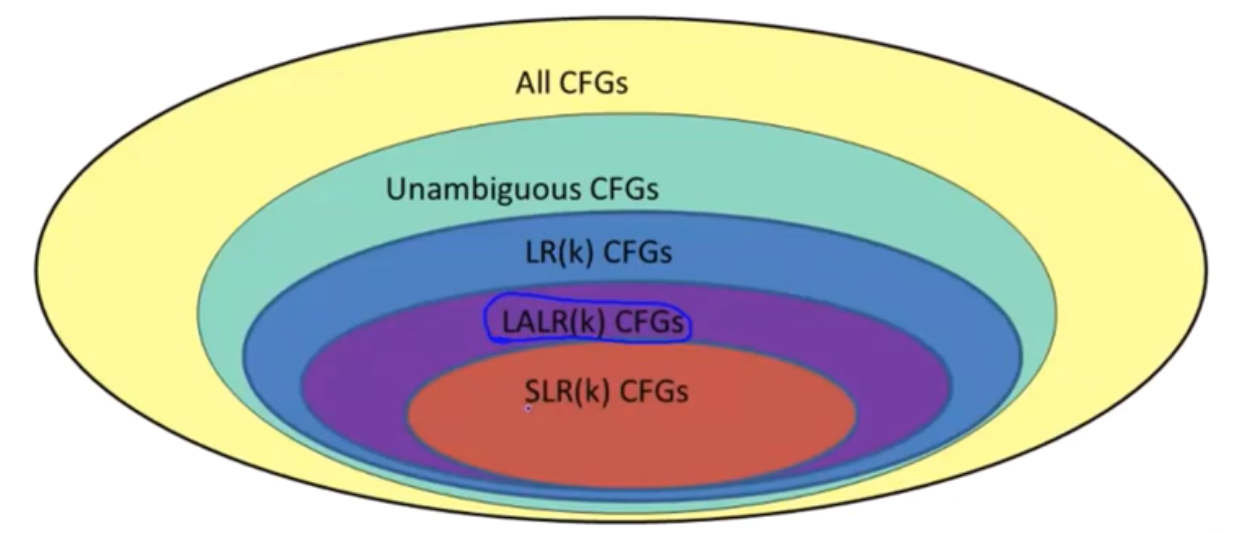

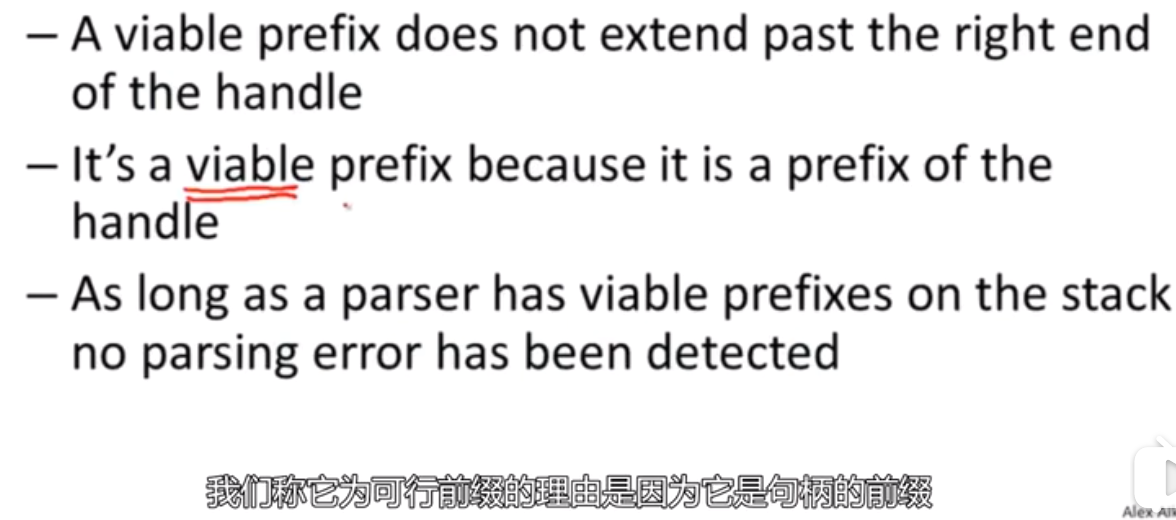
对于任何语法来说,可行前缀集就是一个正则语言
item是指一个产生式右手边某处存在的一个’ . ‘,如 T -> (E) 的item包含 T -> .(E) T -> (.E) T -> (E.) T -> (E).
而 X -> ε 的item是 X -> .
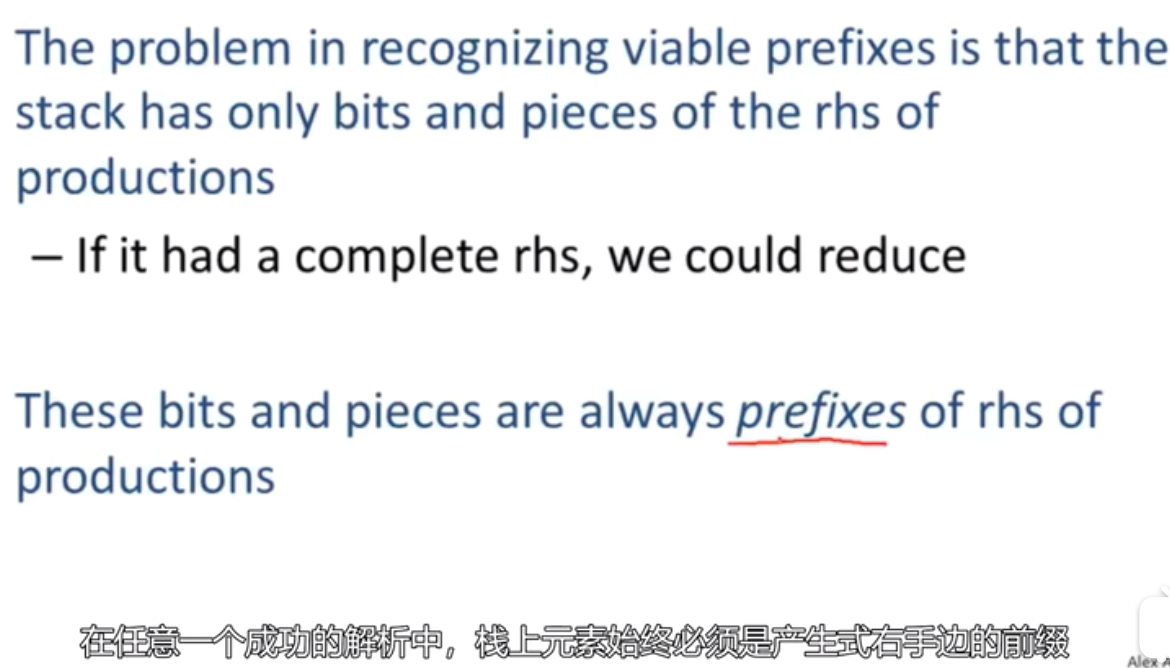
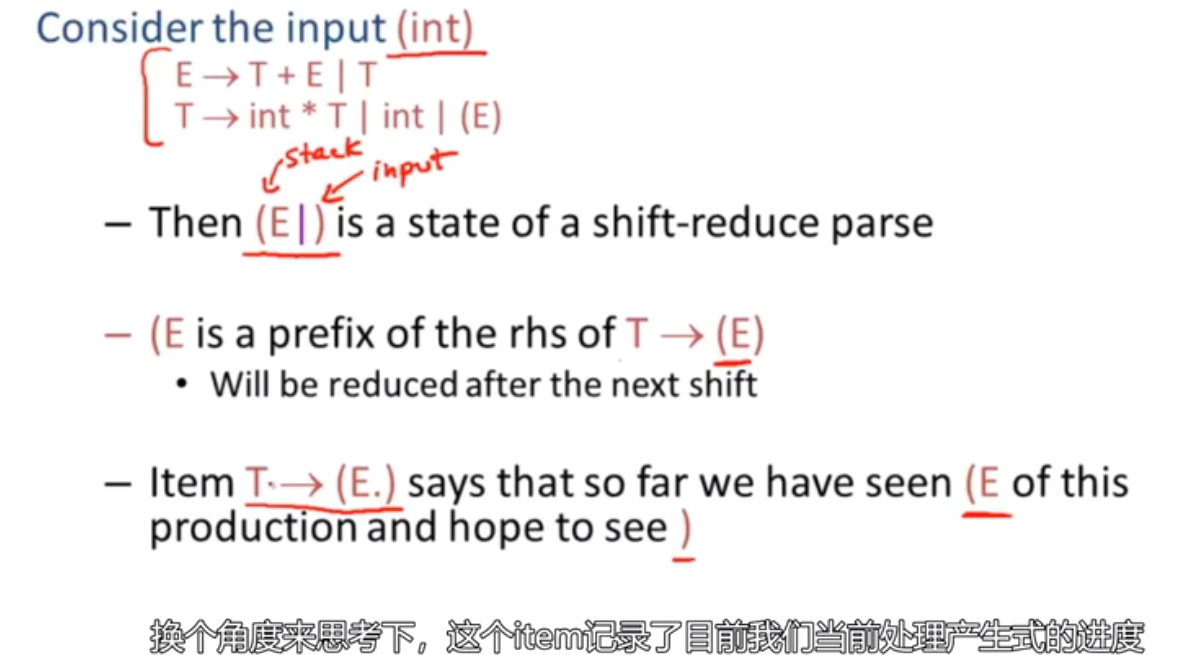
’ . ‘左侧的内容是见过的,即栈内元素。右侧元素则是在进行规约操作前想要读取的内容。
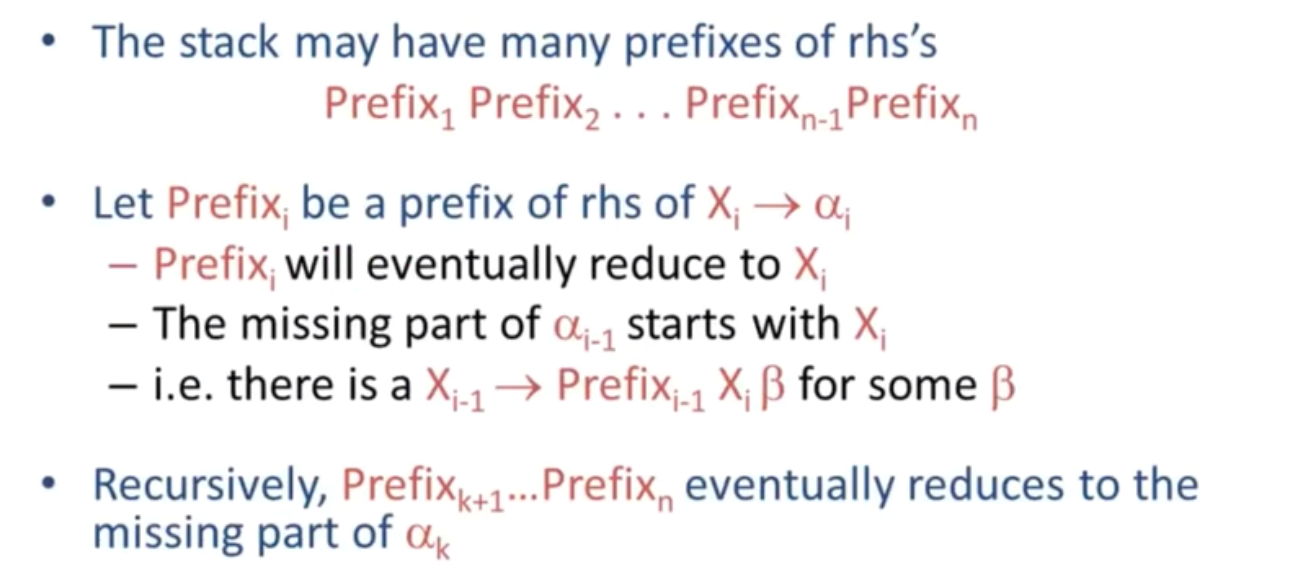
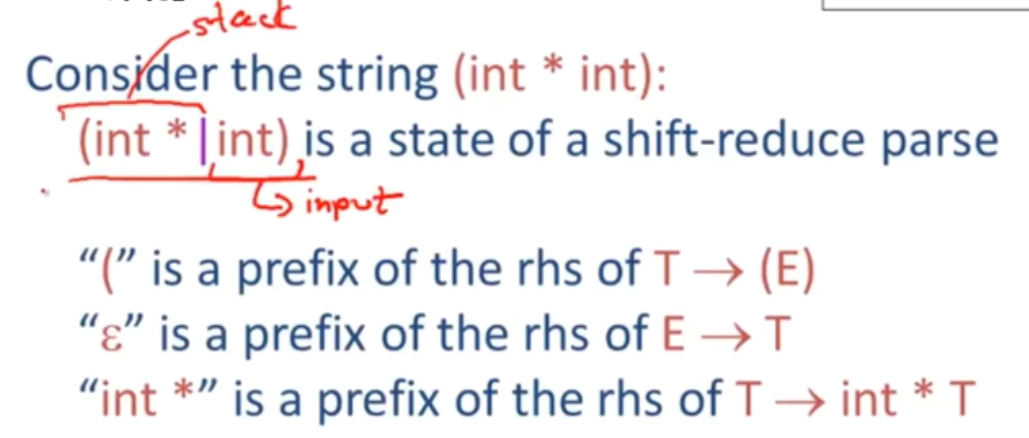
从底向上开始处理
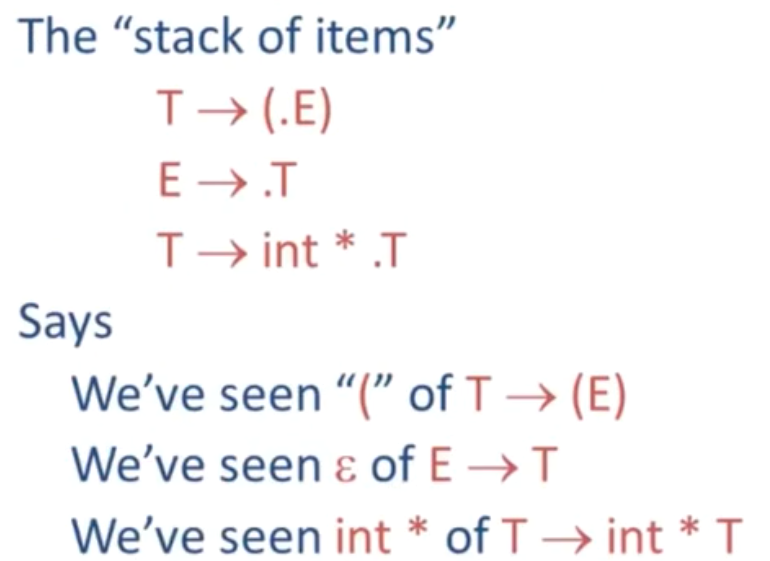
识别可行前缀 Recognizing Viable Prefixes
目标是去写一个非确定性有限自动机来识别解析器中有效的栈
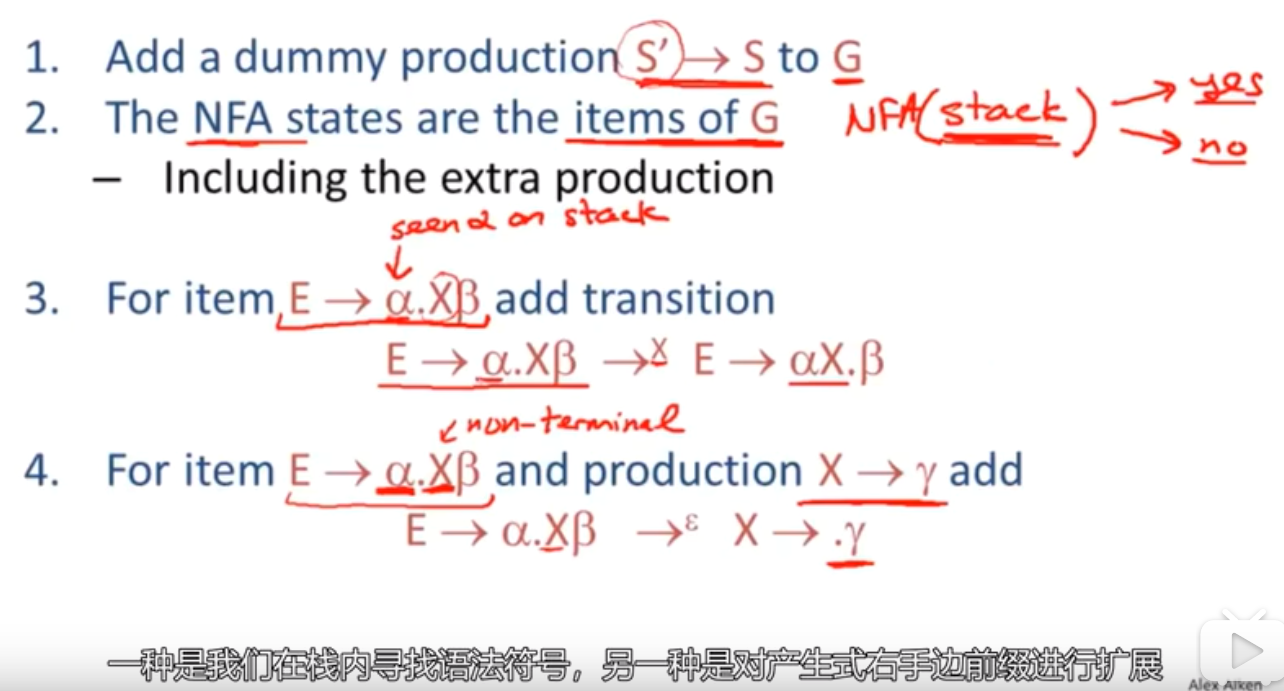
感觉是推算所有的可能性
有效item Valid items
The states of the DFA are “canonical collections of items” or “canonical collections of LR(0) items”
定义
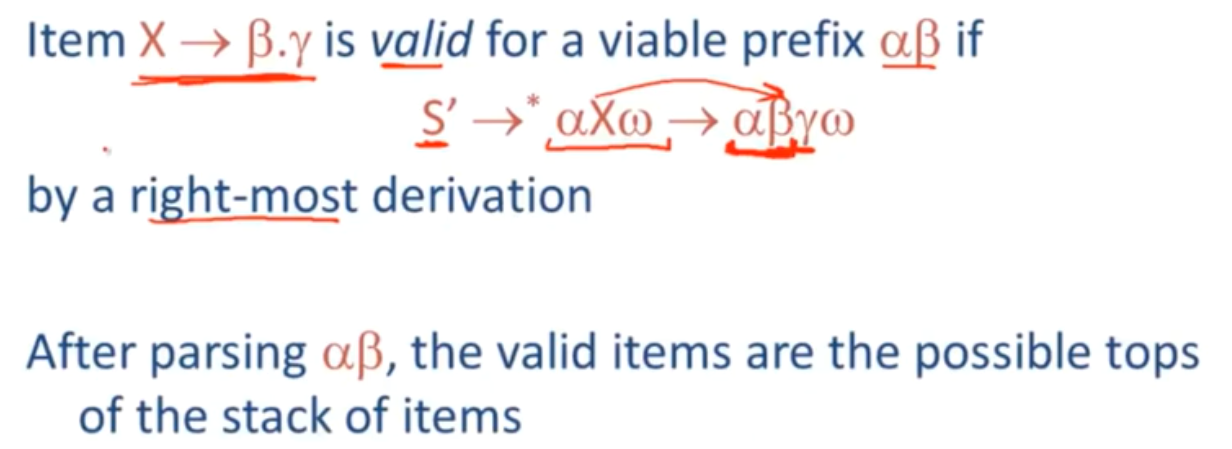
简化地说

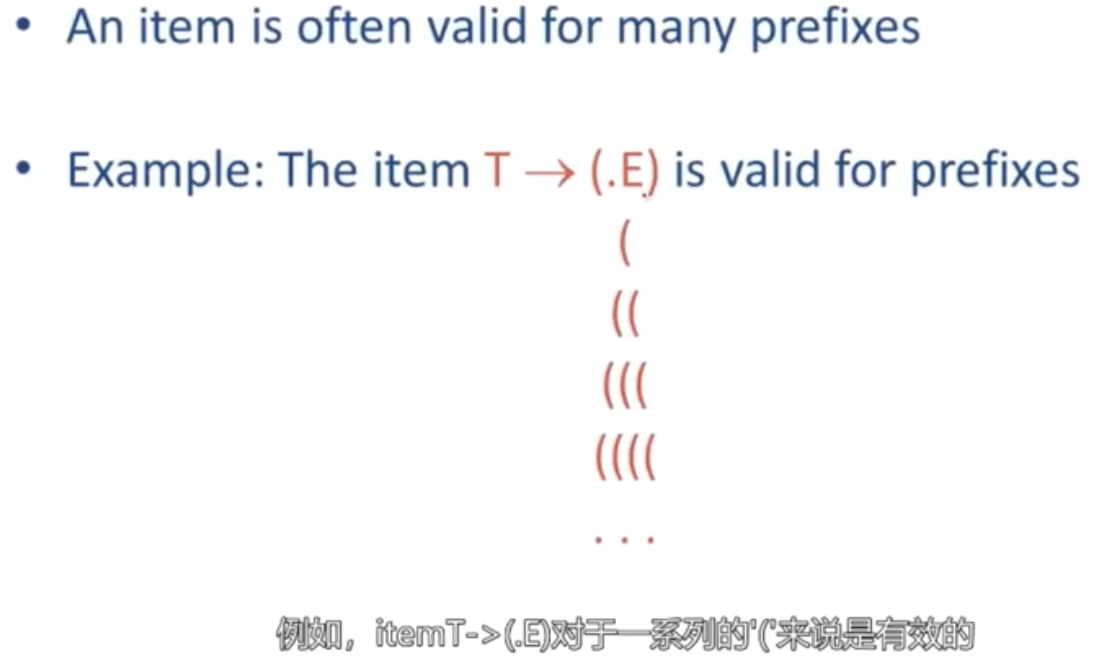
语义分析 Semantic Analysis
语义分析简介
为什么需要单独一个语义分析阶段?
- 编程语言会有一些特征,人可能会犯一些解析无法捕获的错误
- 一些语言结构并非上下文无关
语义分析实际上做什么
如coolc的检查列表
- 所有标识符被声明,作用域是否规范
- 类型检查(主要功能)
- 继承关系是否有意义
- 类仅定义一次
- 类中方法也只被定义一次
- 不滥用保留的关键字标识符
- ……
Scope
目标: 将用法和声明相匹配
静态分析在大多数语言中都相当重要
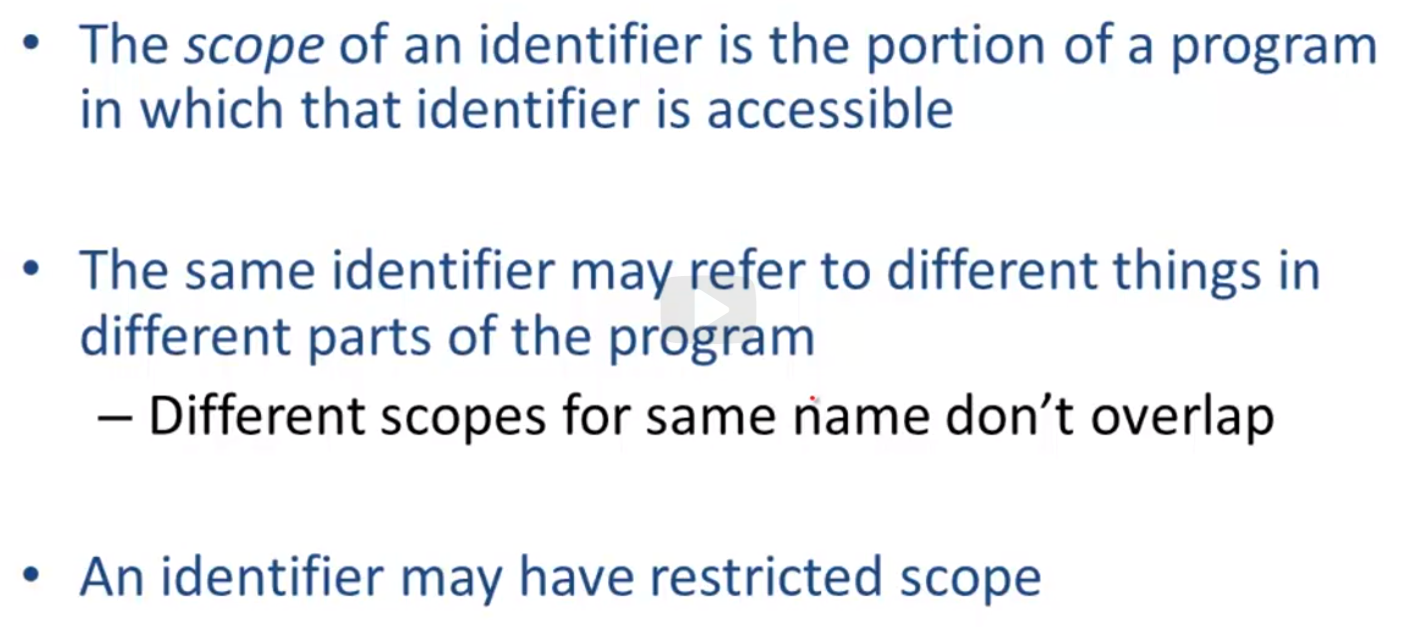
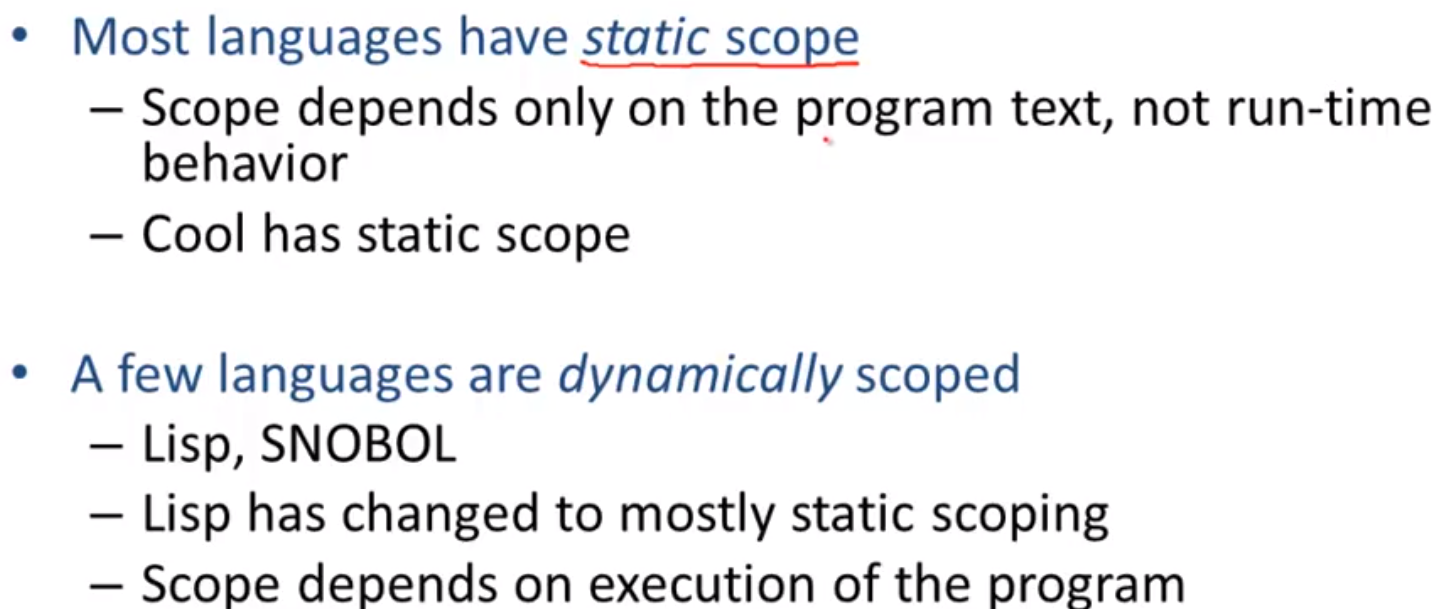
在下面例子中,对于X可能会有歧义,则使用最近嵌套规则 most closely nested rule
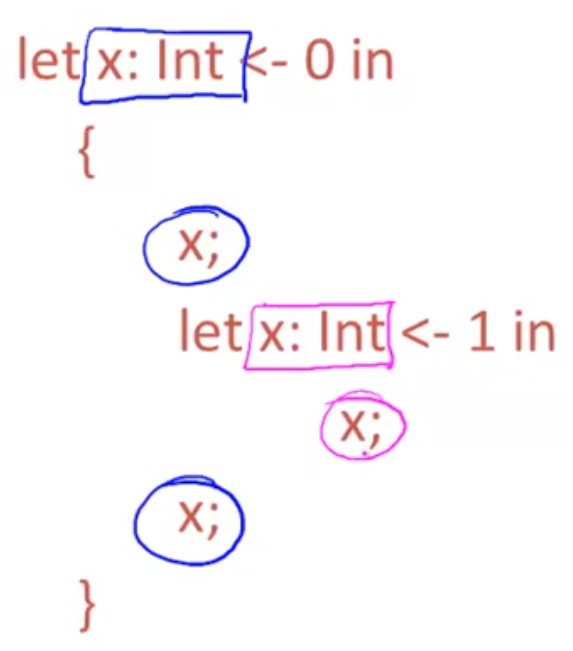
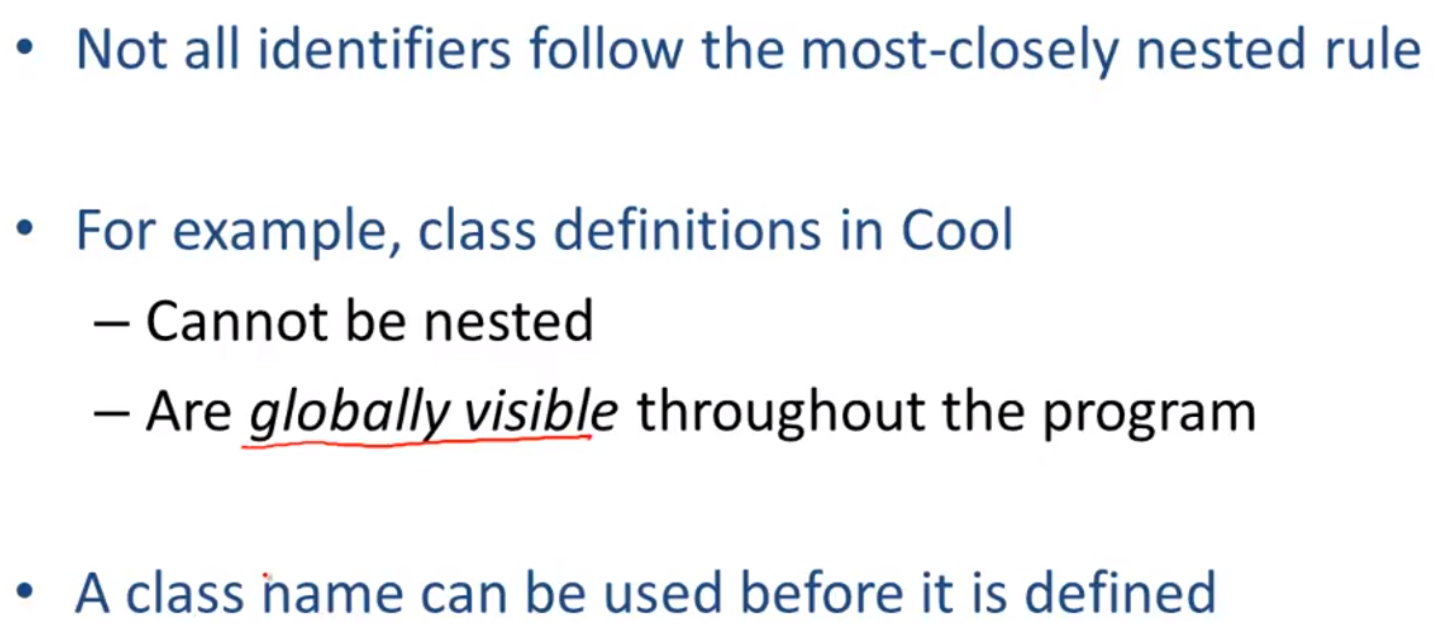
Symbol Tables
在许多编译器中的一种重要的数据结构
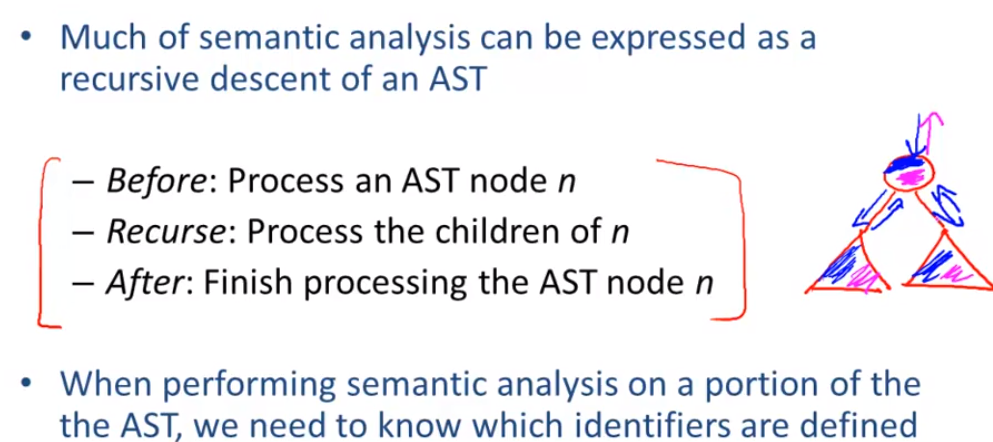
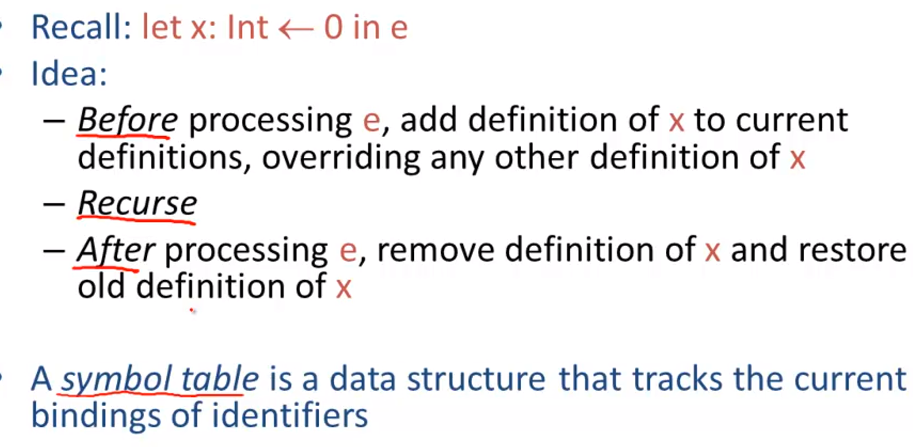
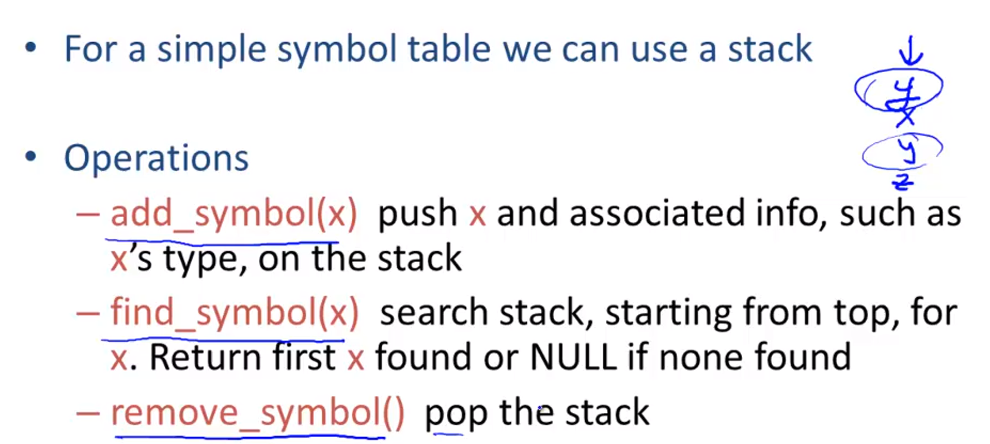
会先找最近的Y(也就是最新定义的)
而在下述错误示范中,为了解决这个问题
f(x:INT, x:INT)
{}
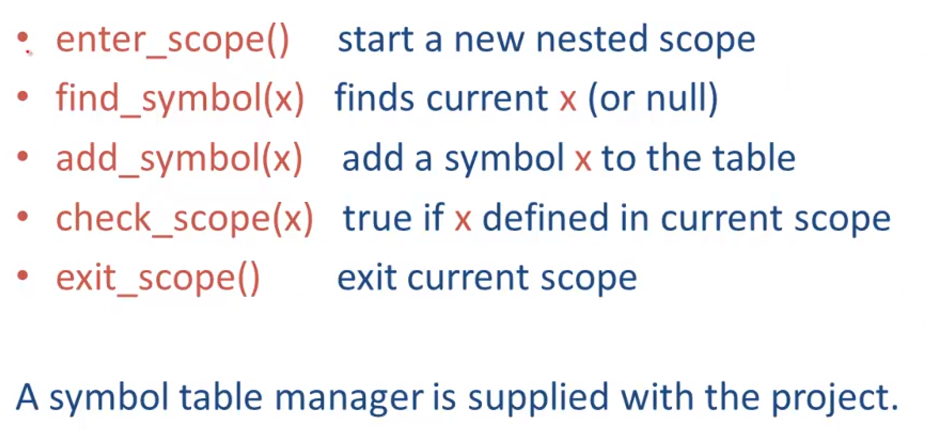
check_scope直到x处在栈顶才返回true
因为cool中可以,class名先用再定义,所以不可能通过symbol table或在一次检查中检查完class名
解决办法
- 第一次检查:记录所有的class名
- 第二次检查:检测
语义分析通常要求多次检查,而且经常大于两次检查。
Types
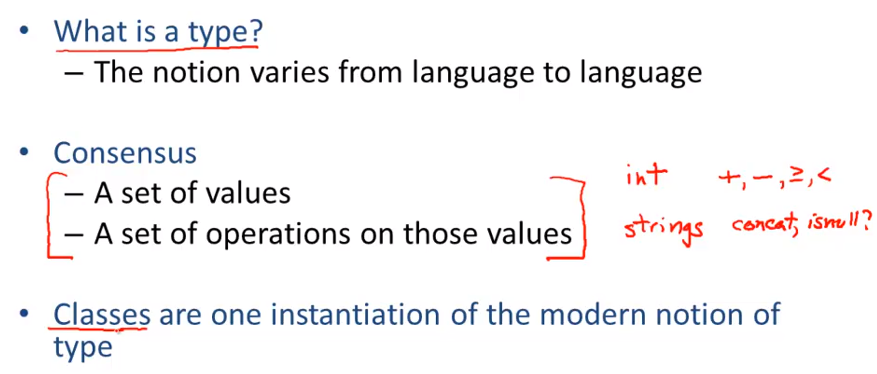
一种语言的type system定义了哪些类型能使用哪些操作符,目标是操作符只被正确的类型使用
目前,有三种类型语言:
- 静态类型:编译的时候就检测类型
- 动态类型:直到执行代码才检测类型
- untyped:没有类型检测(机器代码 )
静态类型喝动态类型的看法
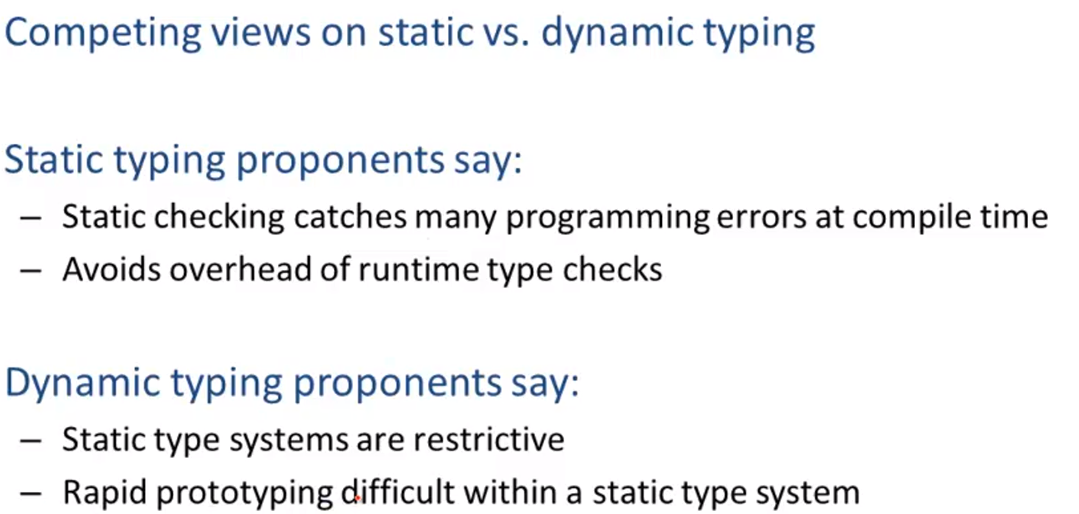
Type Checking


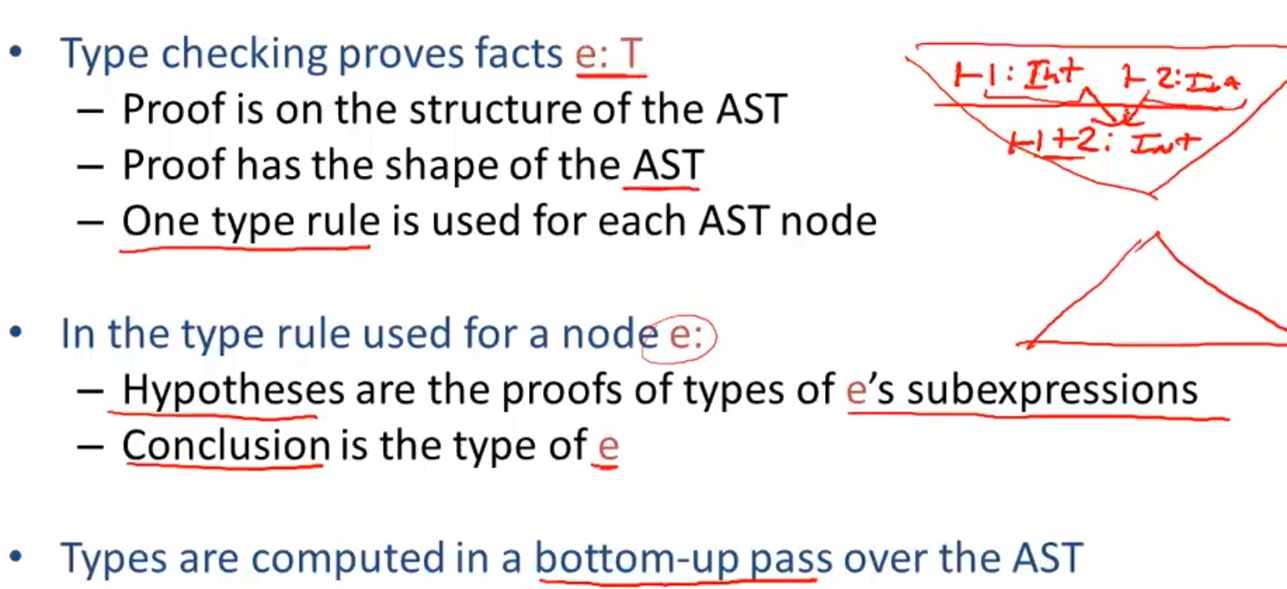
Type Environments

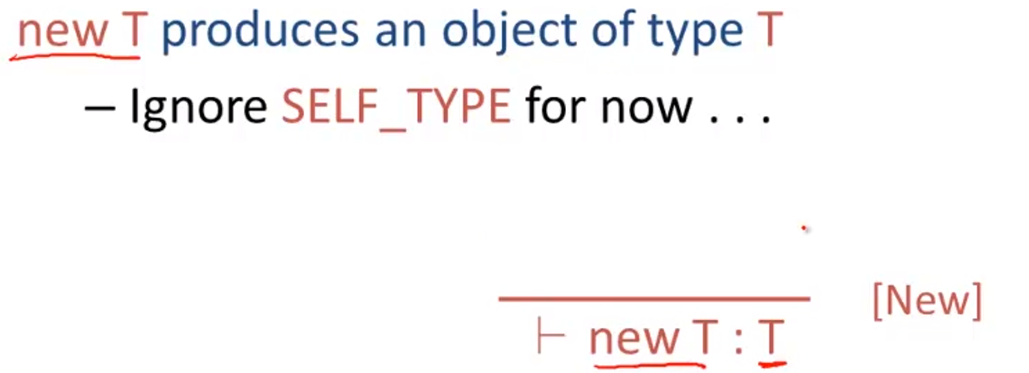
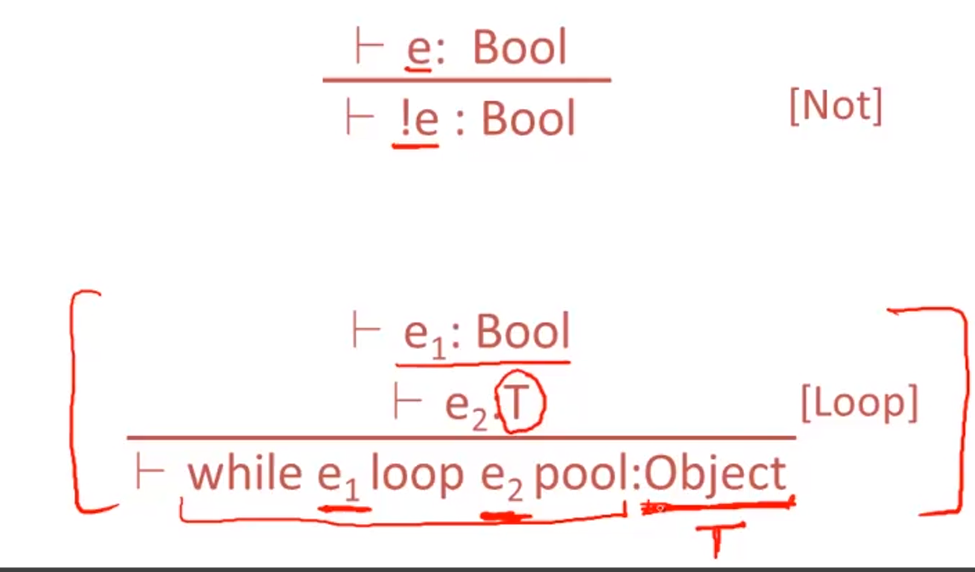
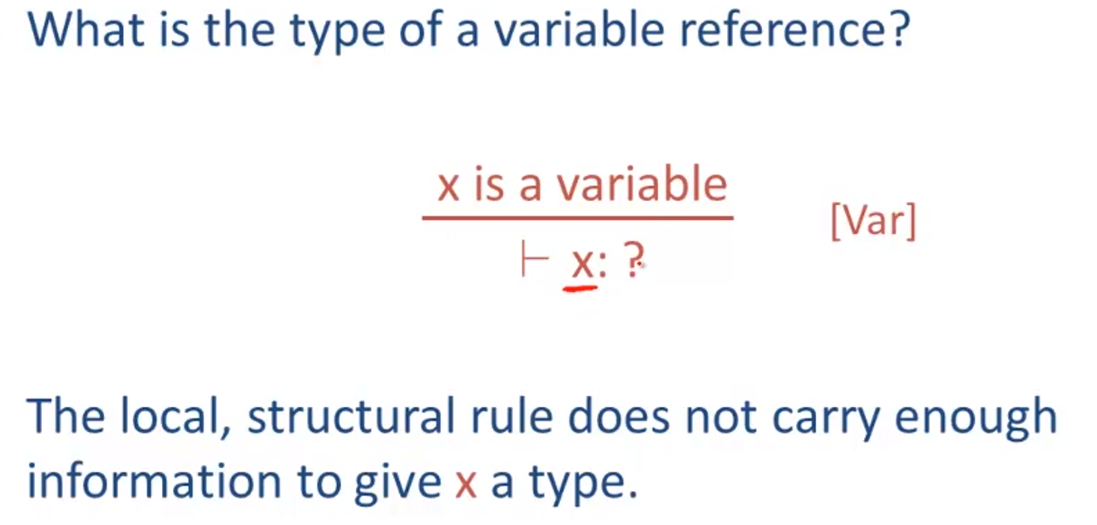
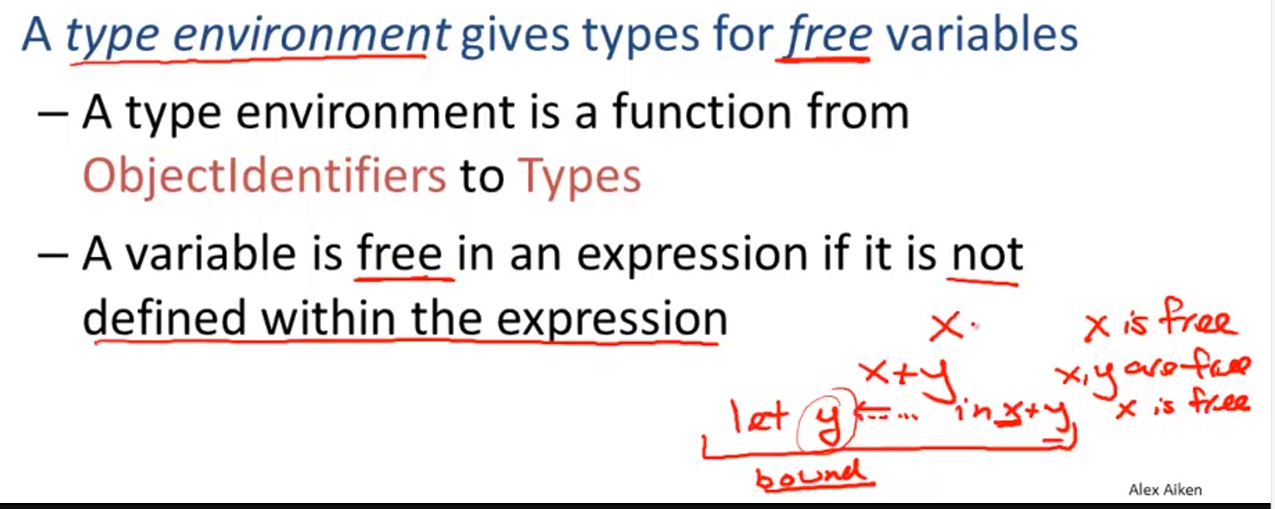
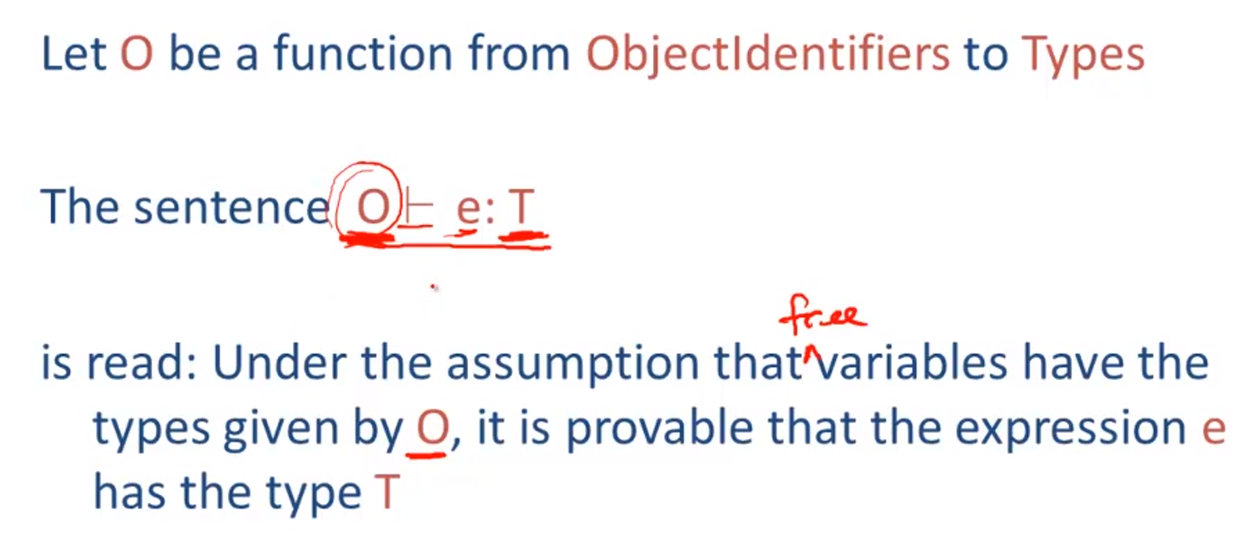
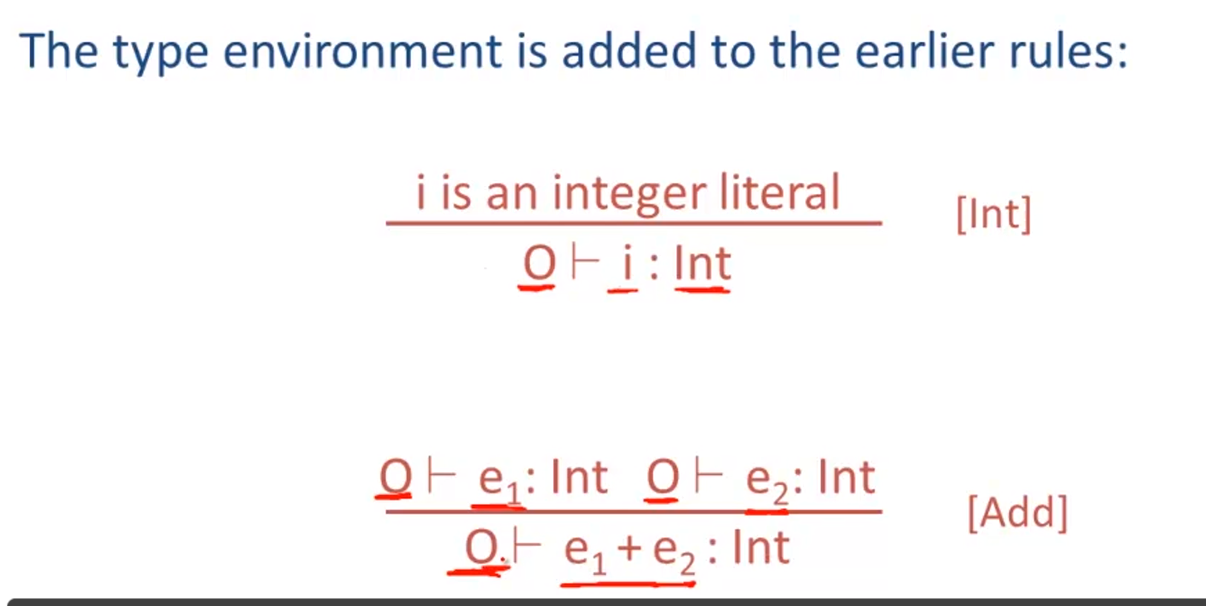
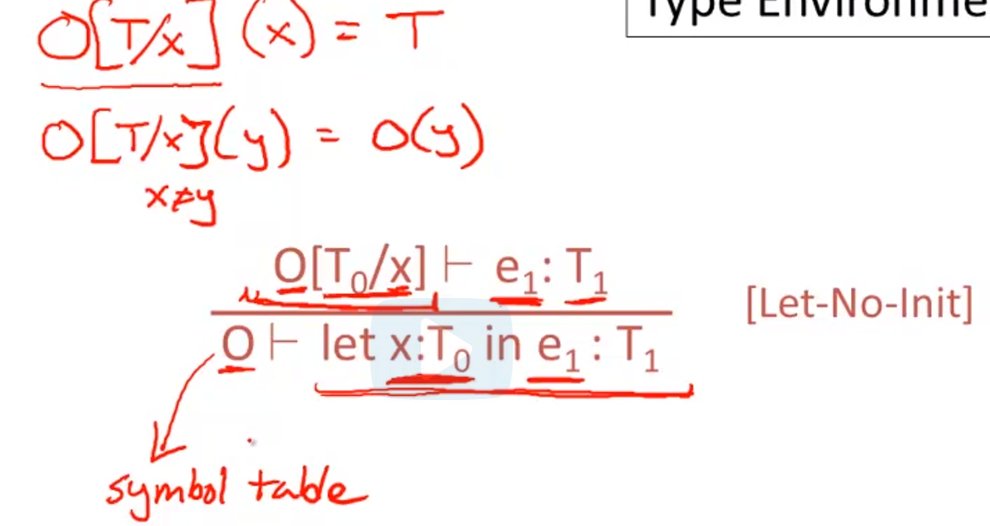
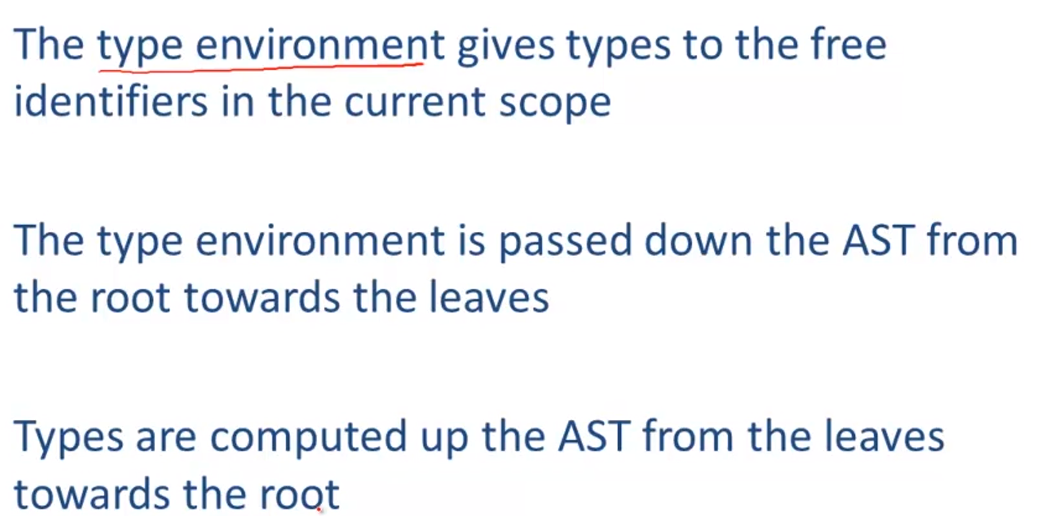
Subtyping
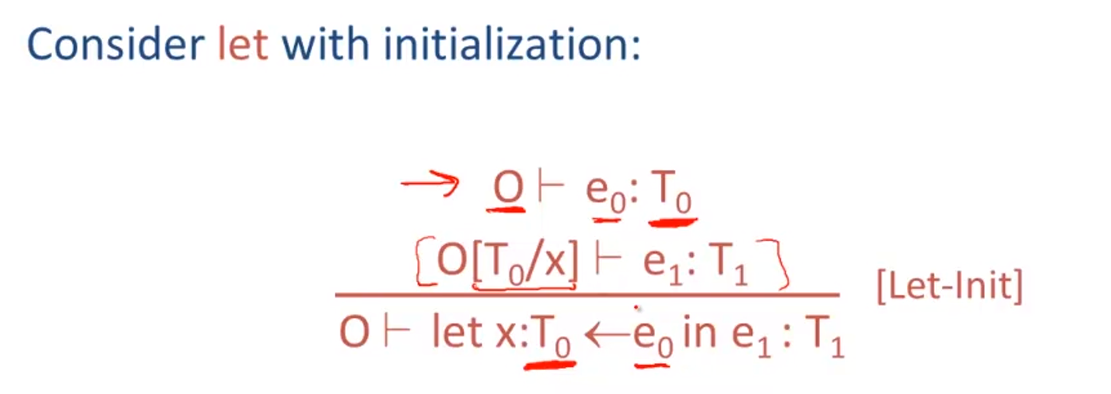
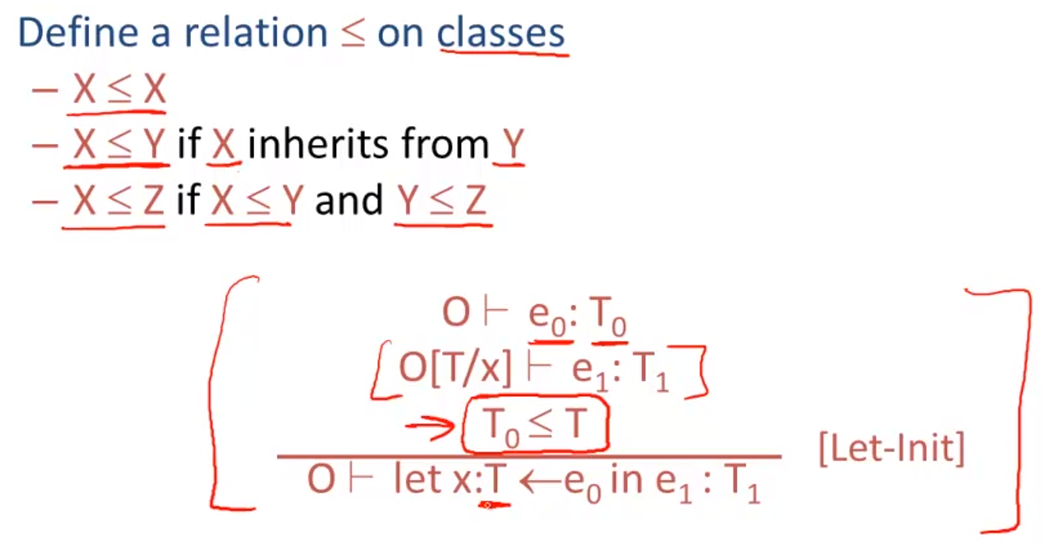

LUB or least upper bound



因为不知道会匹配上哪个类型,所以要lub(T1,…..Tn)
Typing Methods
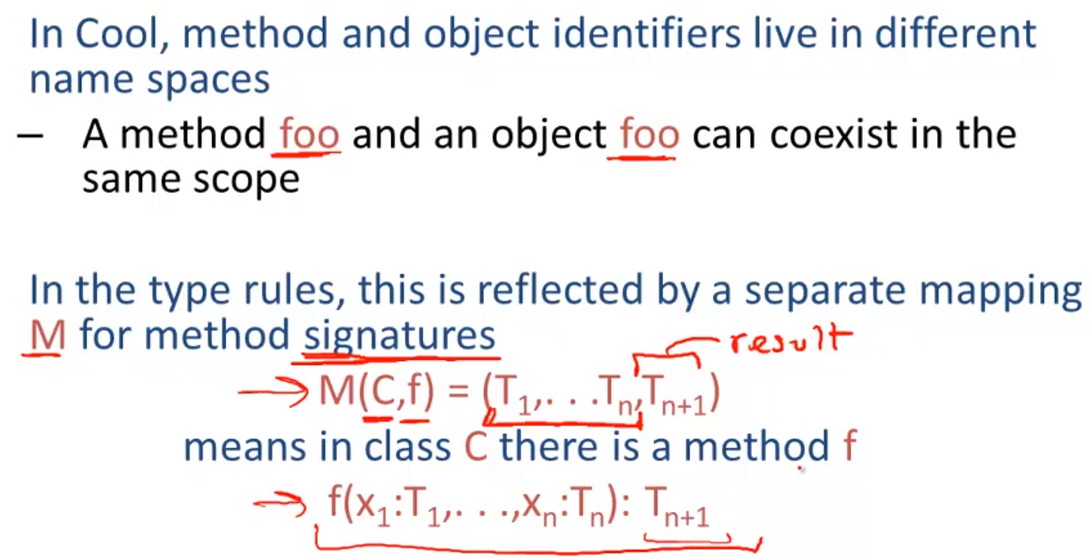
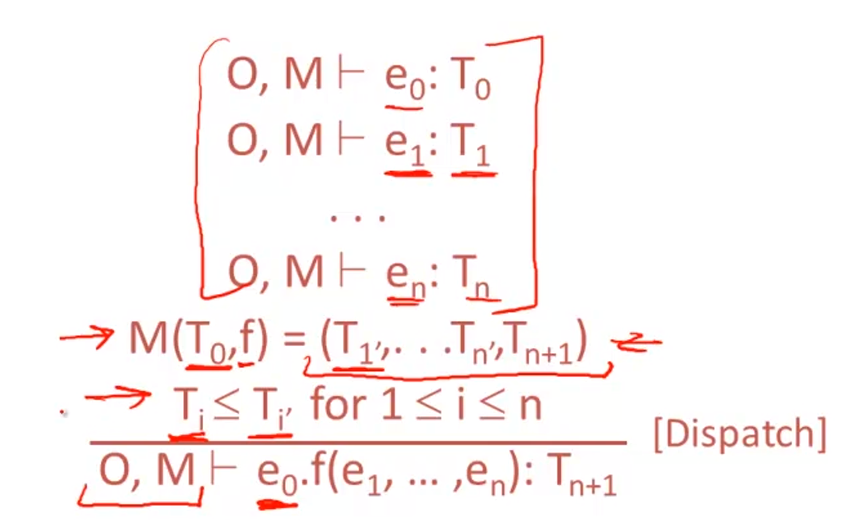

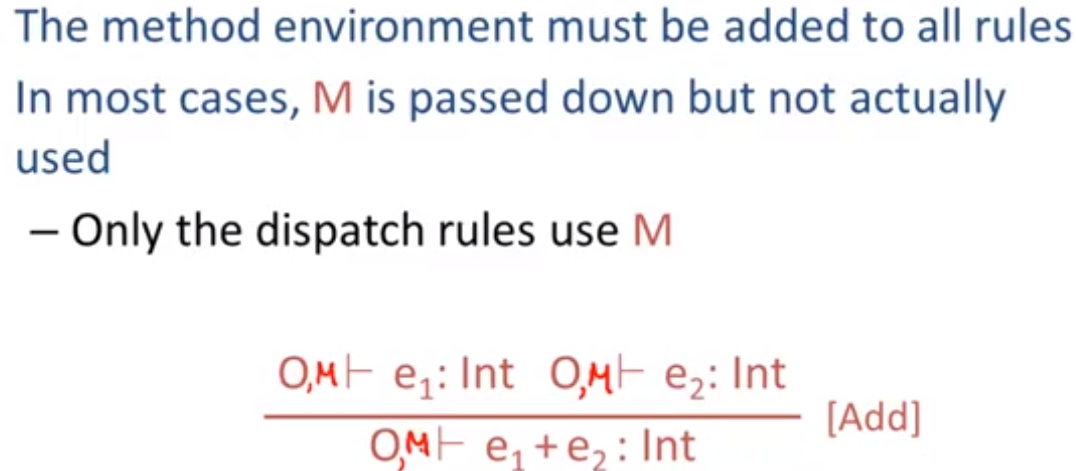
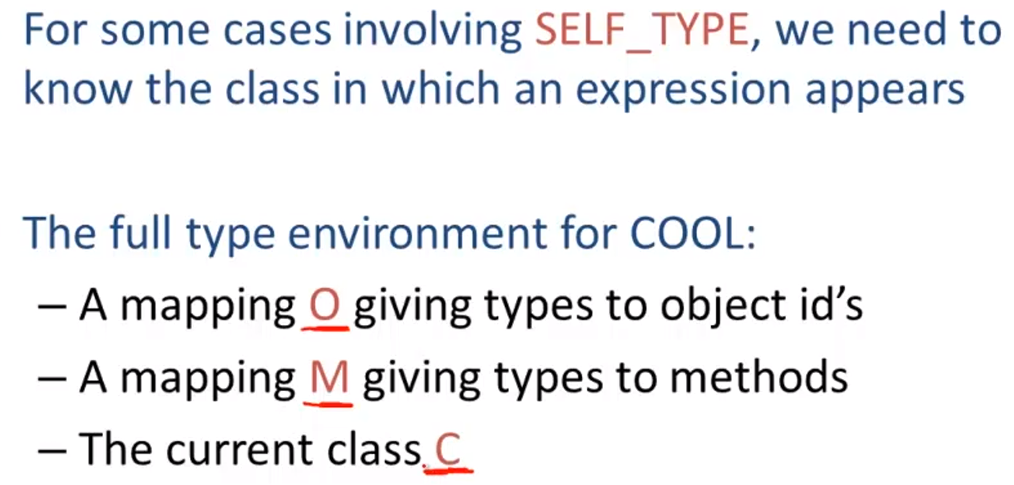
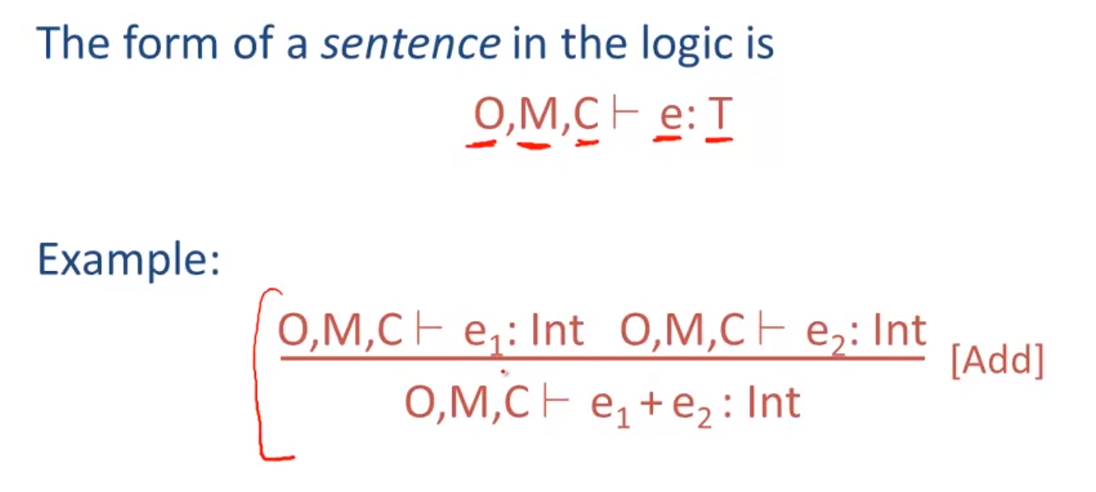
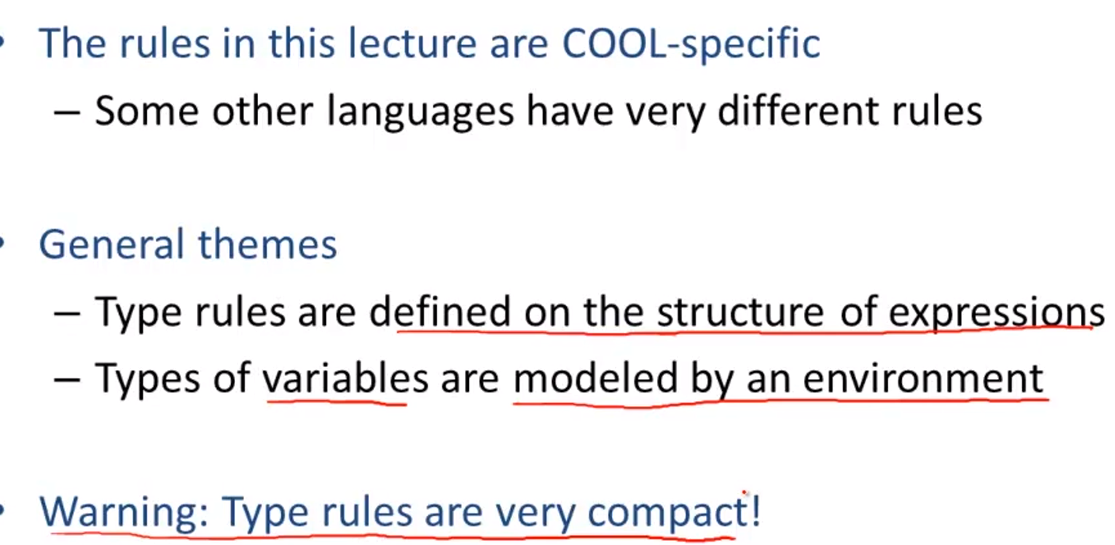
Implementing Type Checking
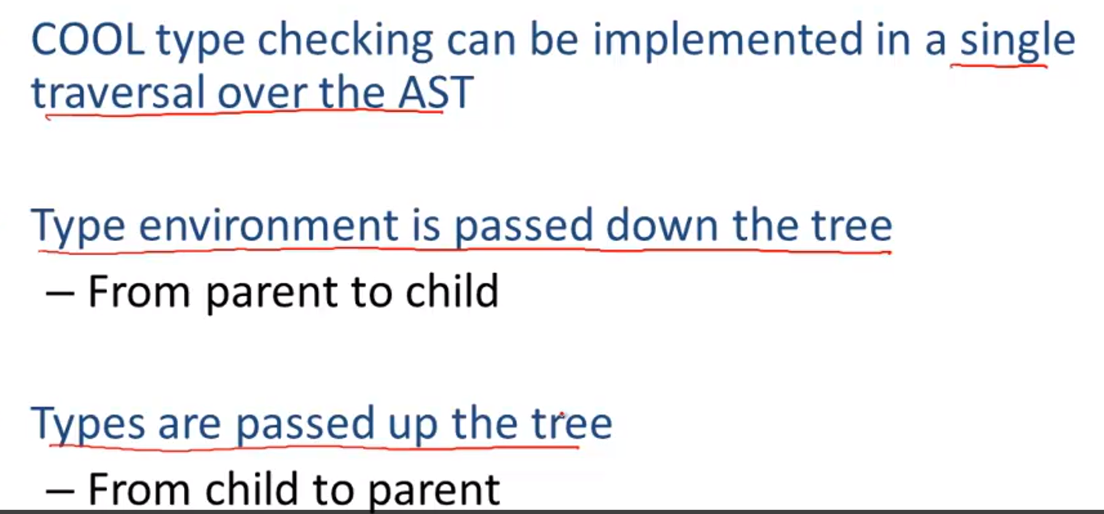
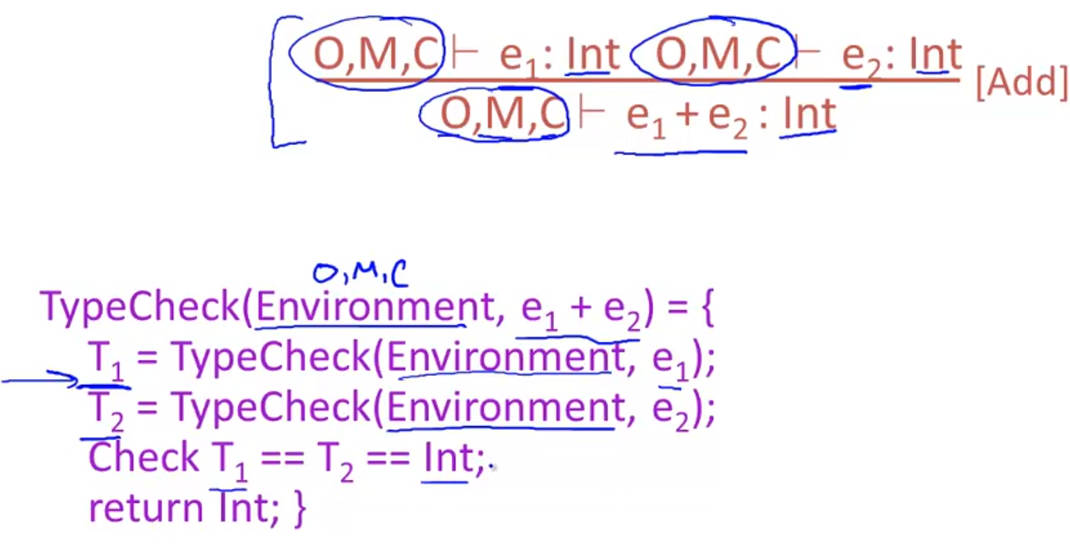
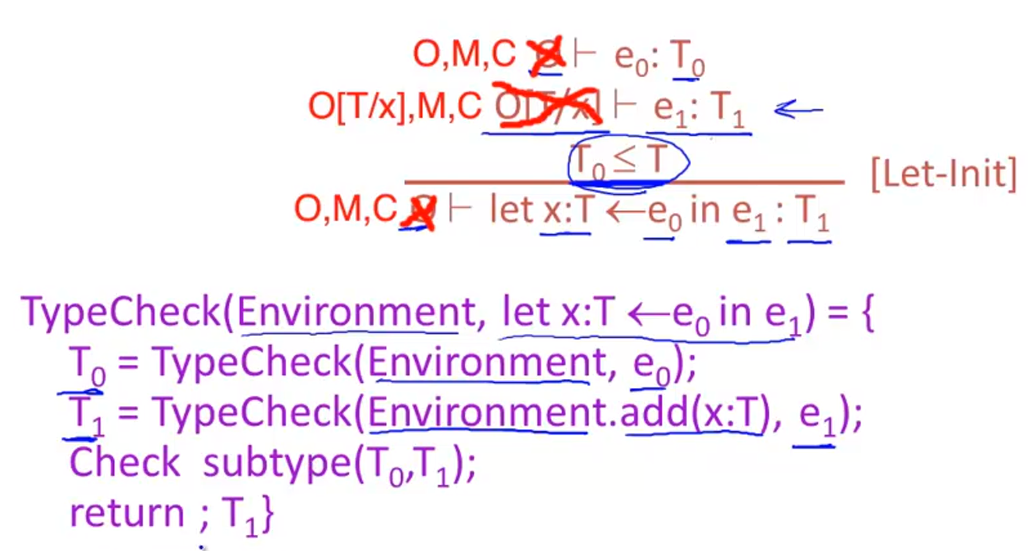
PA4
Cool Type Checking & Runtime Organization
Static vs. Dynamic Typing
Static type systems detect common errors( at compile time)
But some correct programs are disallowed
- Some argue for dynamic type checking instead
- Others want more expressive static type checking
Soundness theorem: for all expressions E
dynamic_type(E)=static_type(E)
In all executions,E evaluates to values of the type inferred by the compiler.
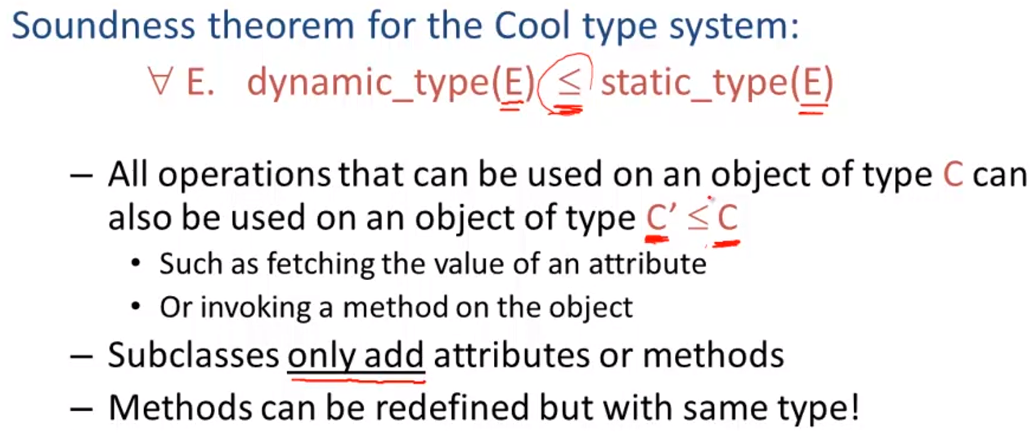
Self Type
class Count{
i:int-0;
inc():Count{//返回Count的class类型
{
i<-i+1;
self;
}
};
};
class Stock inherits Count{
name: String;--name of item
}
class Main{
Stocka-(new Stock).inc();//类型错误,Count不是Stock的子集
...a.name ...
}
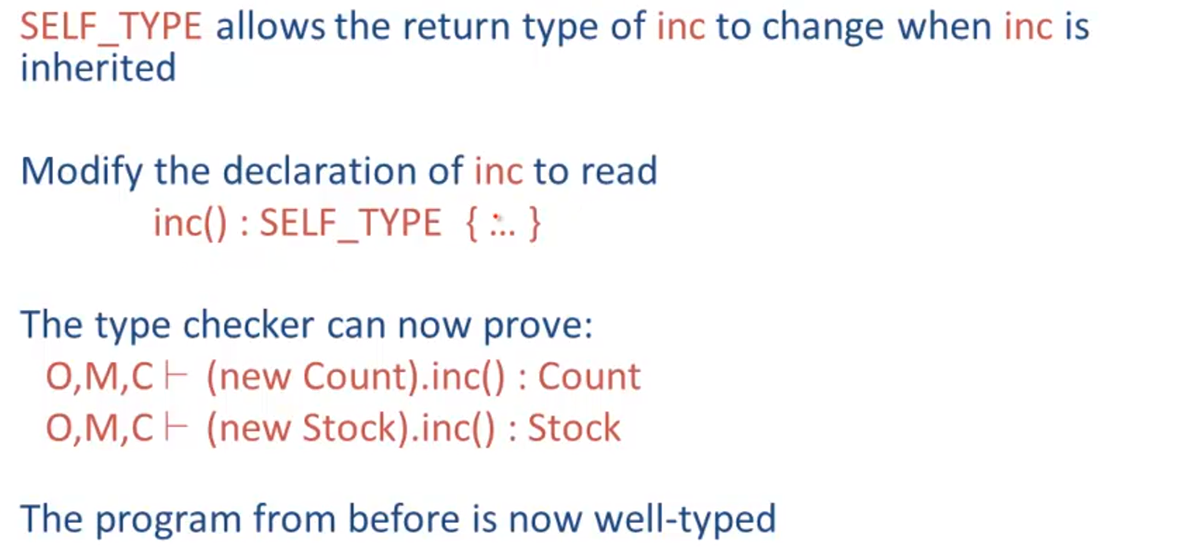
Self Type Operations
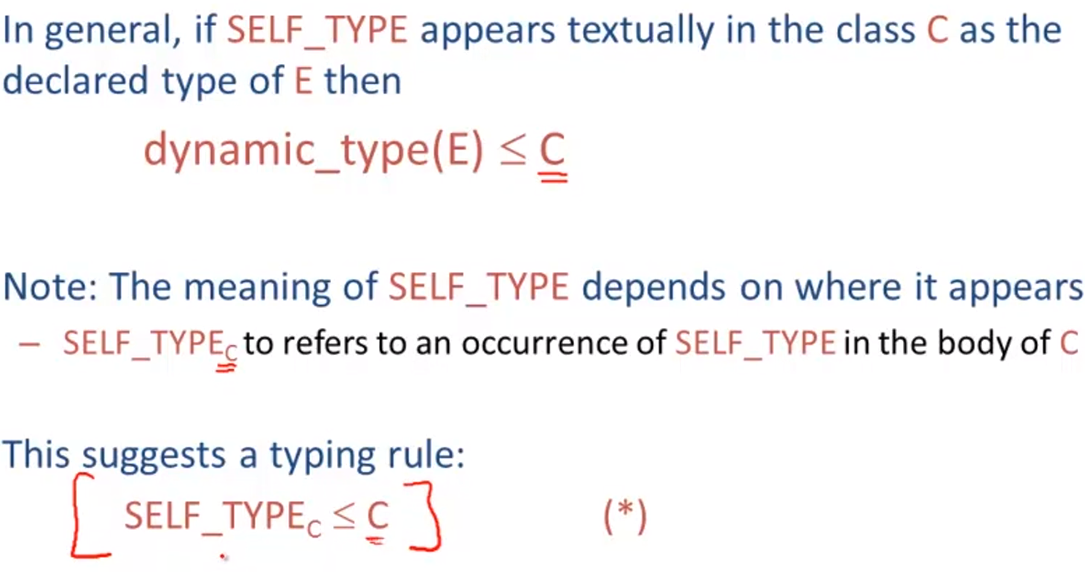

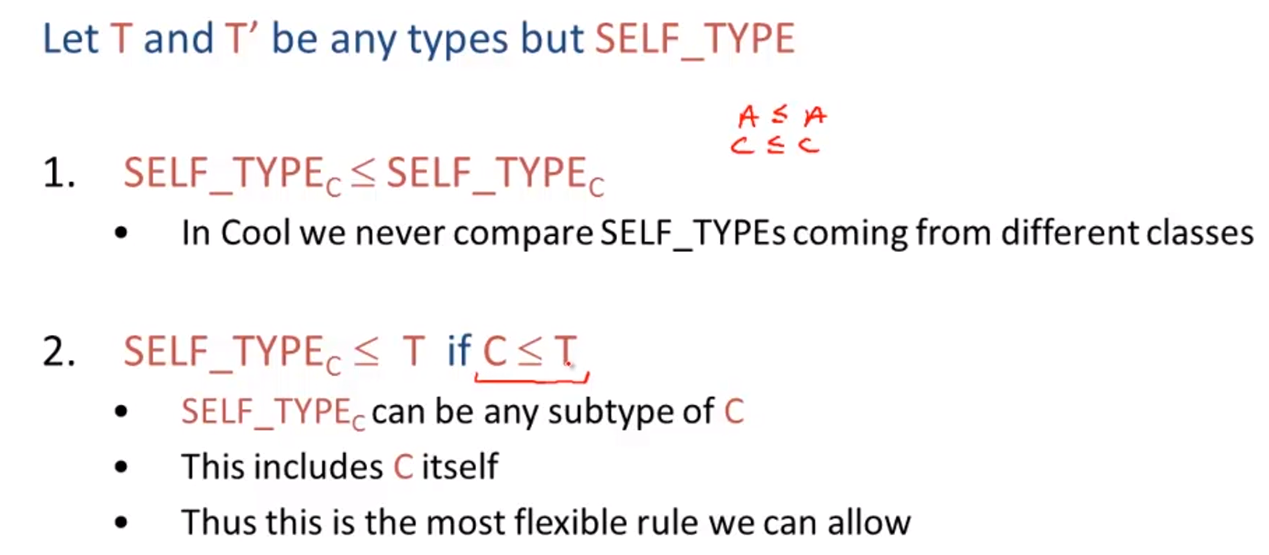

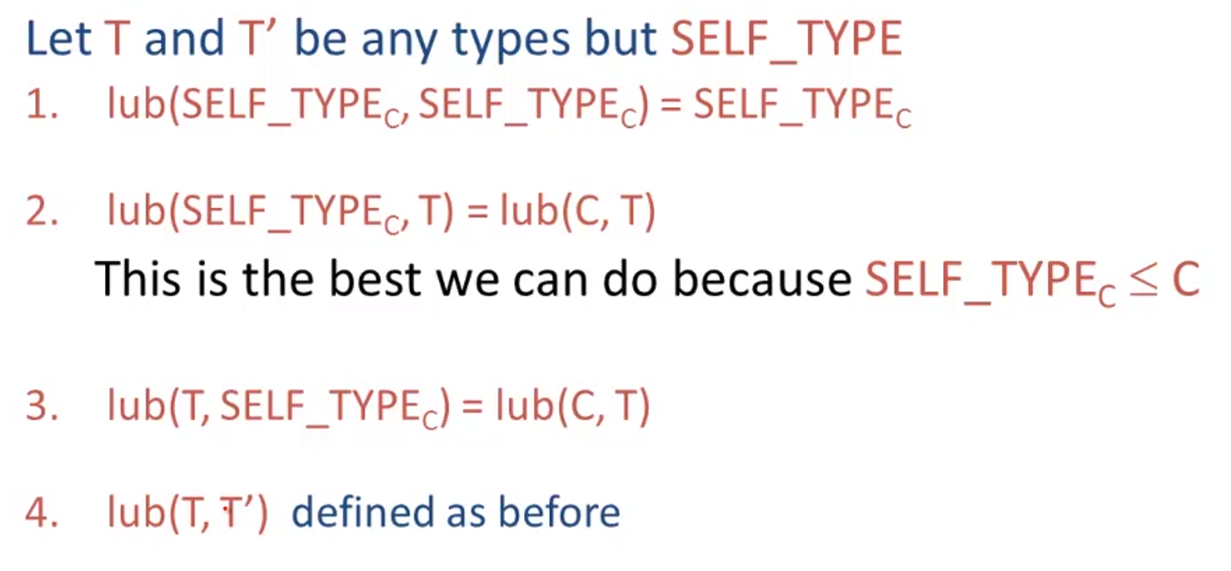
Self Type Usage
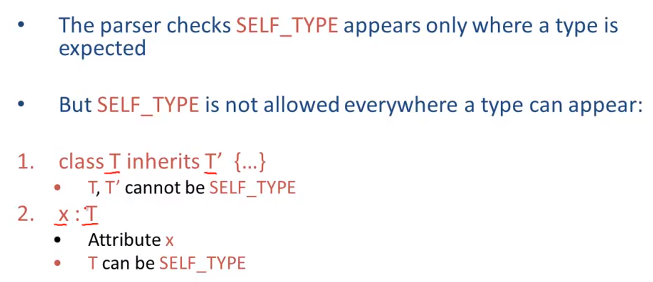
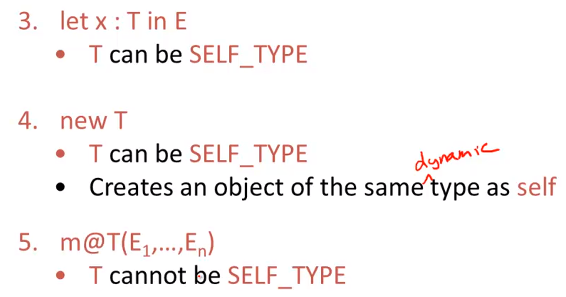
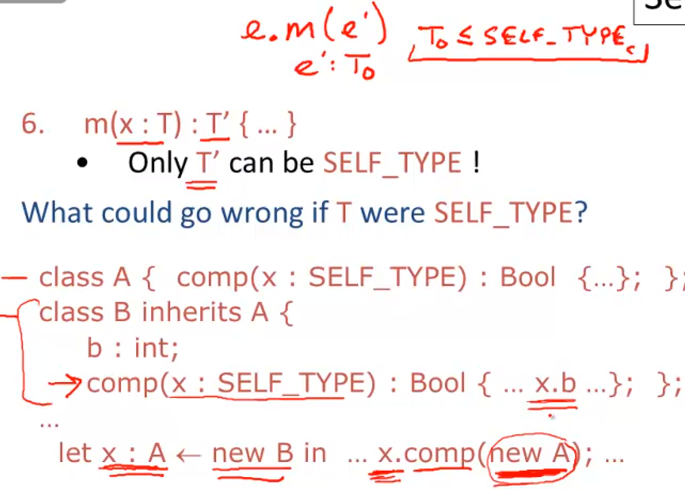
Self Type Checking
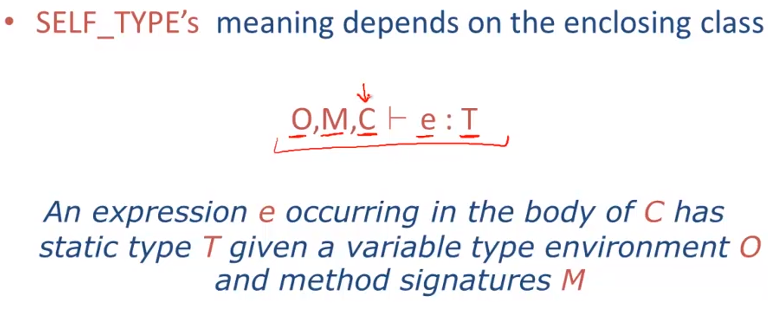
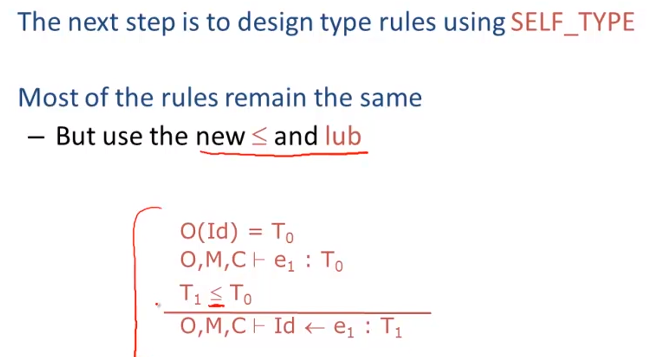
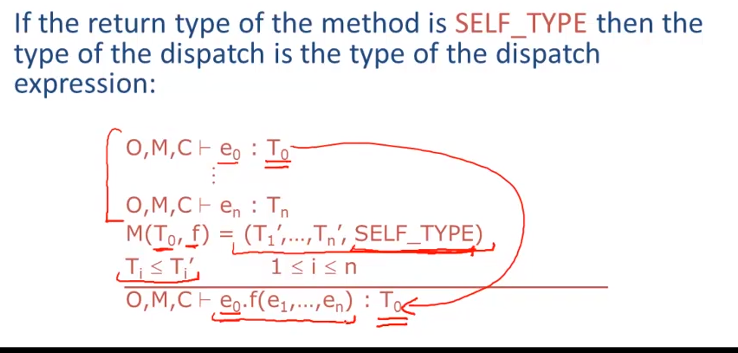
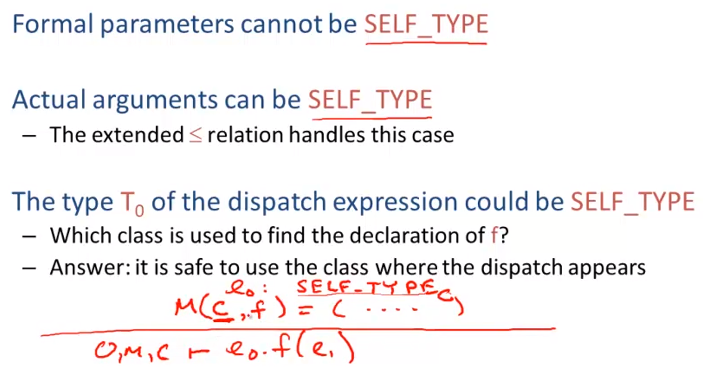
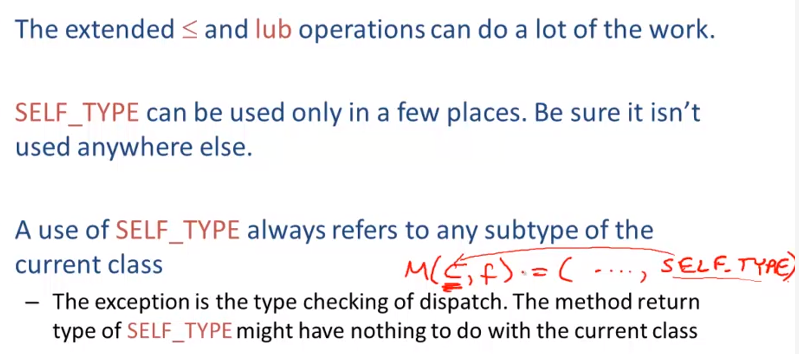
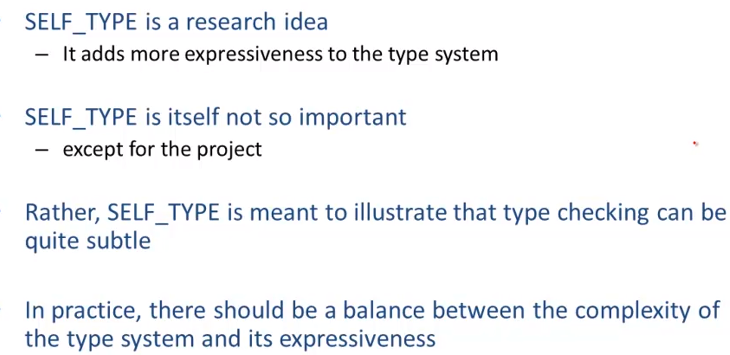
Error Recovery
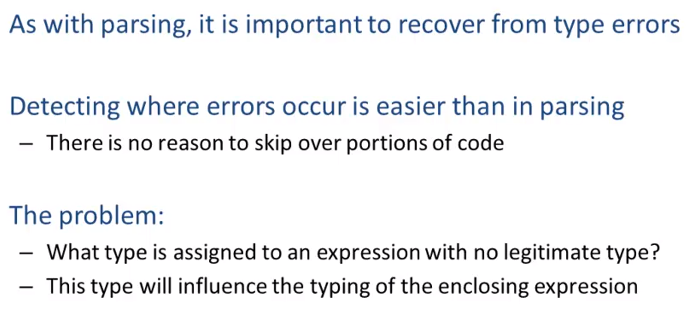

a workable solution but with cascading errors
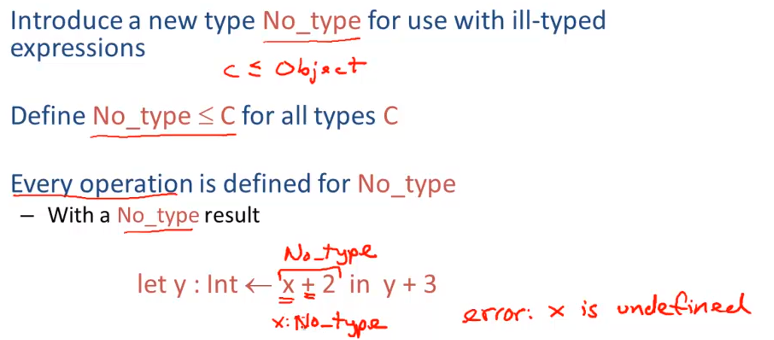
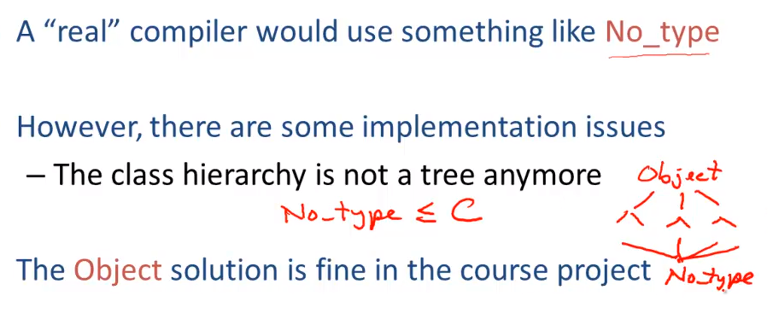
Runtime Organization
Enforcing the language definition is just one purpose of the front-end. The front-end also builds the data structures that are needed to do co-generation as we seen but there is a real. Once we get through the front-end we no longer looking for errors in the program. We’re no longer trying to figure out whether it’s a valid program. Now we’re really down to the point where we’re going to generate code And that is a job at the back end.
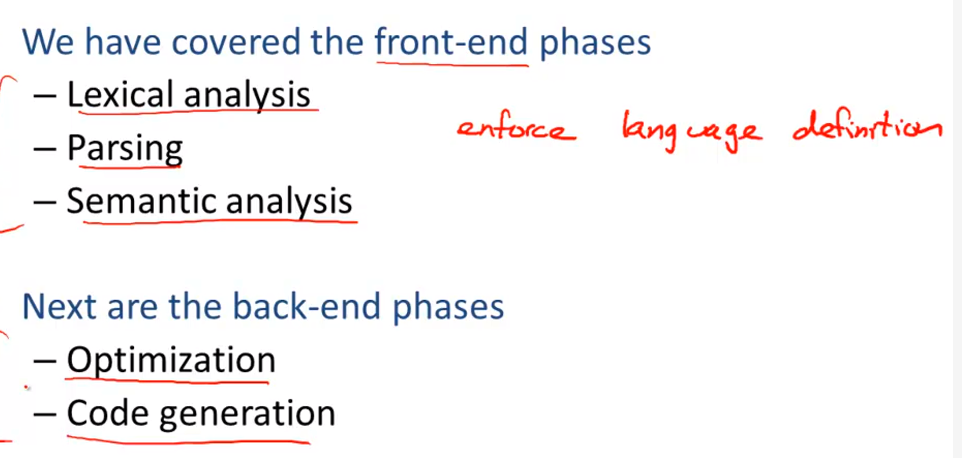

Activations
Two goals:
- Correctness
- Speed
Complications in code generation come from trying to be fast as well as correct

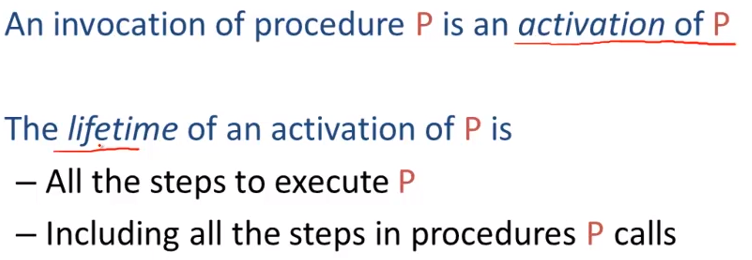
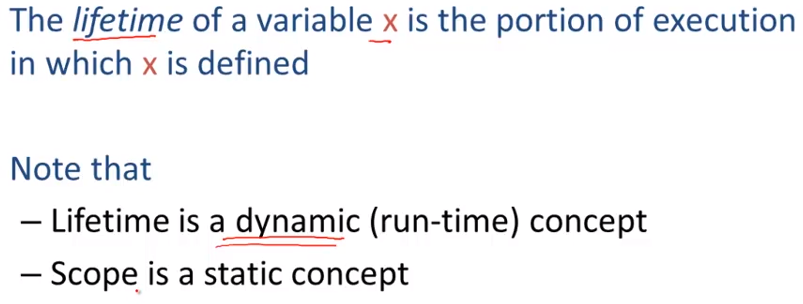
activation tree

子树在同一行内代表调用后,需要依次调用的函数
isEven(x:Int) : Bool {x % 2 == 0}; isOne(x:Int) : Bool {x == 1}; powerOfTwo(x:Int) : Bool { if isEven(x) then powerOfTwo(x / 2) else isOne(x) };

Activation Records
The information needed to manage one procedure activation is called an activation record (AR) or frame
If procedure F calls G, then G’s activation record contains a mix of info about F and G.
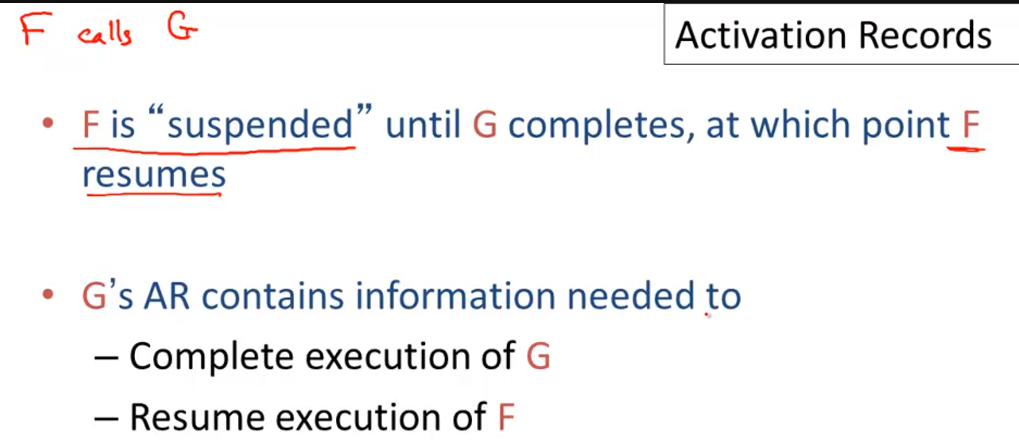
The compiler must determine,at compile-time,the layout of activation records and generate code that correctly accesses locations in the activation record
Thus,the AR layout and the code generator must be designed together!
Globals and Heap
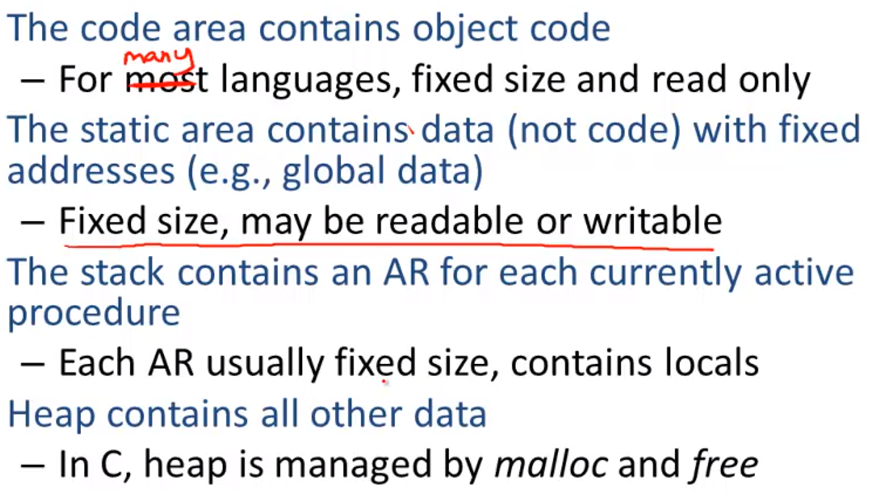
Both the heap and the stack grow
Must take care that they don’t grow into each other
Solution:start heap and stack at opposite ends of memory and let them grow towards each other
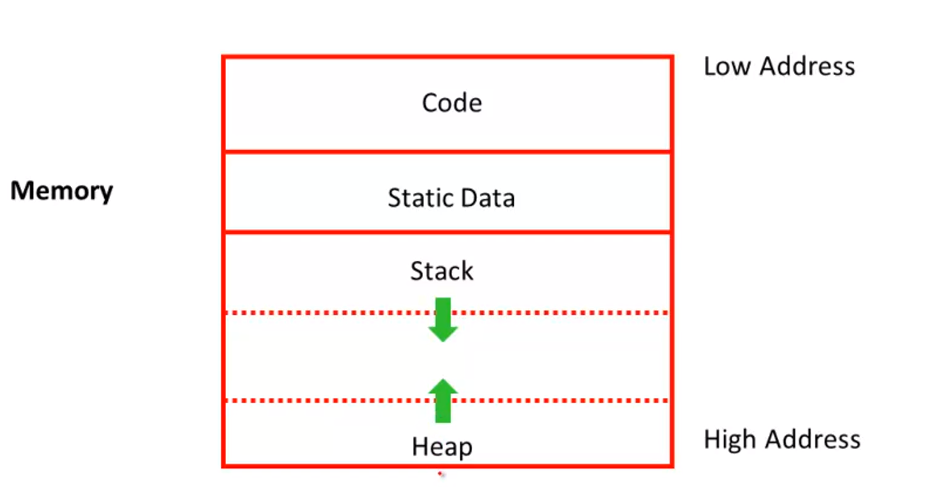
Alignment
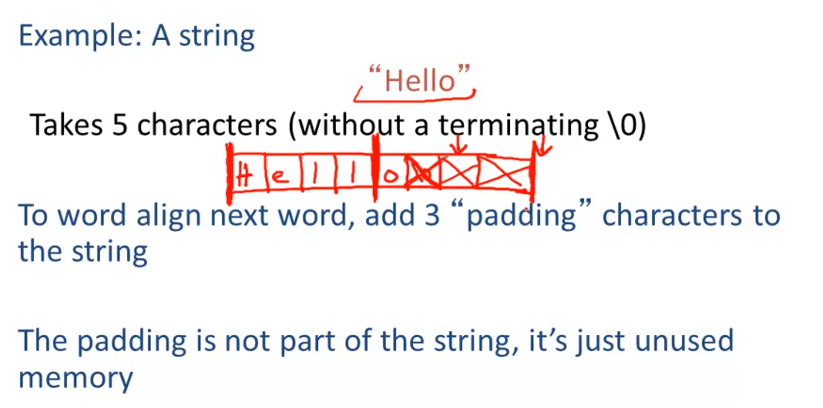
Stack Machines
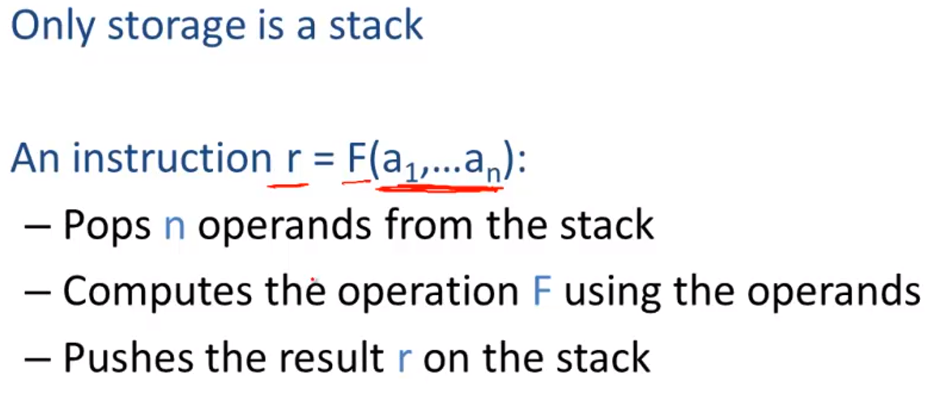
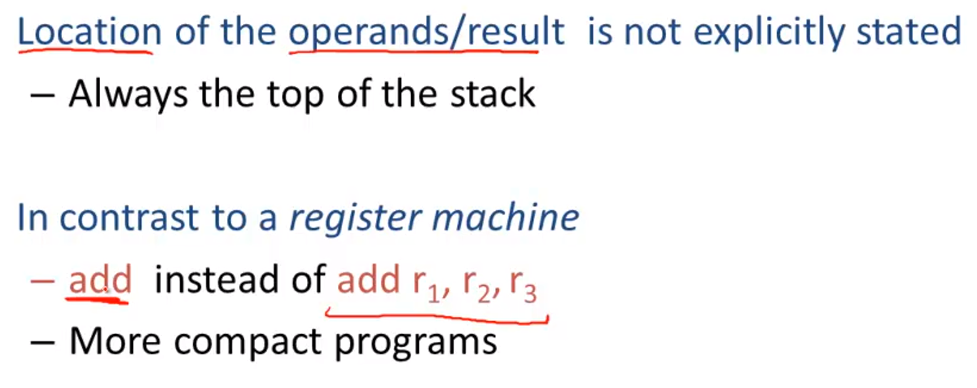
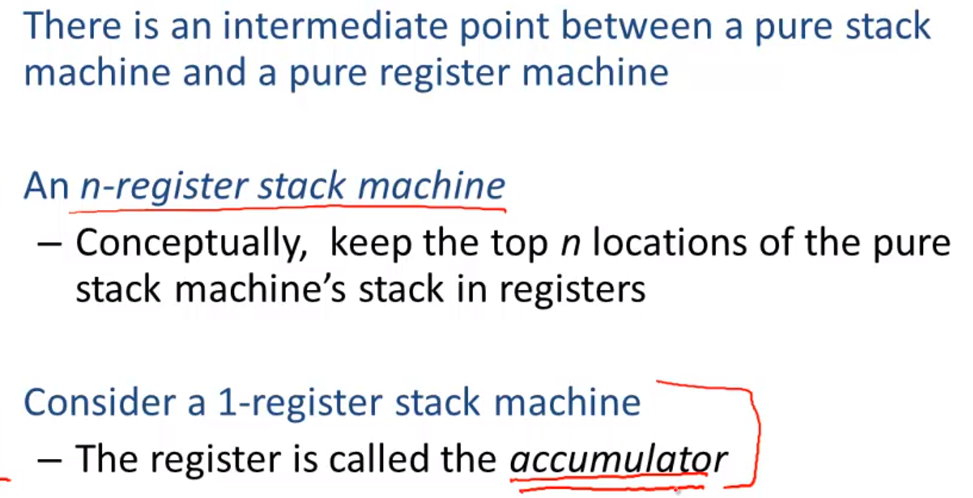
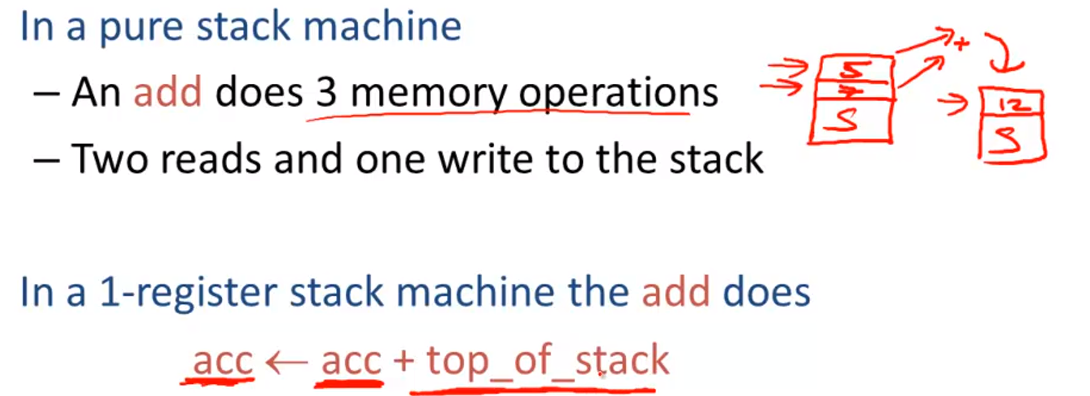

After evaluating an expression e, the accumulator holds the value of e and the stack is unchanged.
Expression evaluation preserves the stack.
exmaple
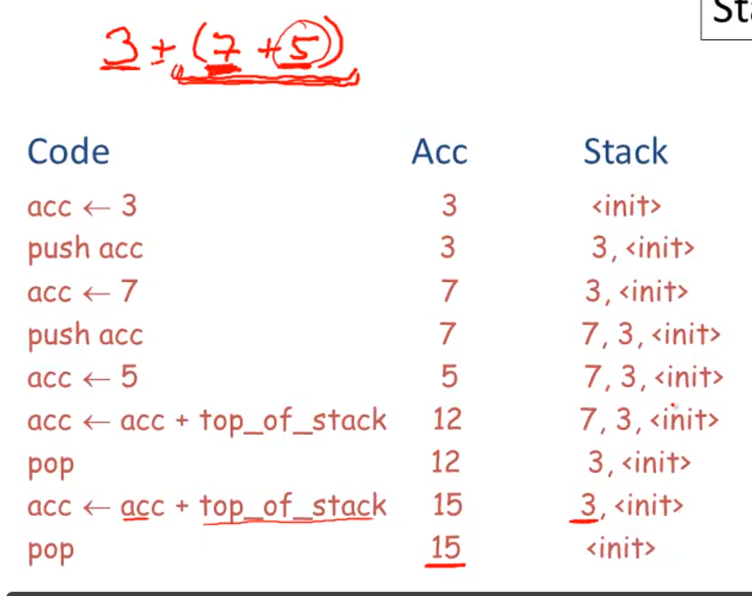
Code Generation
Introduction to Code Generation
The accumulator is kept in MIPS register $a0
The stack is kept in memory
- The stack grows towards lower addresses
- Standard convention on MIPS
The address of the next location on the stack is kept in MIPS register $sp (stack pointer
- The top of the stack is at address
$sp+4
Stack is growing towards low addresses
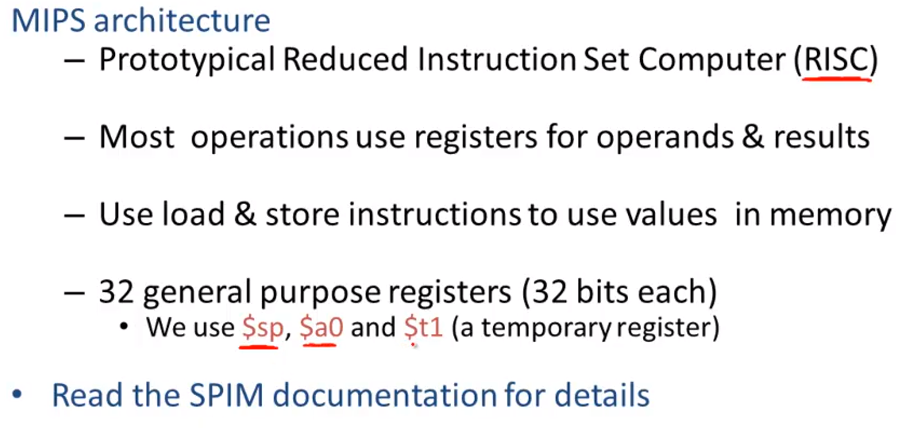
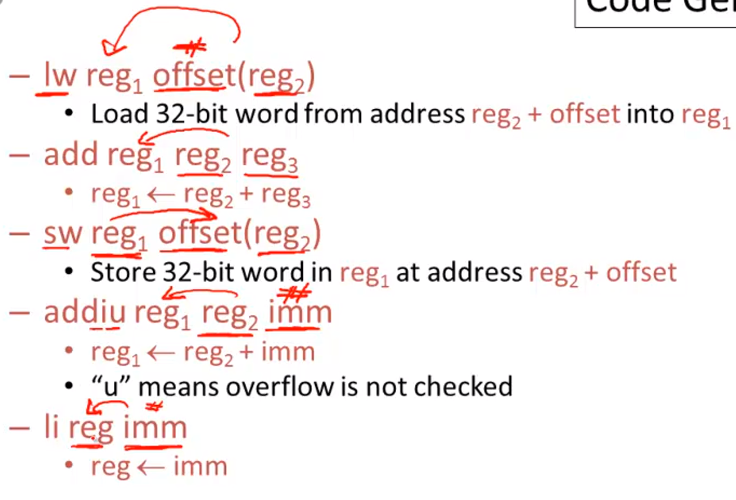
example
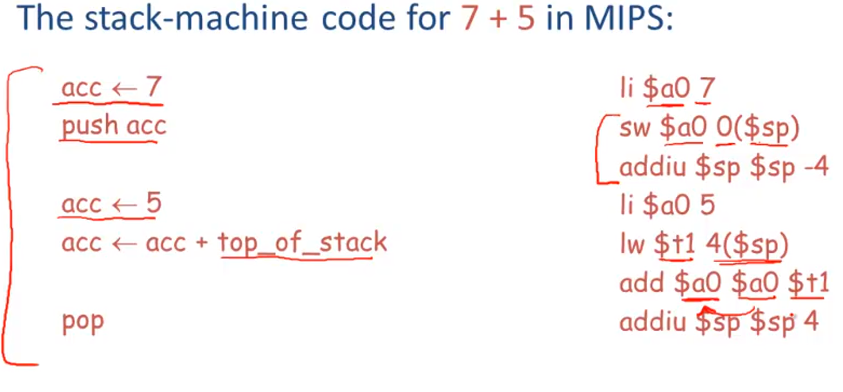
Code Generation I
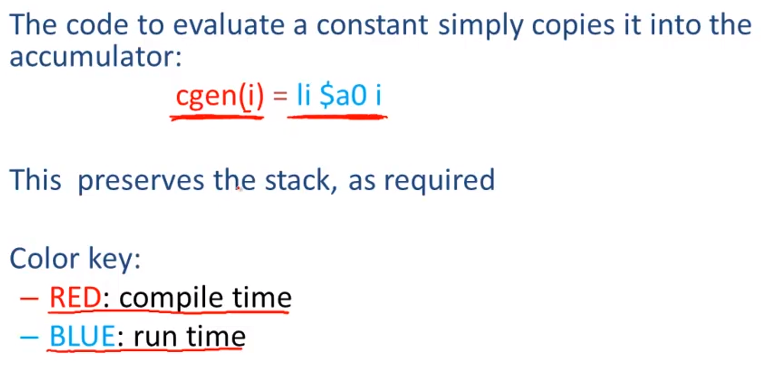
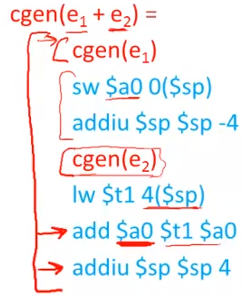

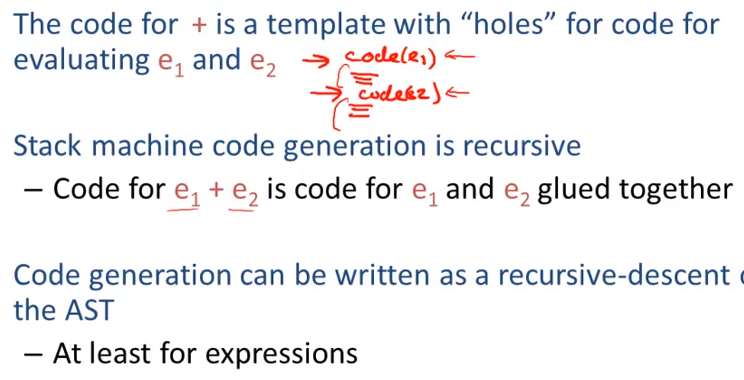
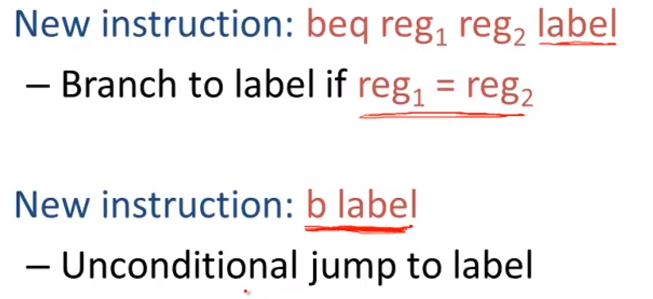
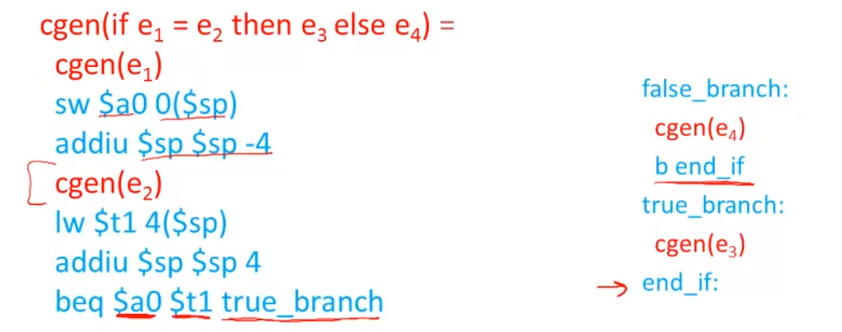
Code Generation II
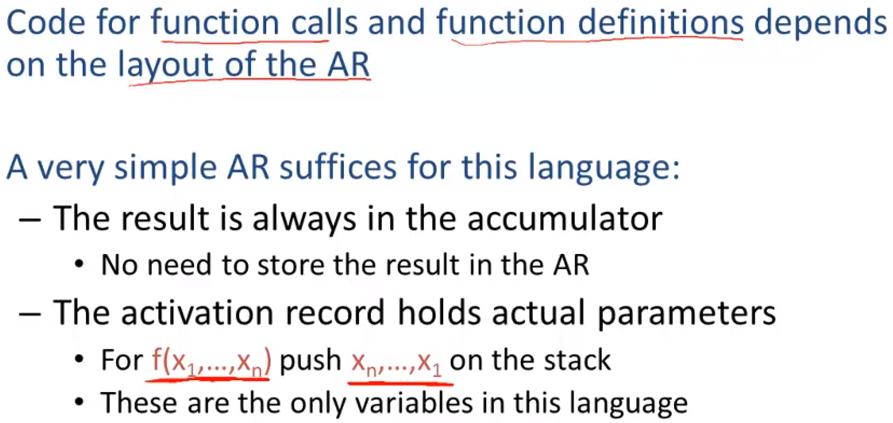
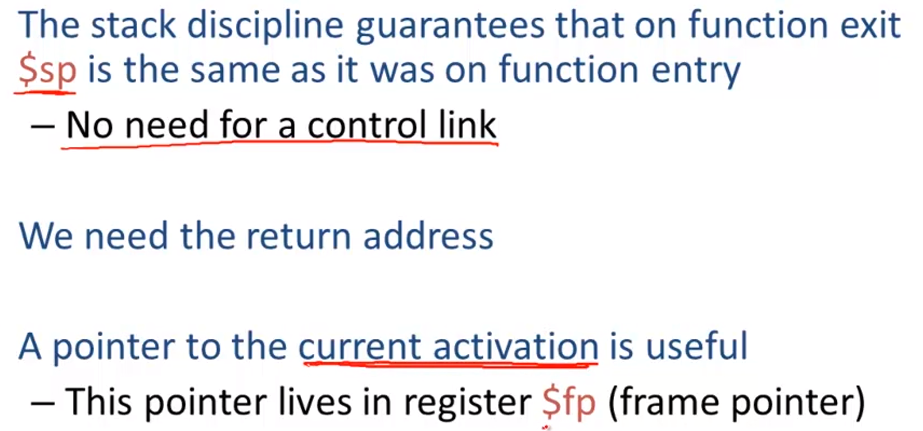
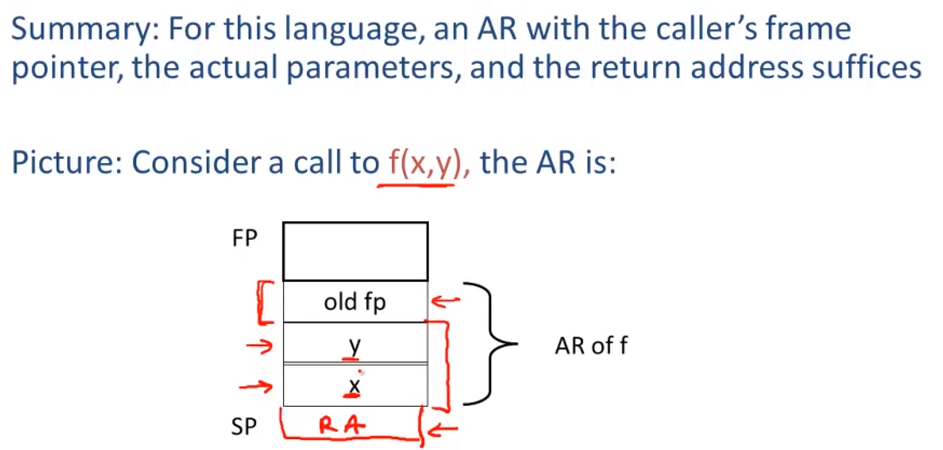



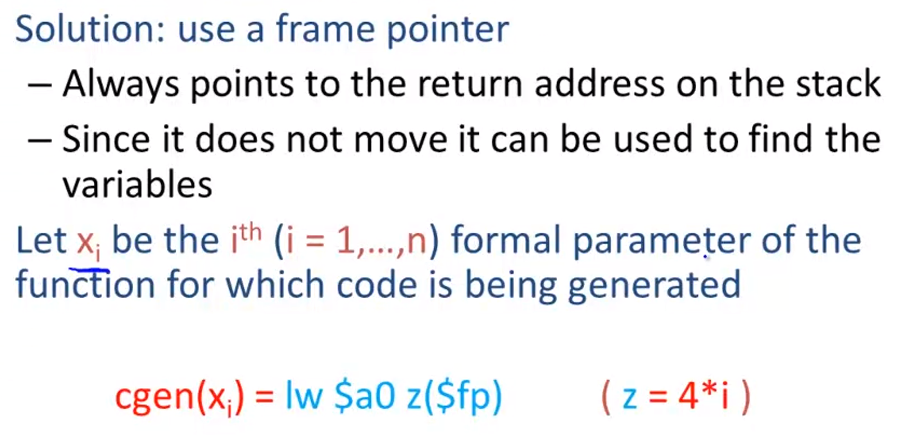
example



Code Generation Example

Temporaries
Idea:Keep temporaries in the AR
The code generator must assign a fixed location in the AR for each temporary

While we need one here for the predicate, but notice that once the predicate is decided, once we know the answer to whether this predicate is true or false, we don’t need that temporary anymore. So in fact, that temporary can be reclaimed; we don’t need the space for that temporary anymore by the time we get to the false branch.

NT(e1 + e2) = max(NT(e1), 1 + NT(e2))

example
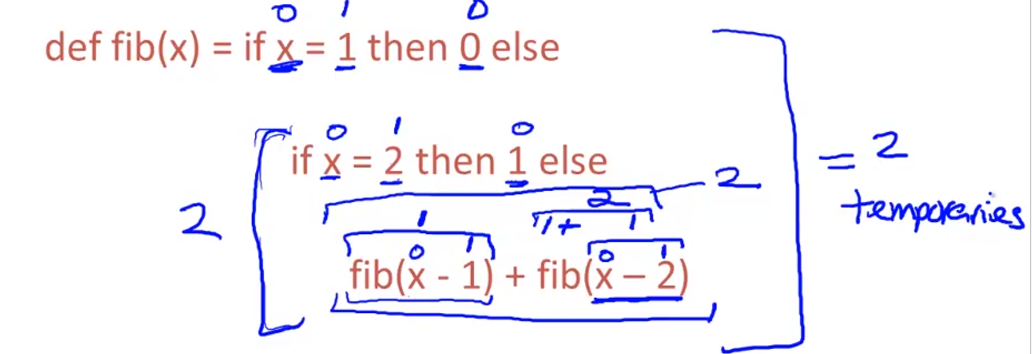
最多需要两个temporaries来储存这些数据
if 的true 或flase 一个,单个int可以变成返回值(不用临时变量),调用fib 传递的参数需要用临时变量
For a function definition f(x.…… Xn)=e the AR has 2+n+NT(e) elements
- Return addressL
- Frame pointer C
- n arguments
- NT(e) locations for intermediate results
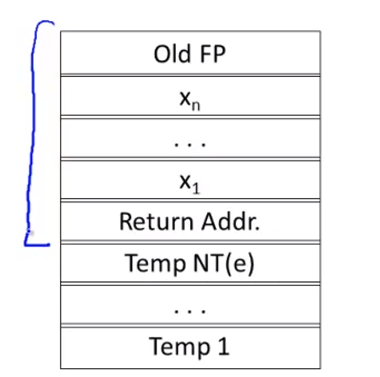
new scheme
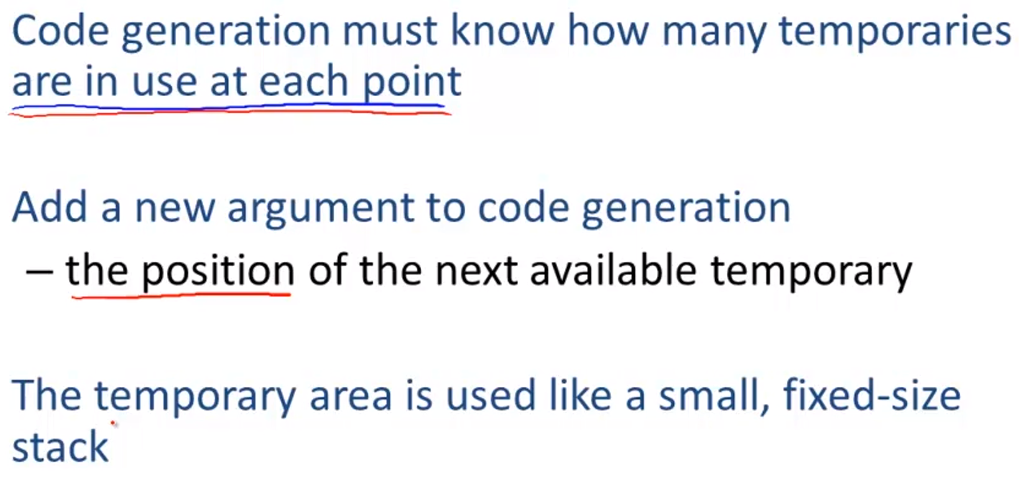
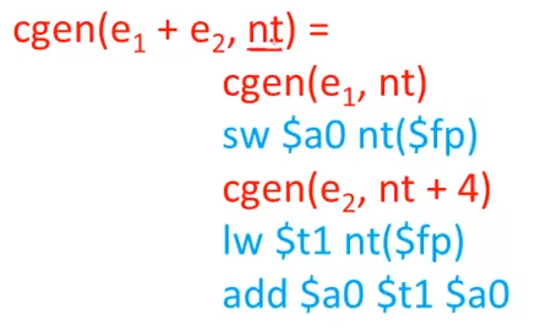
nt unused temporary
Object Layout
00 implementation=Basic code generation + More stuff
0o Slogan:If B is a subclass of A,than an object of class B can be used wherever an object of class A is expected
This means that code in class A works unmodified for an object of class B

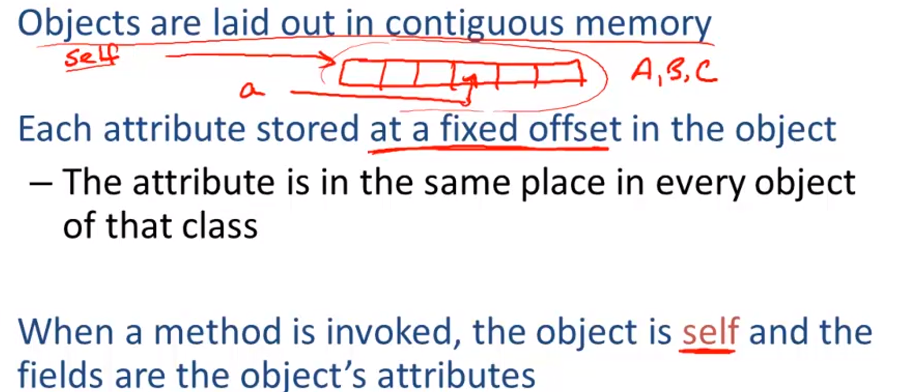

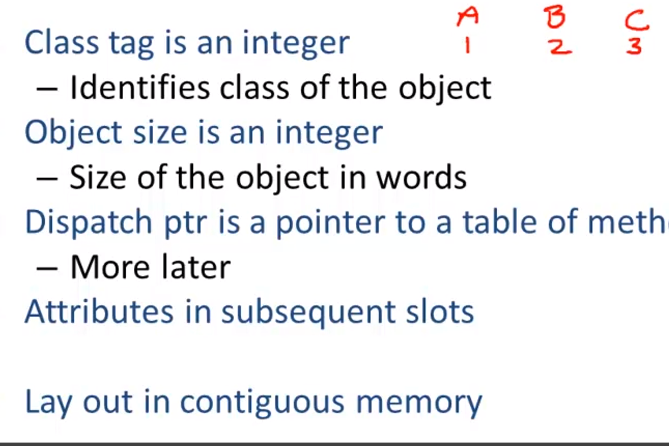
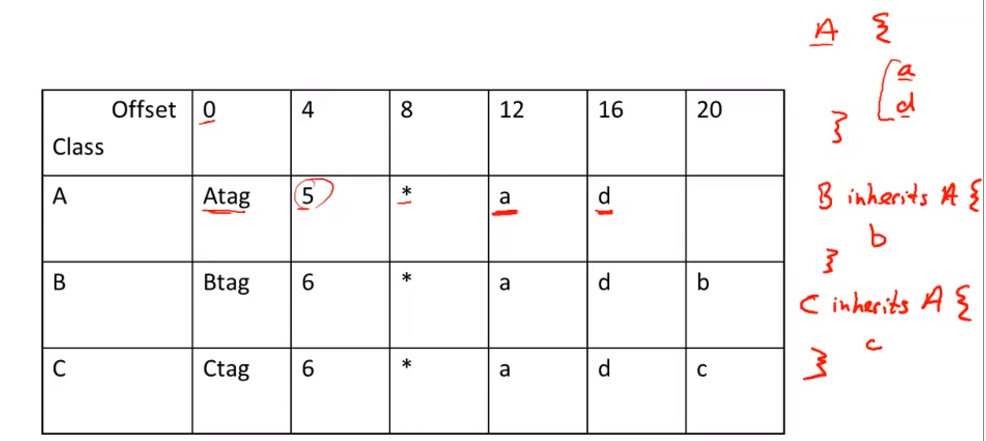
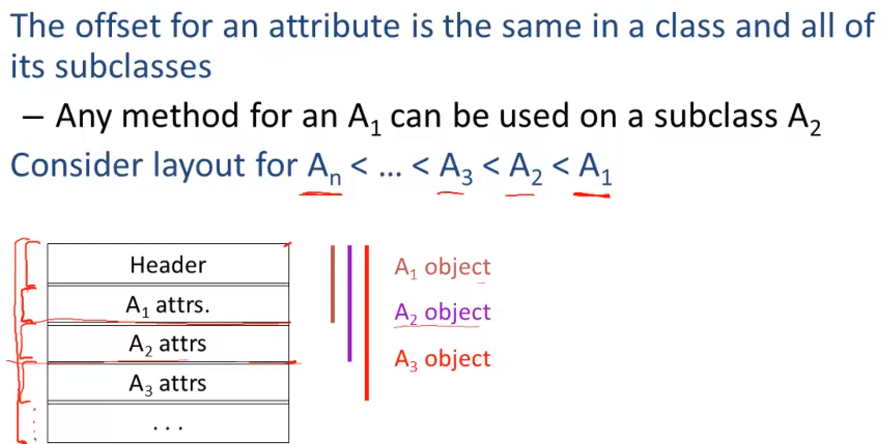
Every class has a fixed set of methods
- including inherited methods
A dispatch table indexes these methods
- An array of method entry points
- A method f lives at a fixed offset in the dispatch table for a class and all of its subclasses
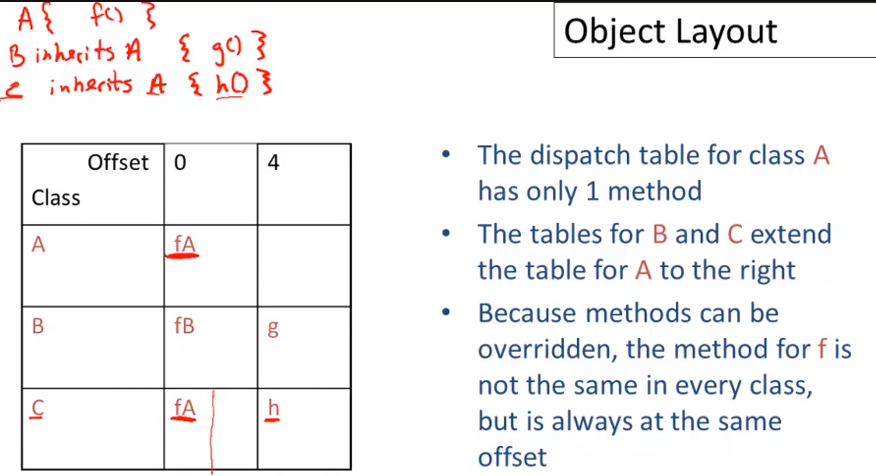


opentional Semantics overview
We must specify for every Cool expression what happens when it is evaluated
- This is the"meaning"of an expression
The definition of a programming language:
- The tokens >lexical analysis
- The grammar >syntactic analysis
- The typing rules >semantic analysis
- The evaluation rules →code generation and optimization
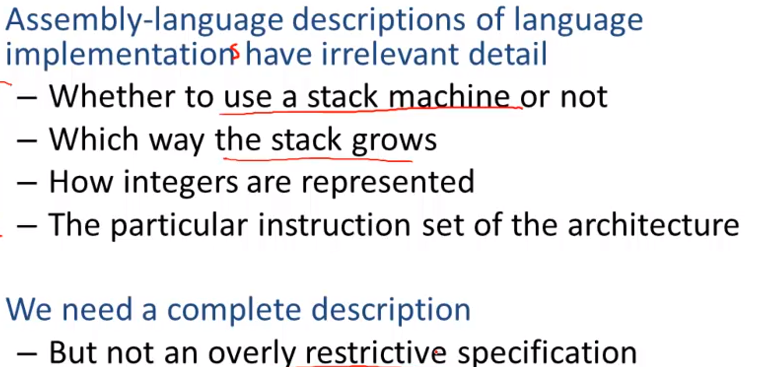
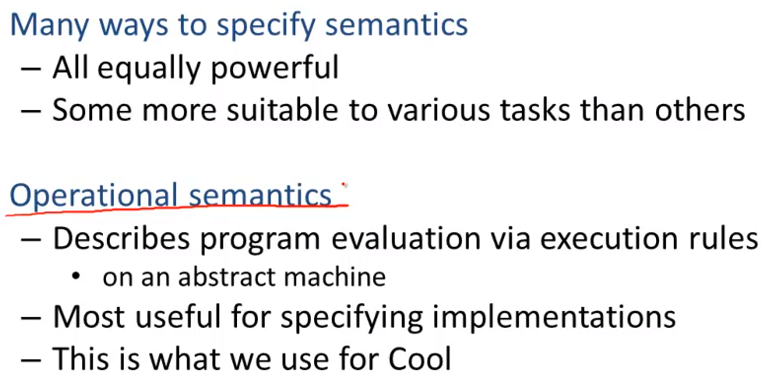
Denotaional semantics
Program’s meaning is a mathematical function
Axiomatic semantics
- Program behavior described via logical formulae
- If execution begins in state satisfying X,then it ends in state satisfyingY
- X,Y formulas
- Foundation of many program verification systems
Operational Semantics
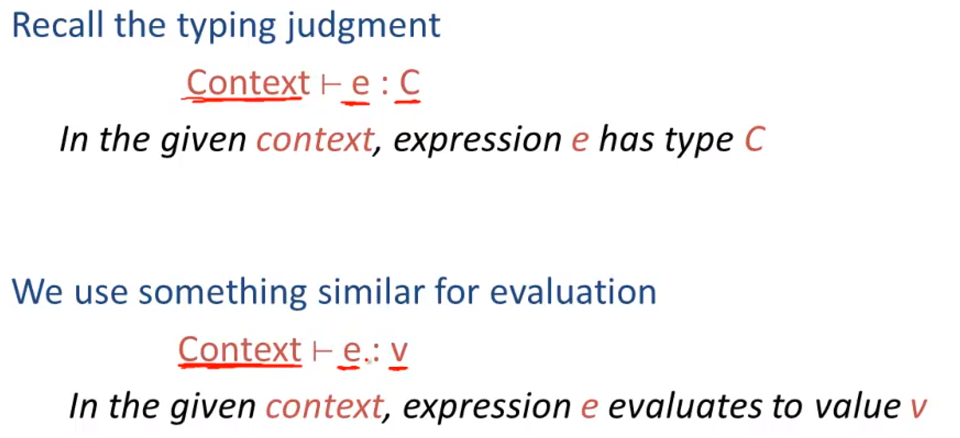

A variable environment maps variables to locations
- Keeps track of which yariables are in scope
- Tells us where those variables are
E = [ a : l1, b : l2 ]
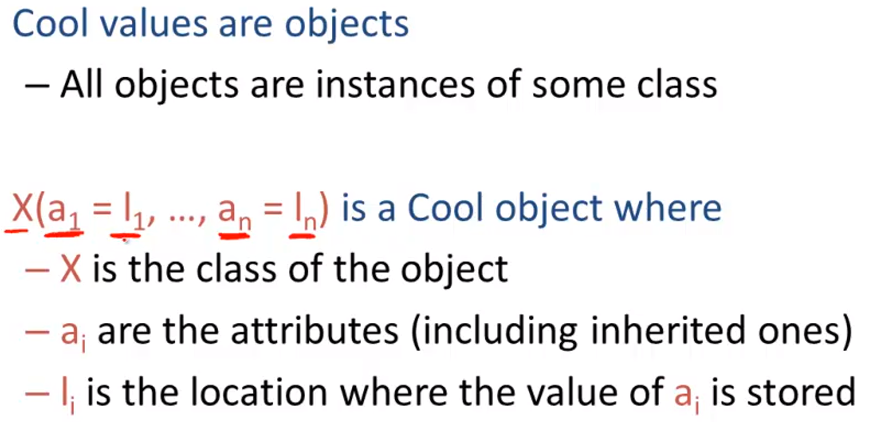
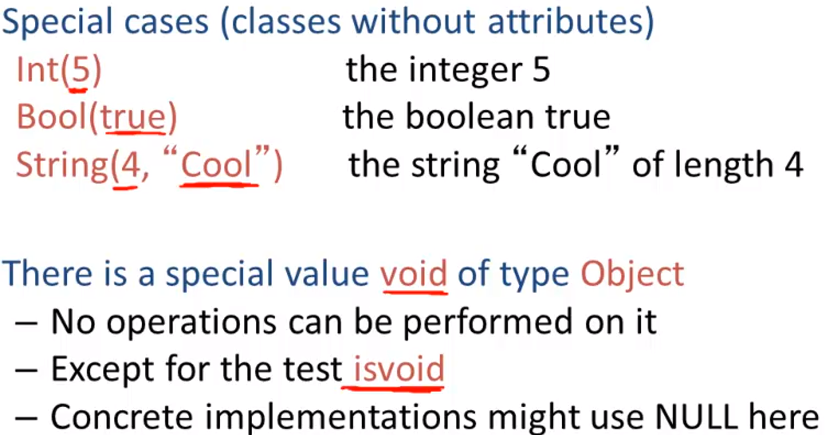

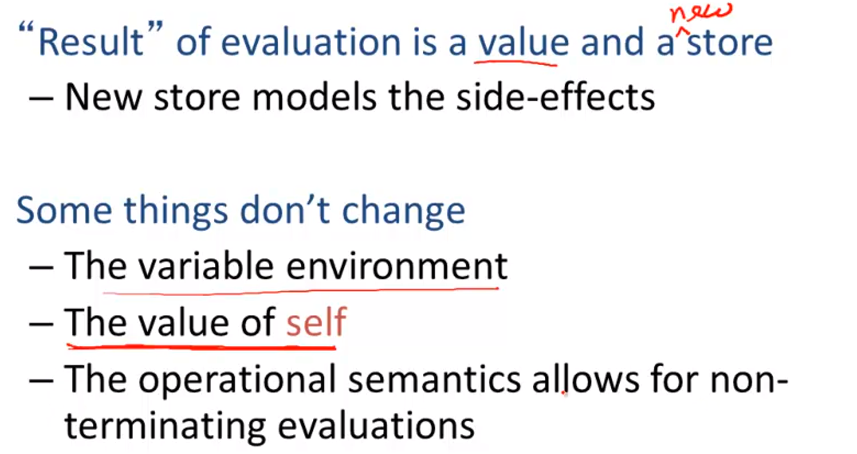
Cool Semantics

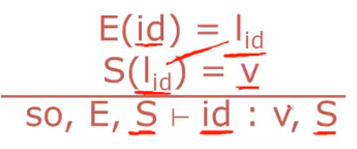
first we look up in the environment E where that identifier id is stored so now we give us back a memory
location l. So by in this case And then we look up in the store S what the value is at that memory locations, So,
we use the same memory location here as an argument to the store to get back the value that variable currently
has And notice I just have a reference, this is a read of memories so this is loading, I think it was loading the
value of the variable. This does not affect the store so the store S is the same before and after. This is just looking
at the value

assignment
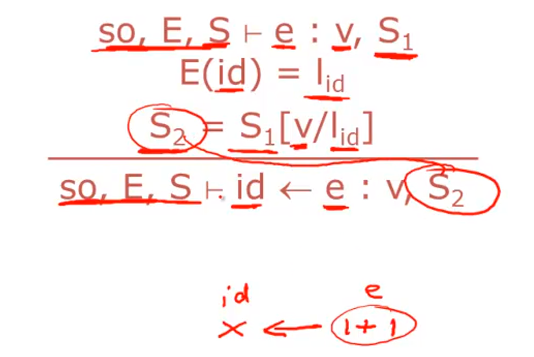

we modify the store at that point with the new value so we replace the location l id or we update the value of l, i, d to be the value of v and we do that in store s1 which gives us a new store s2.


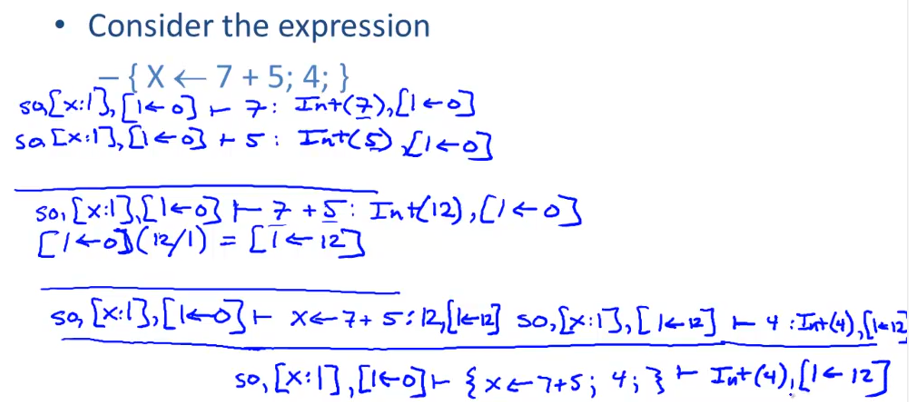

if else

while


let
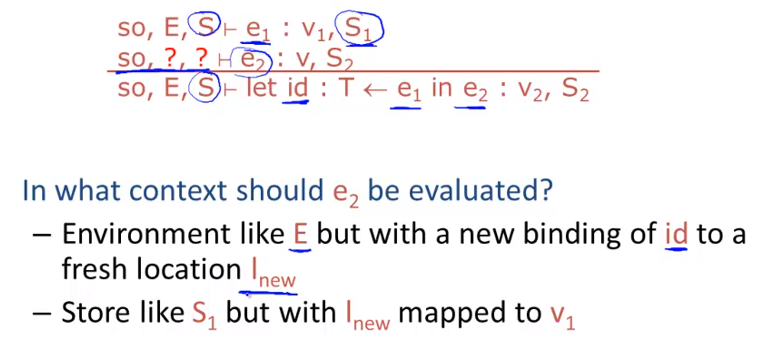

Cool Semantics II
new
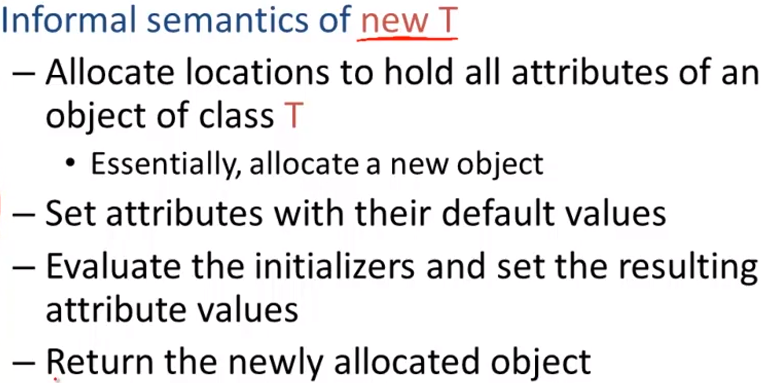
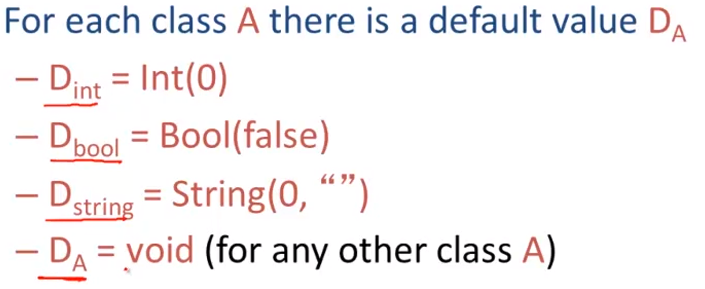
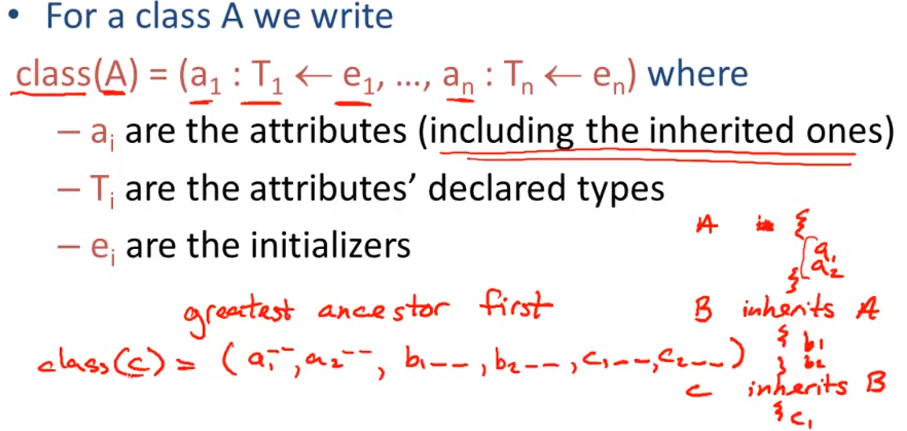

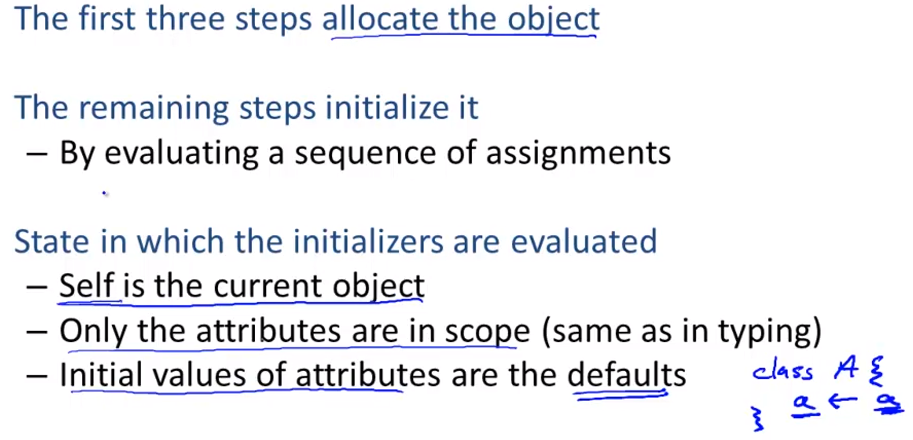
dynamic dispatch
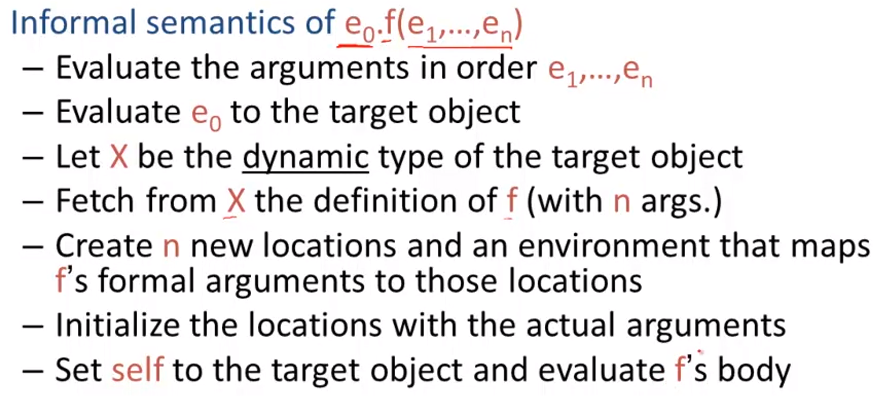
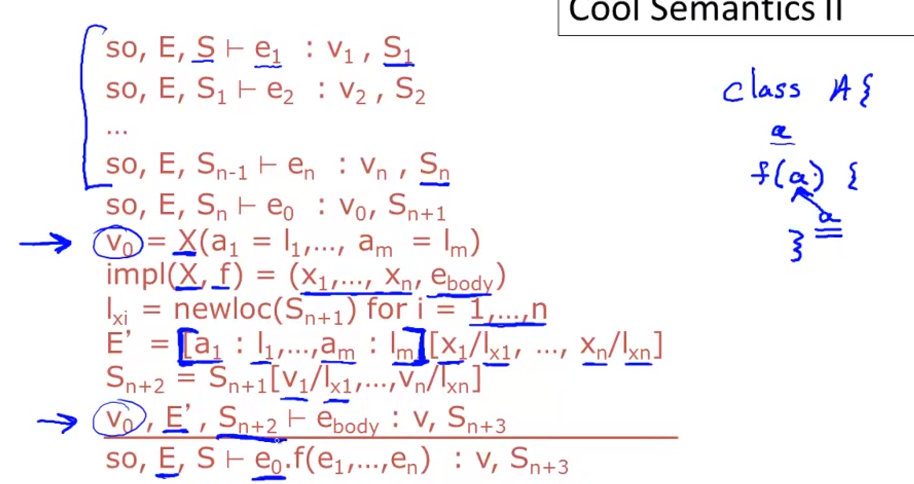
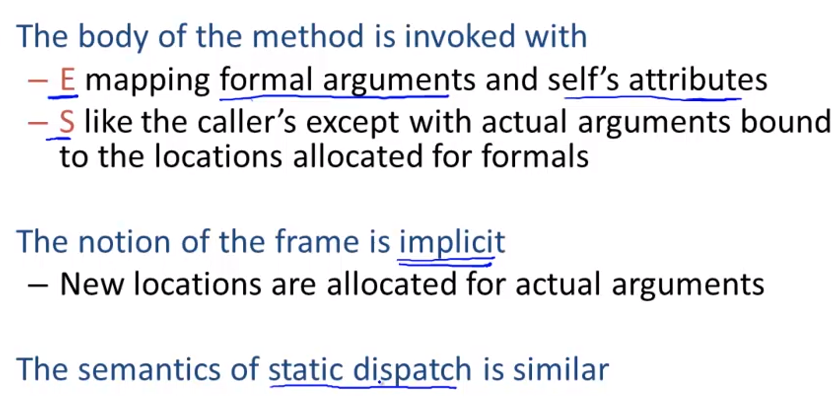
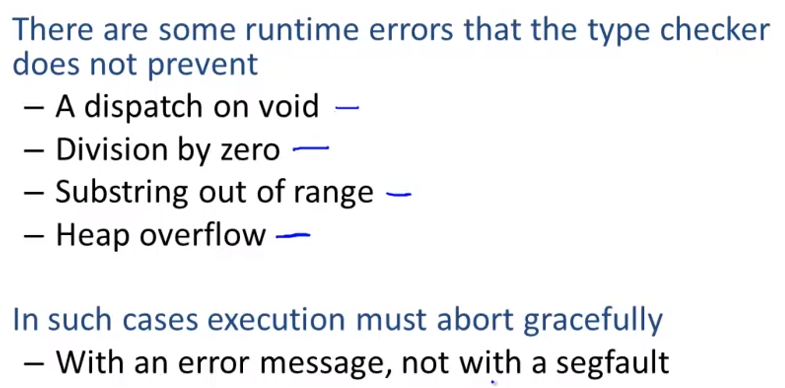

PA5
优化 Optimization
Intermediate Code
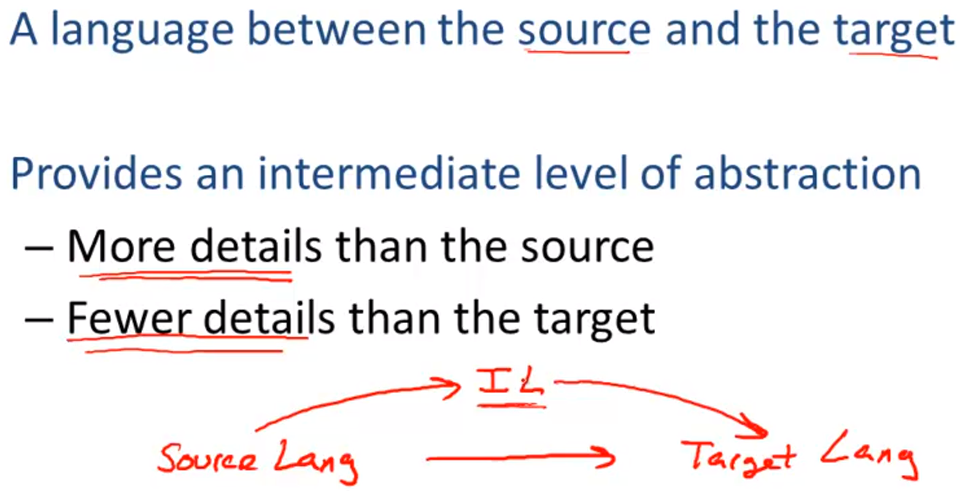
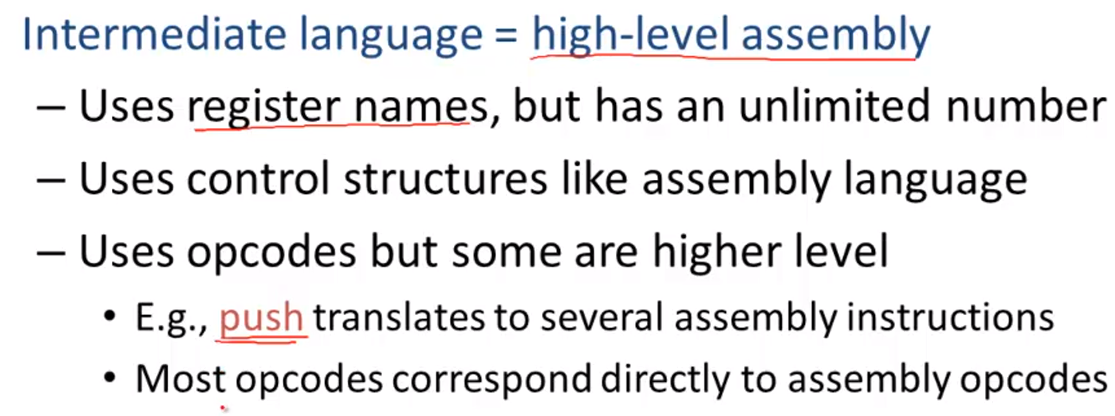
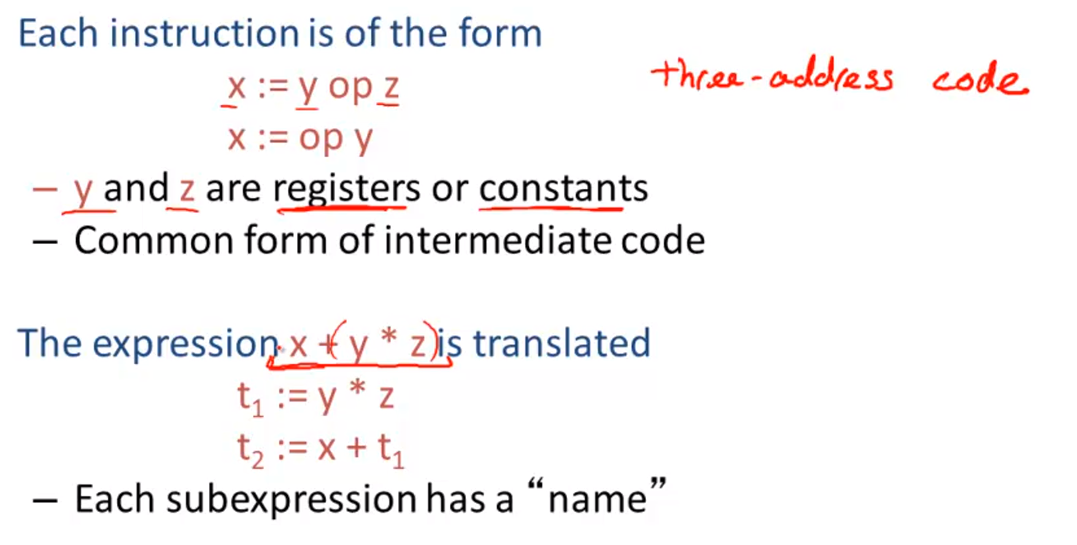
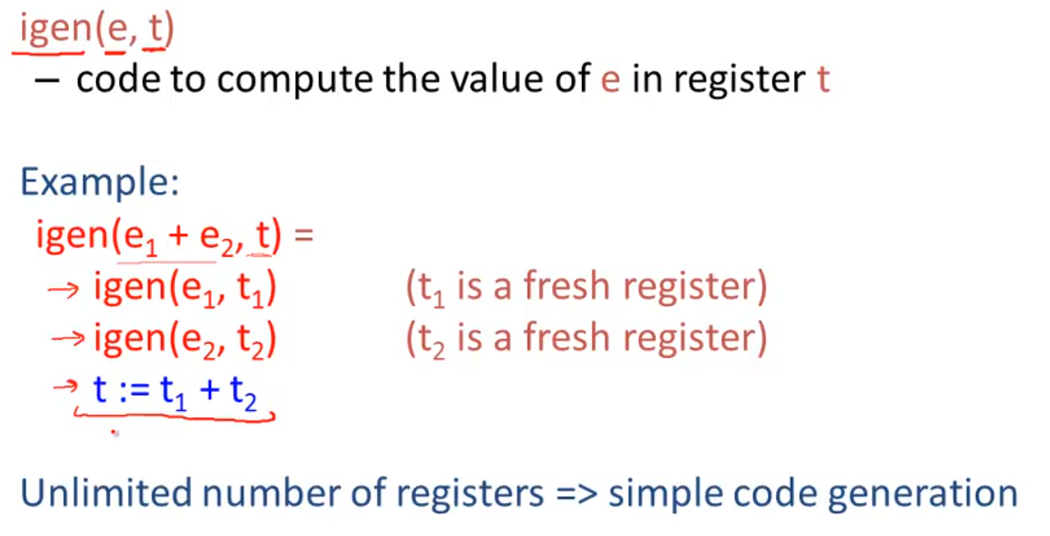
Optimization Overview
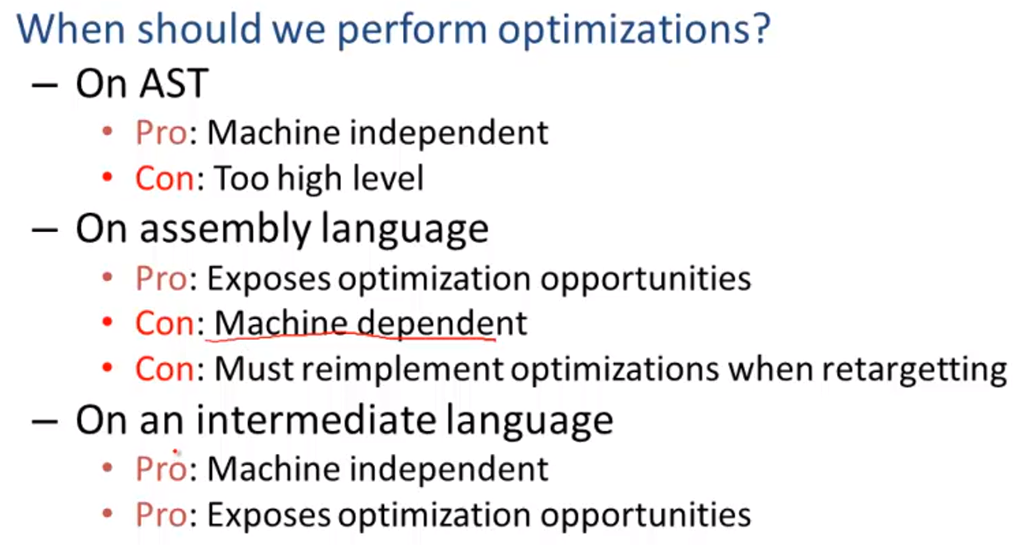
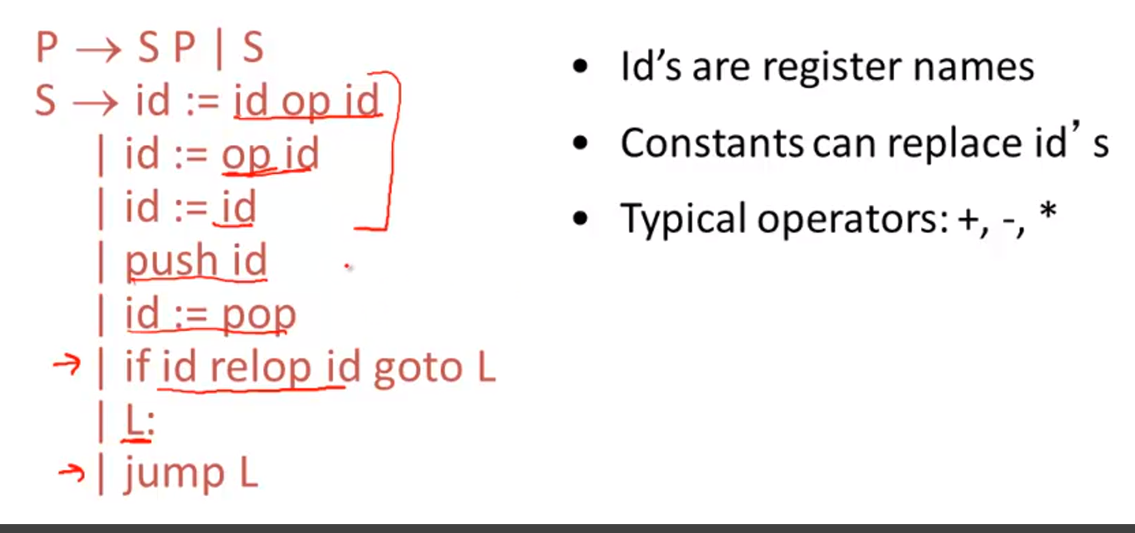
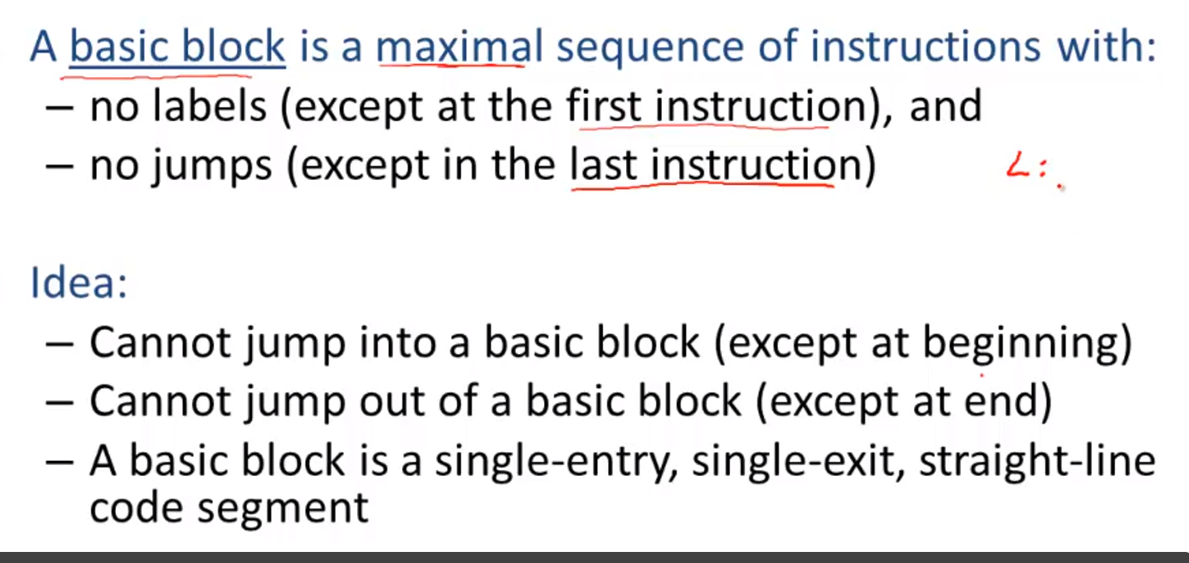
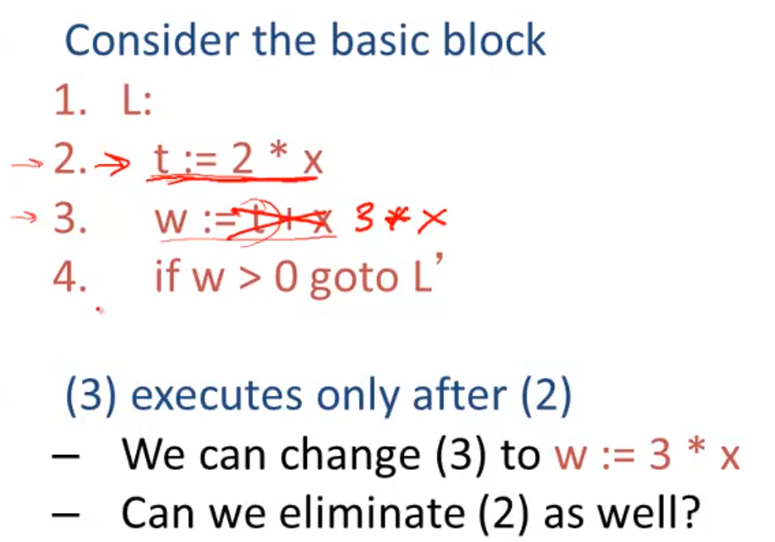
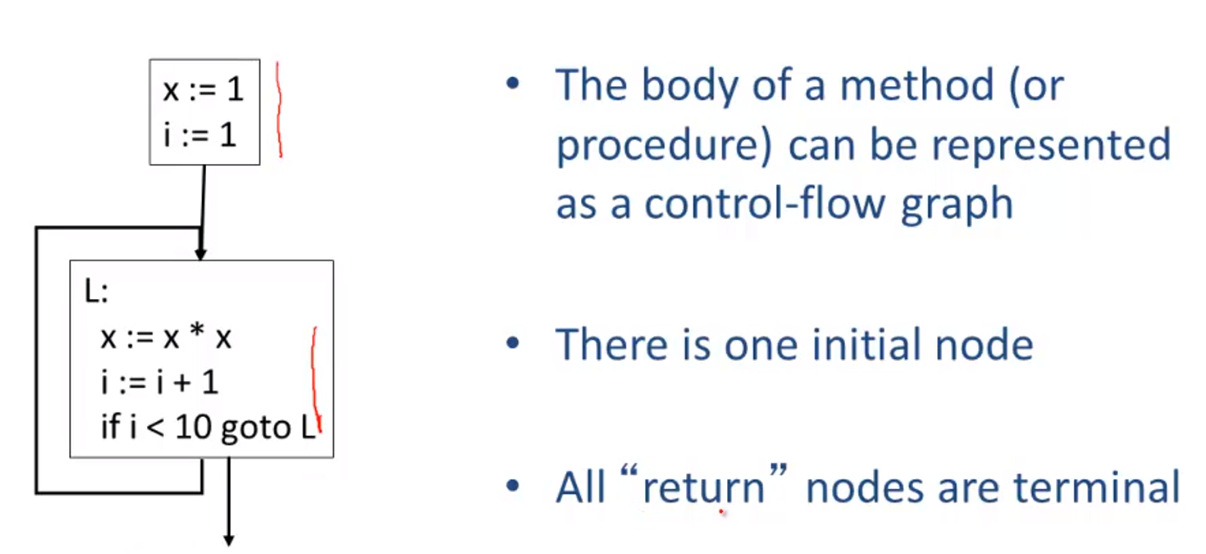
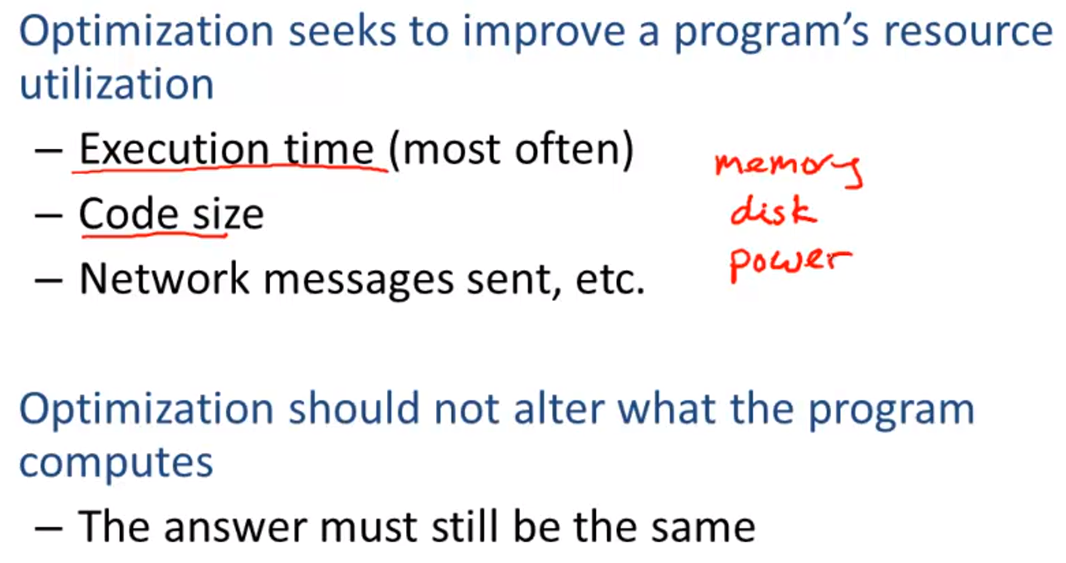
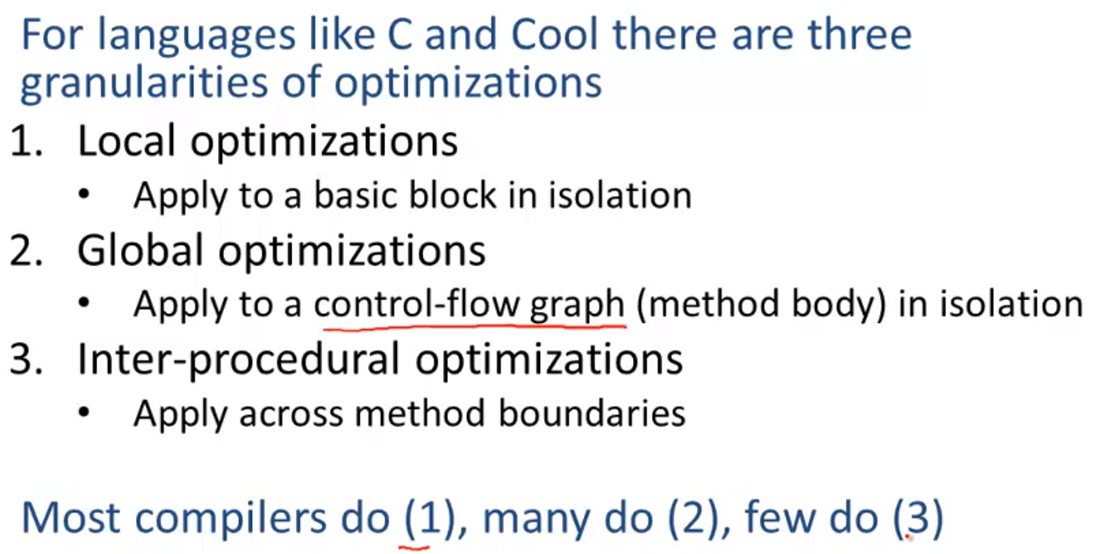

Local Optimization
有些可以删除的
x = x + 0
x = x * 1
有些可以简化的
x = x * 0 => x =0
y = y ** 2 => y = y * y
x = x *8 => x = x << 3
x = x * 15 => t = x << 4;x = t - x;
(一些机子上«比*号快
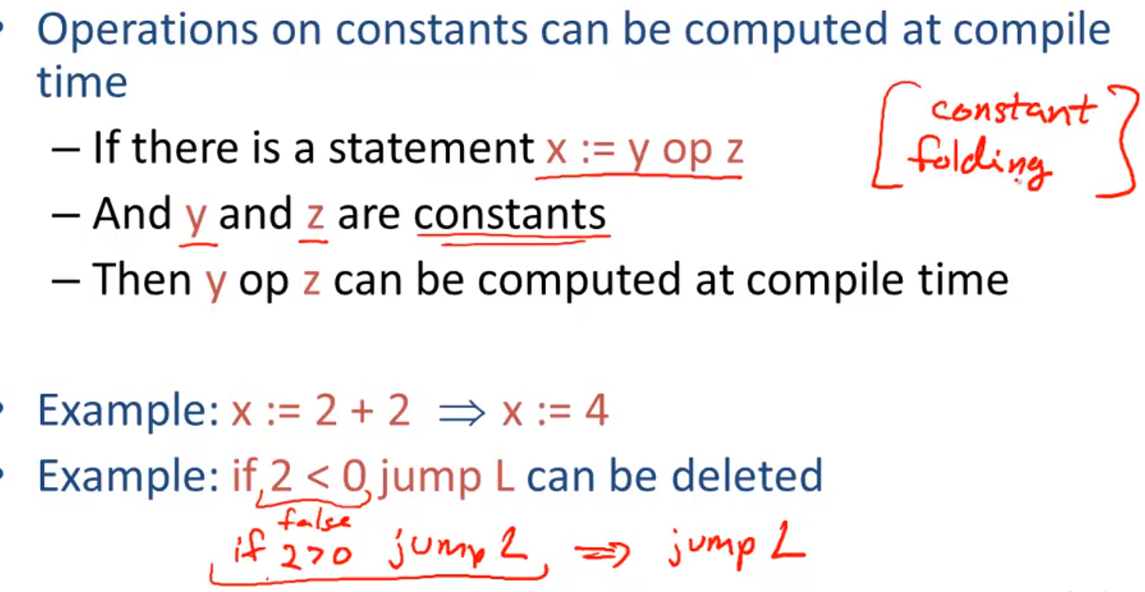
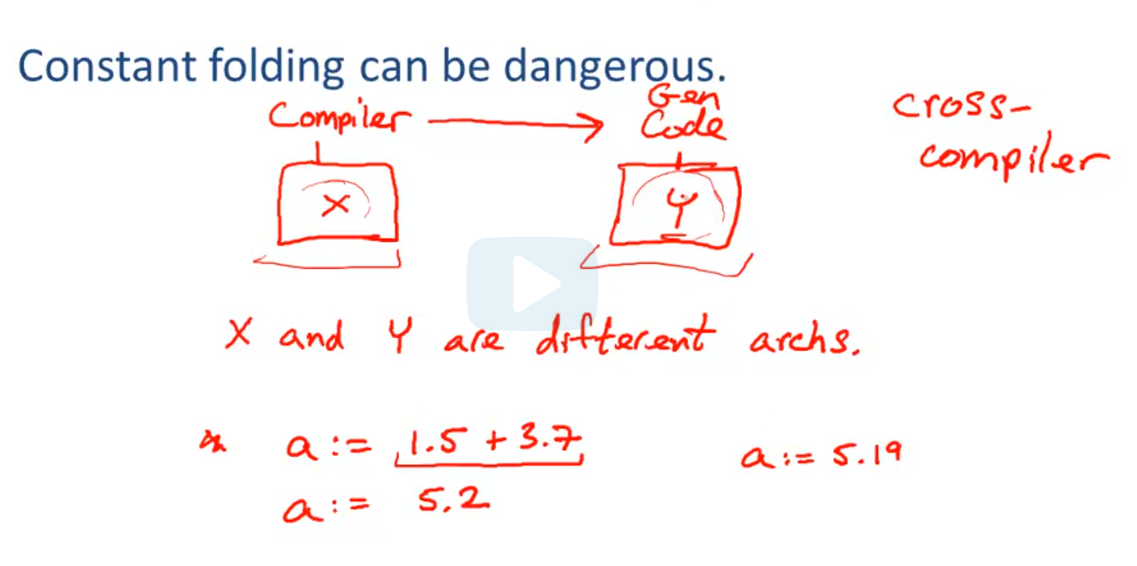
保留最高精度的浮点数,让架构决定计算结果

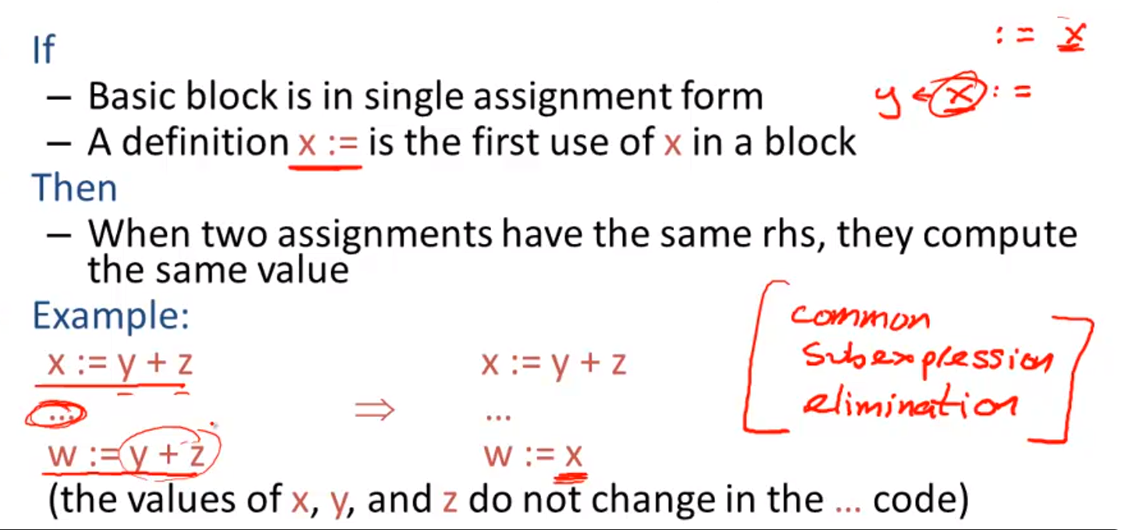
Peephole Optimization
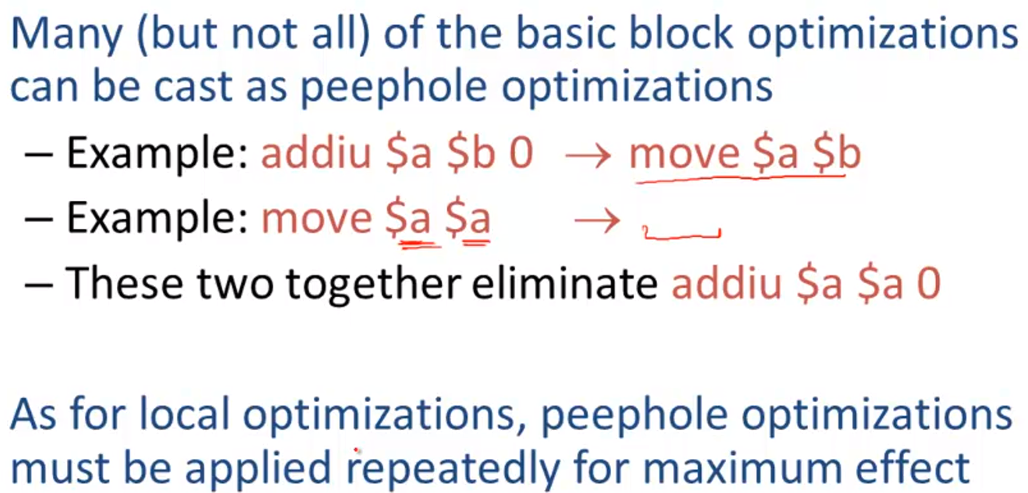
Dataflow Analysis
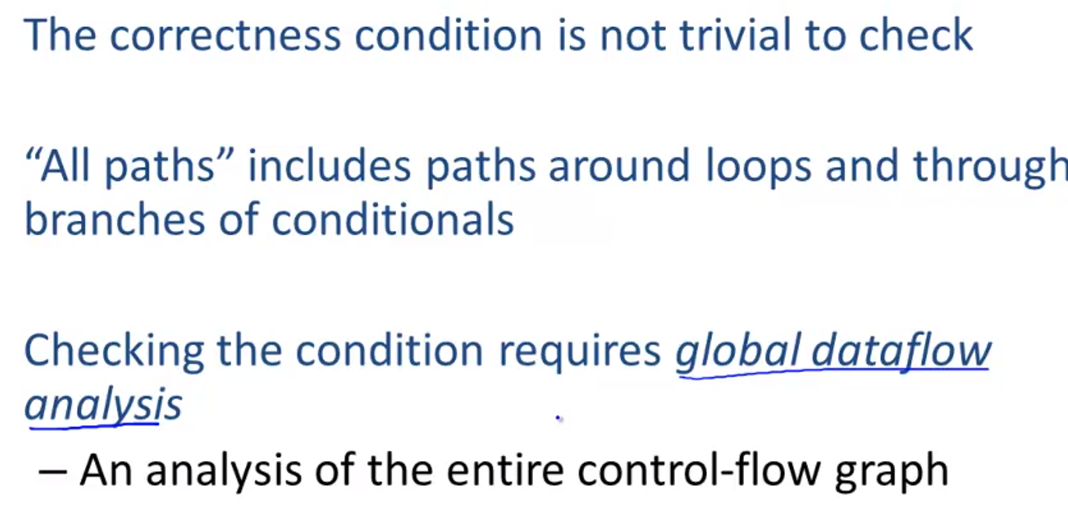
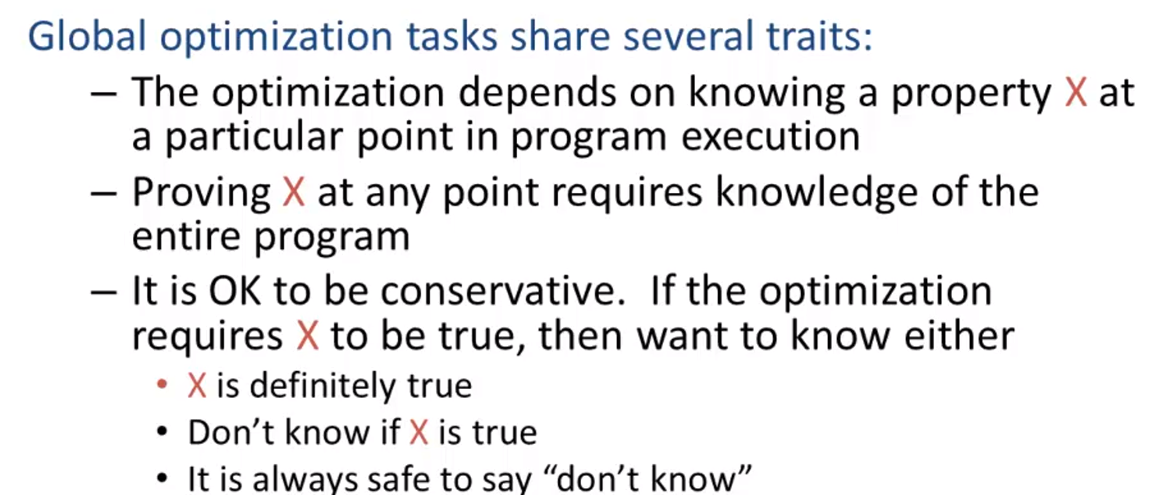
Constant Propagation
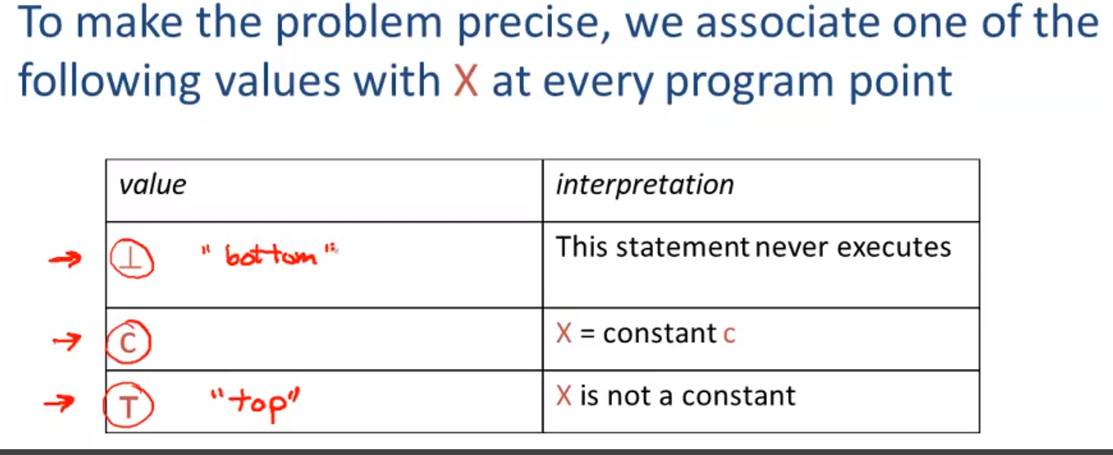
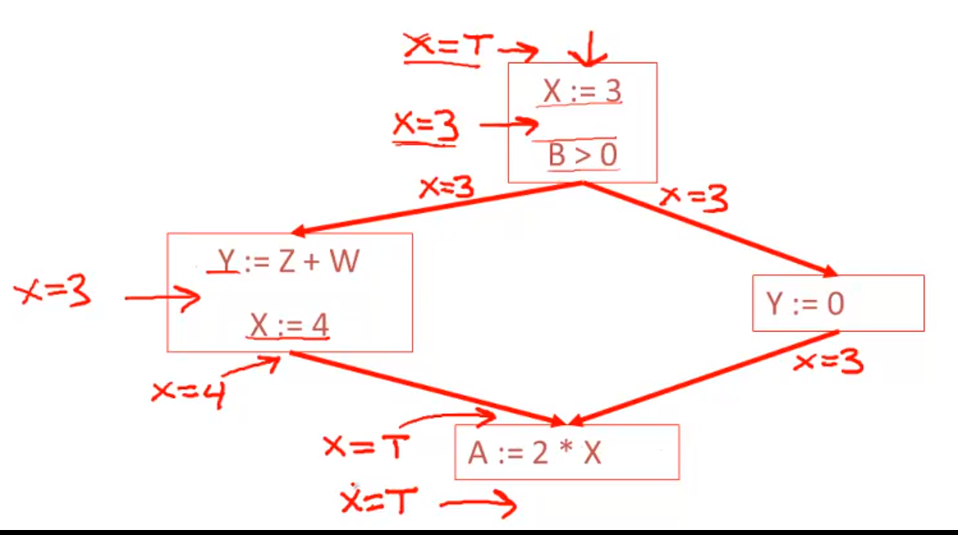
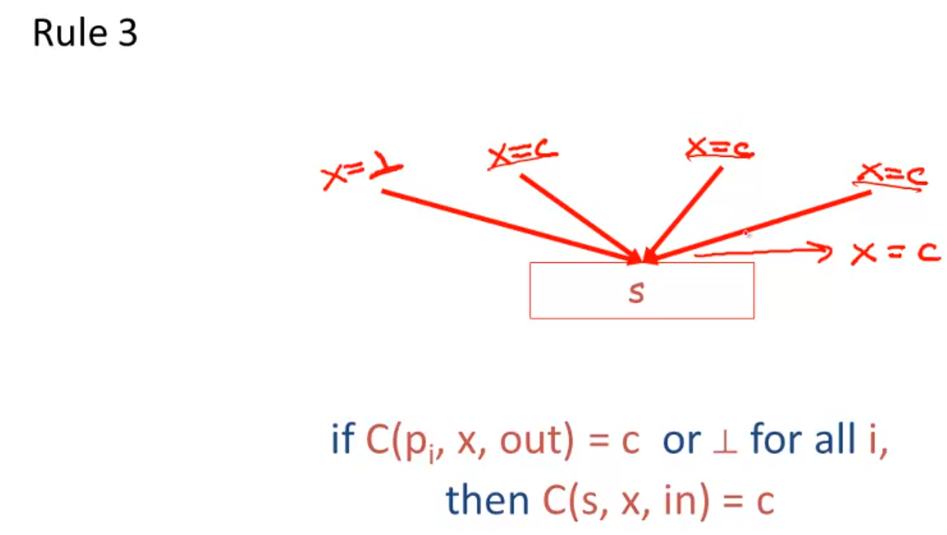

Analysis of Loops
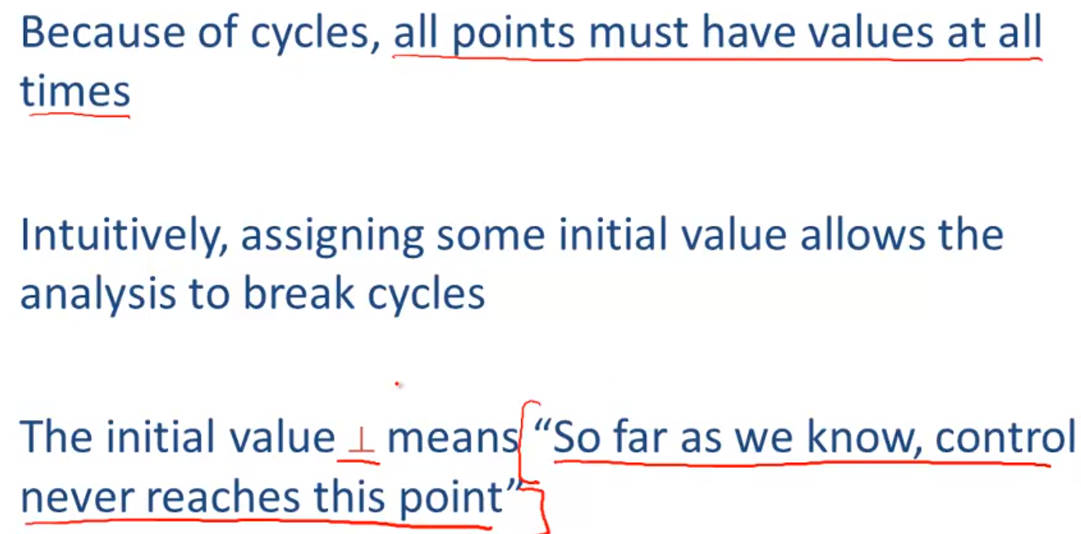
Orderings
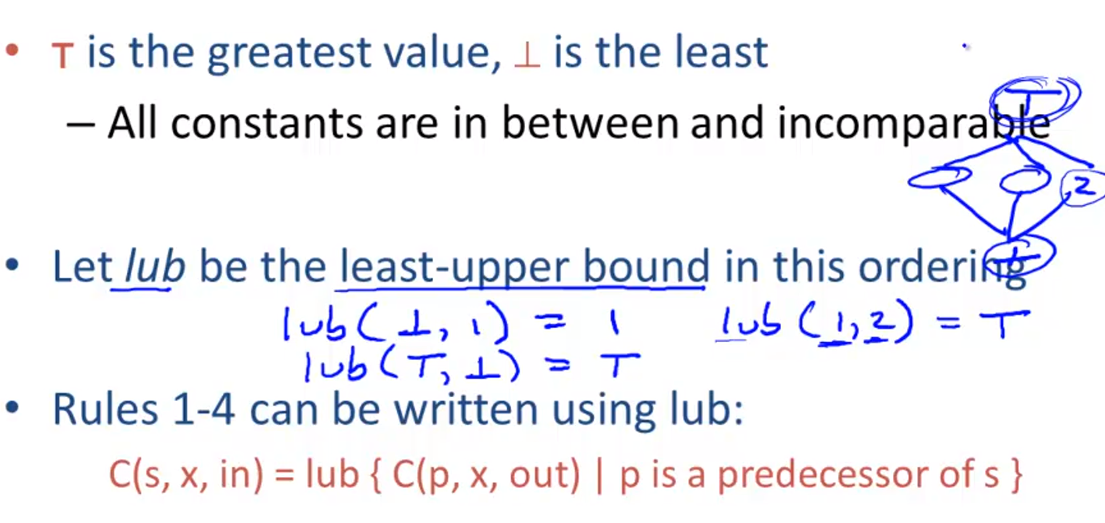
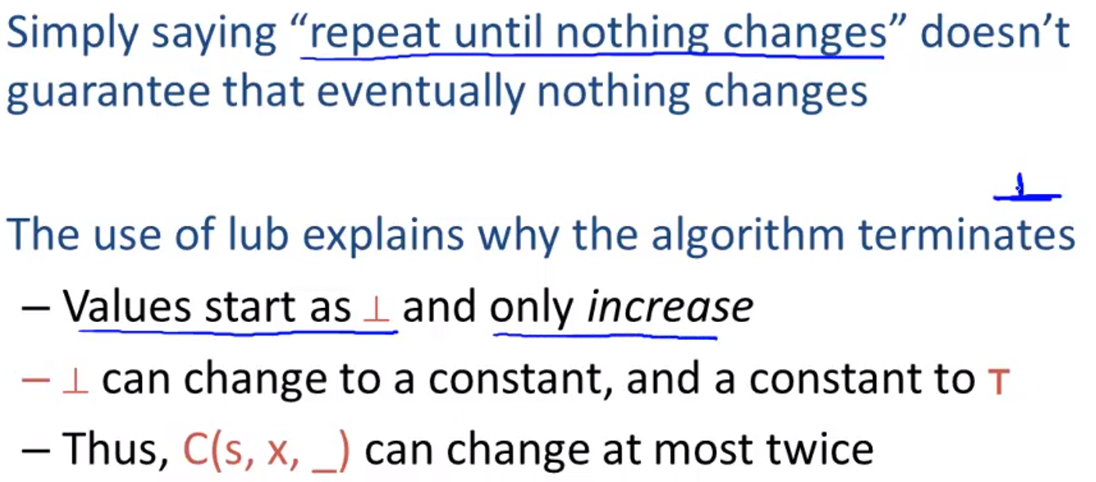
Liveness Analysis



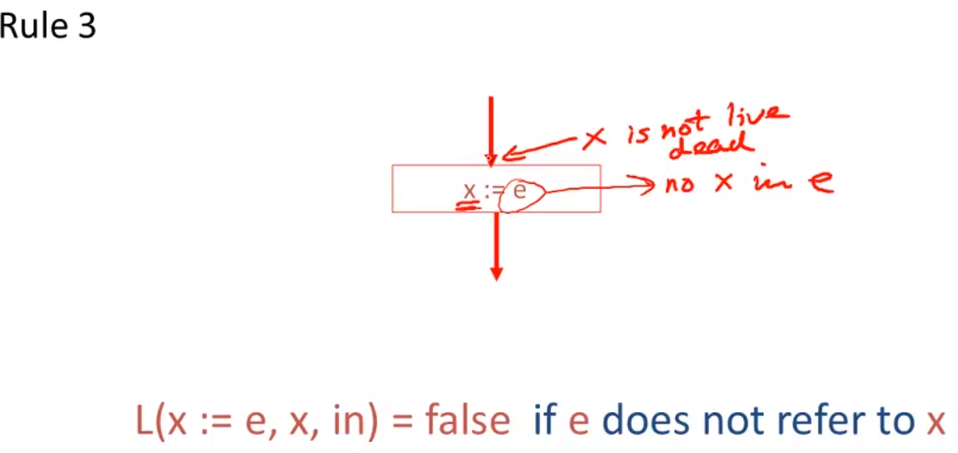
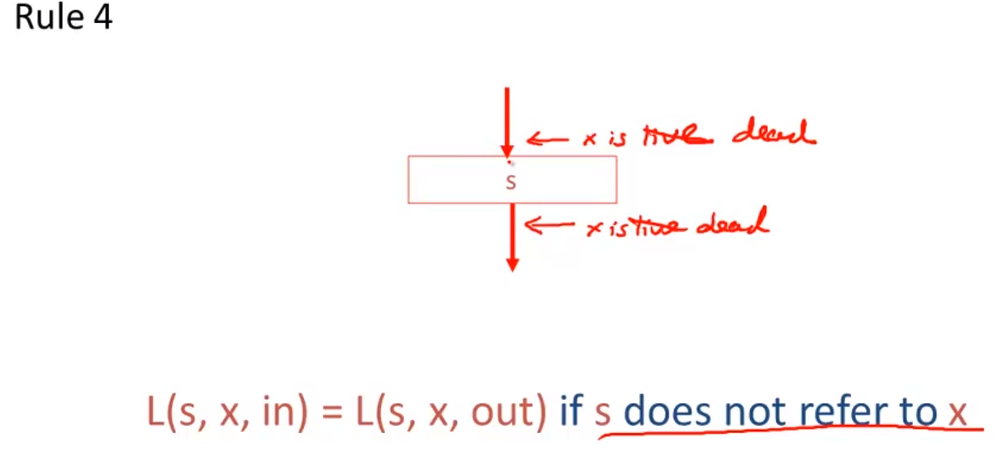
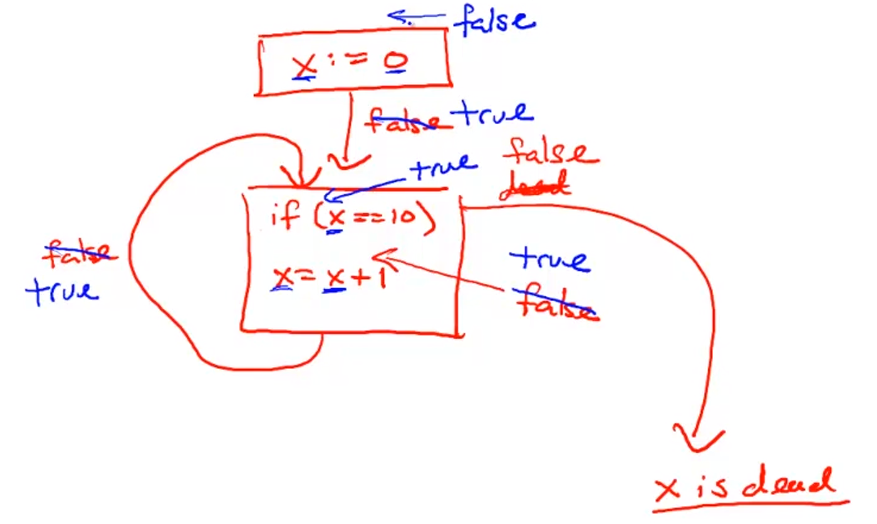
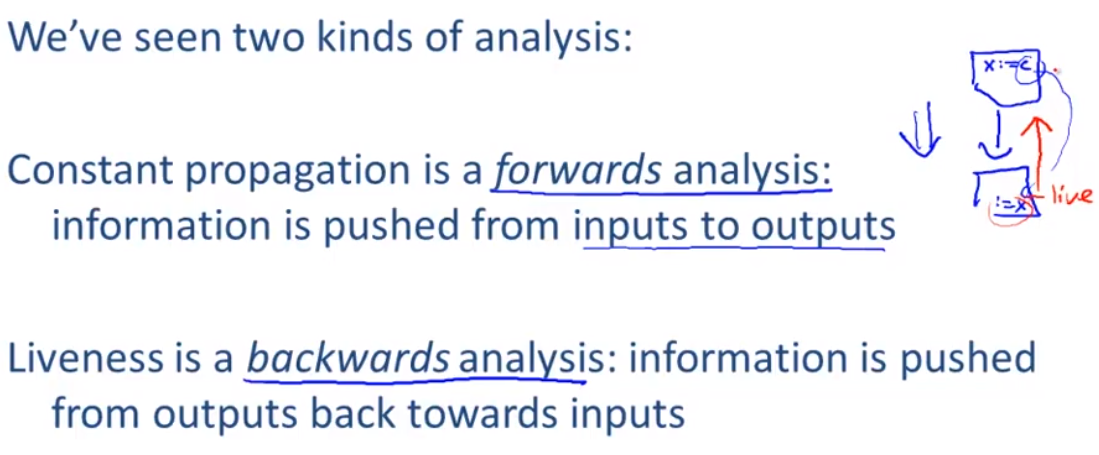
Register Allocation
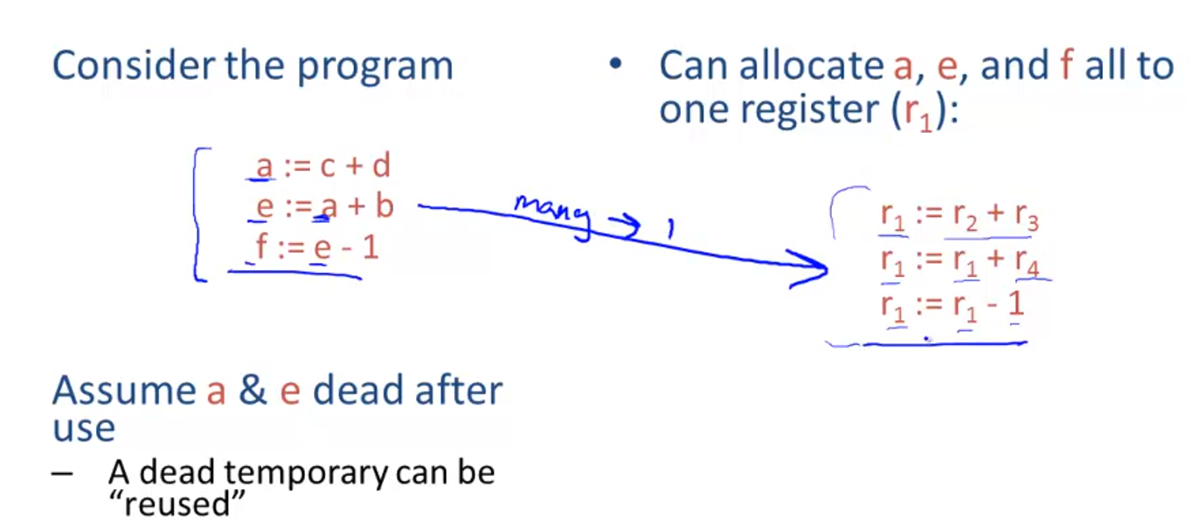
principle

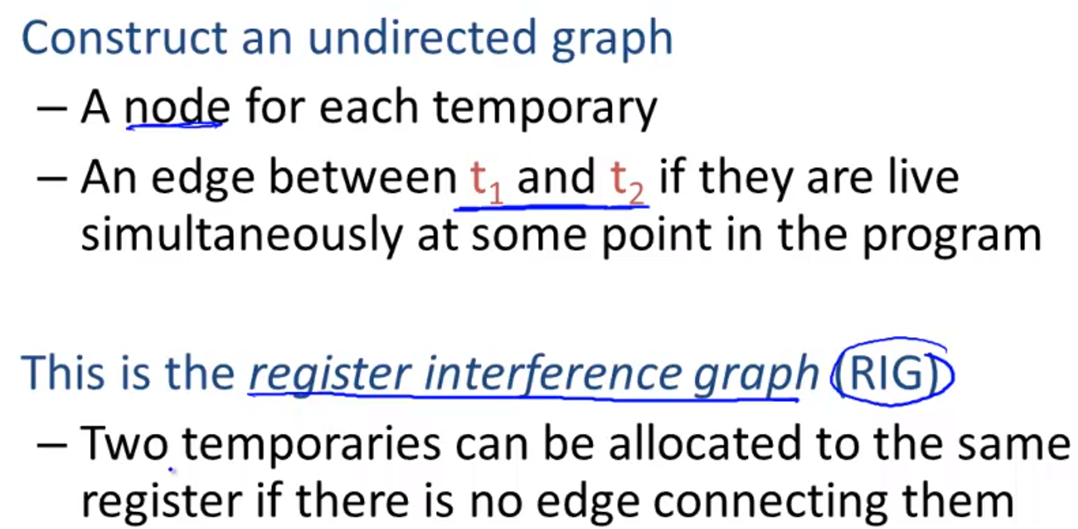
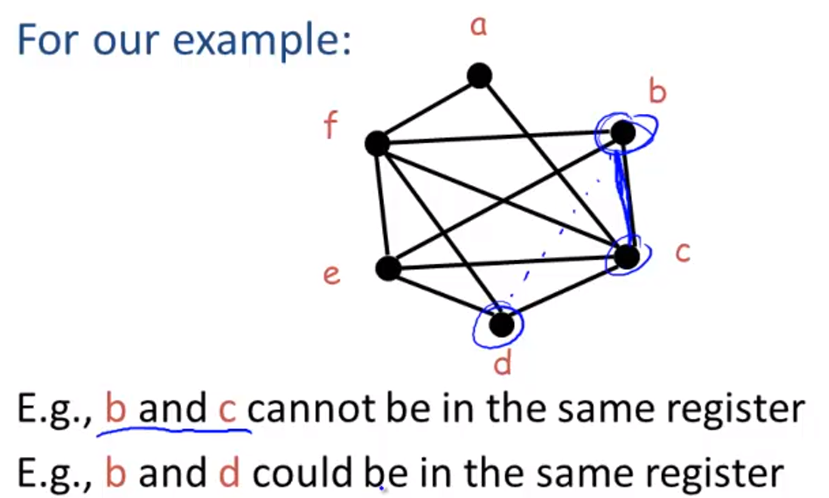

Graph Coloring
A coloring of a graph is an assignment of colors to nodes, sch that nodes connected by an edge have different colors.
A graph is k-colorable if it has a coloring with k colors.In here, colors = registers. Let k = number of machine registers.
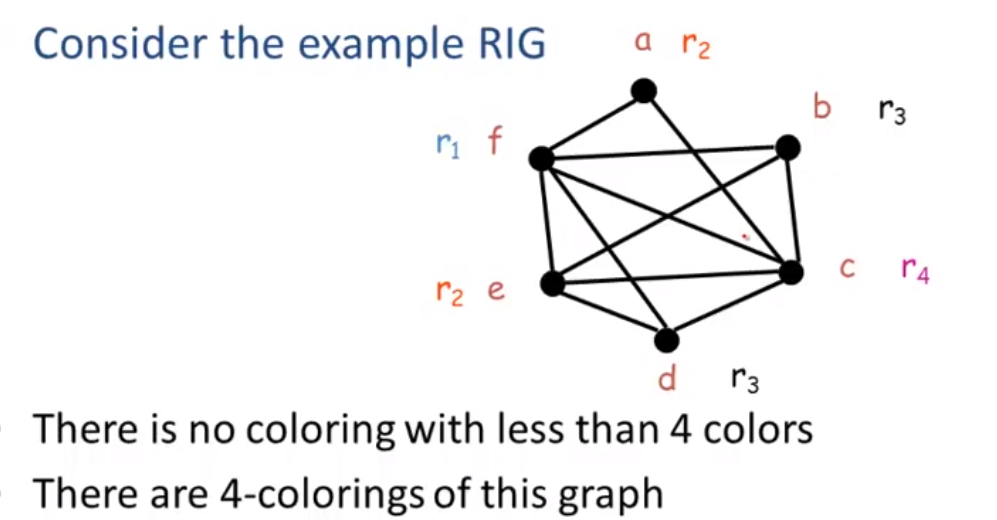
再用寄存器名字替换
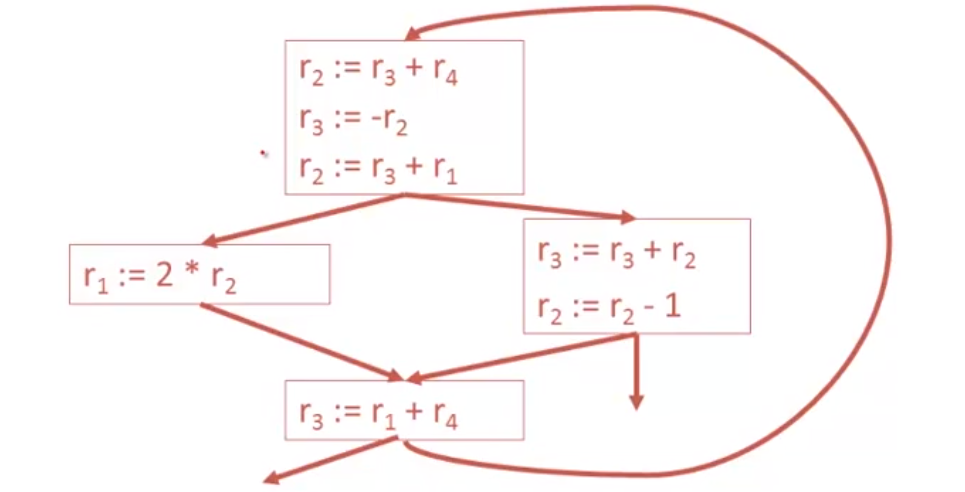
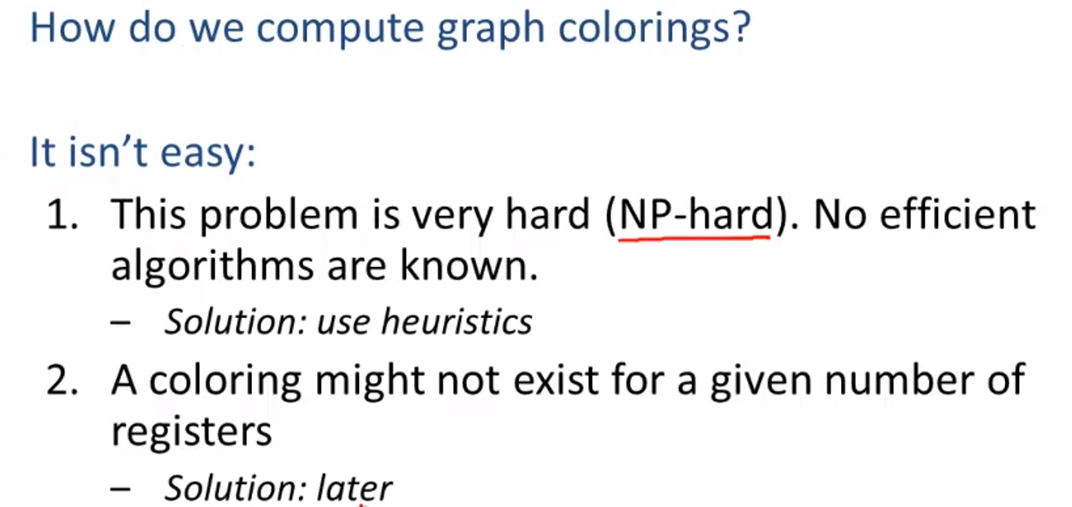
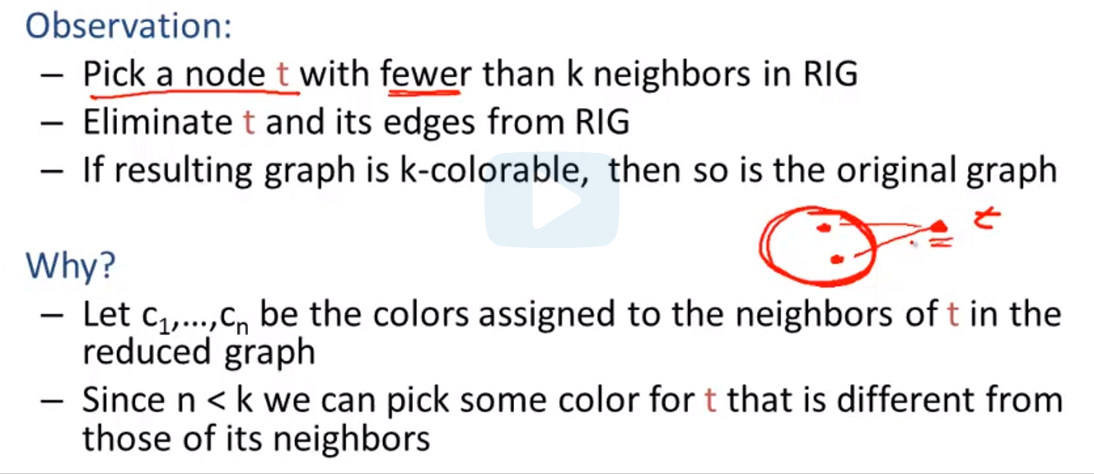
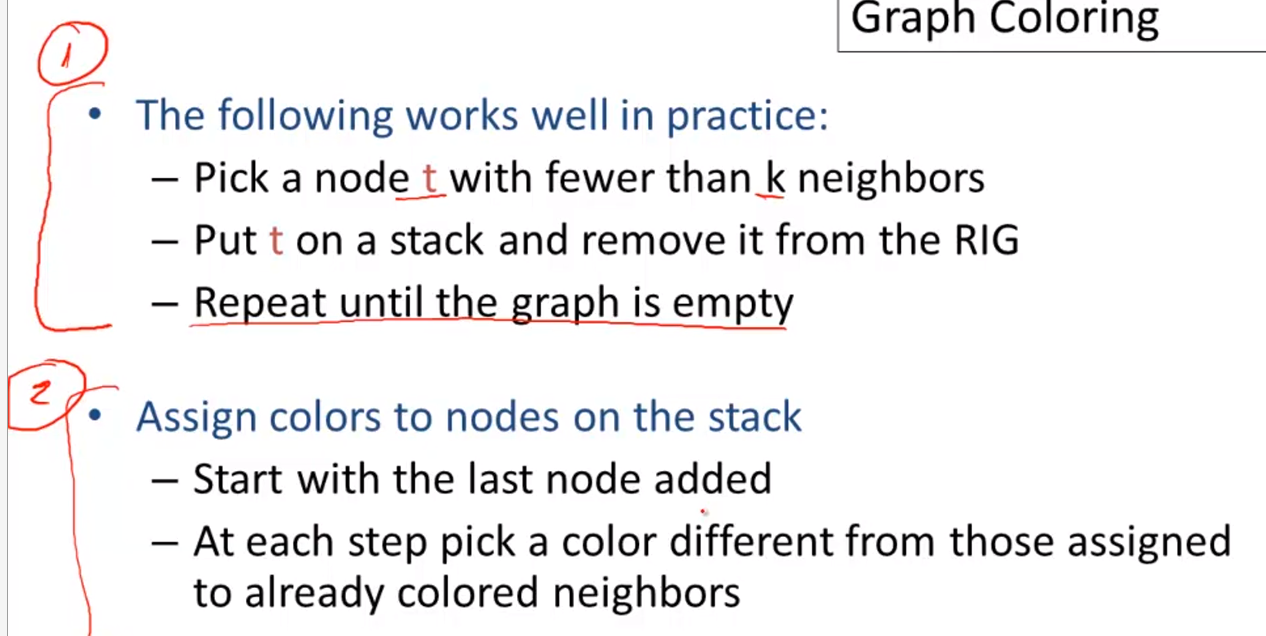
example
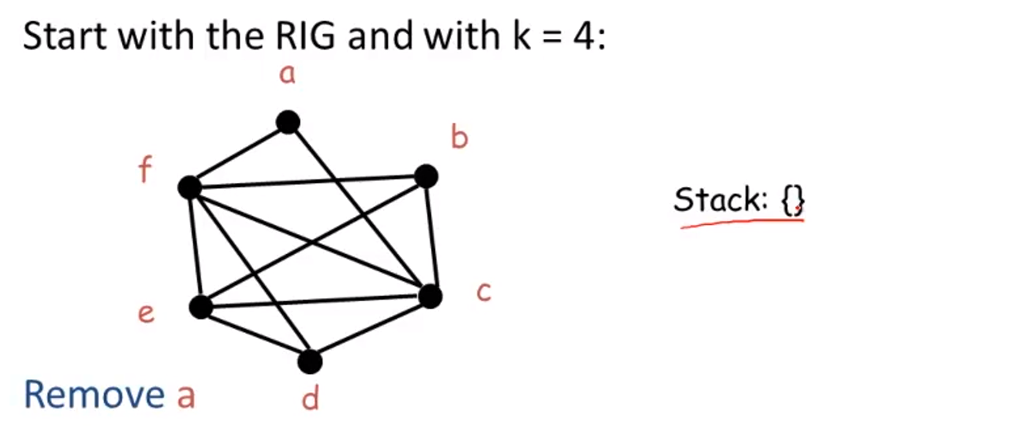
Remove d Stack:{d,a}

now it doesn’t matter which node we pick because we can process them in any
Remove c,b,e,f
now Empty-graph - done with the first part

going to pick the lowest numbered register that is not used by any of its neighbors.

b is the only register that isnt used
Spilling
if tgere’s no node that we can delete from the graph, in this situation, we’re going to pick and know that there is a candidate for spilling.
- A spilled value “lives” in memory
optimisitic coloring => hope that among the 4 neighbors of f we use less than 3 colors
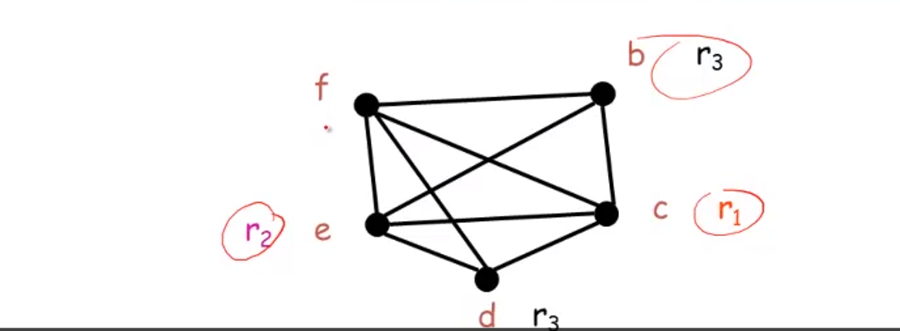
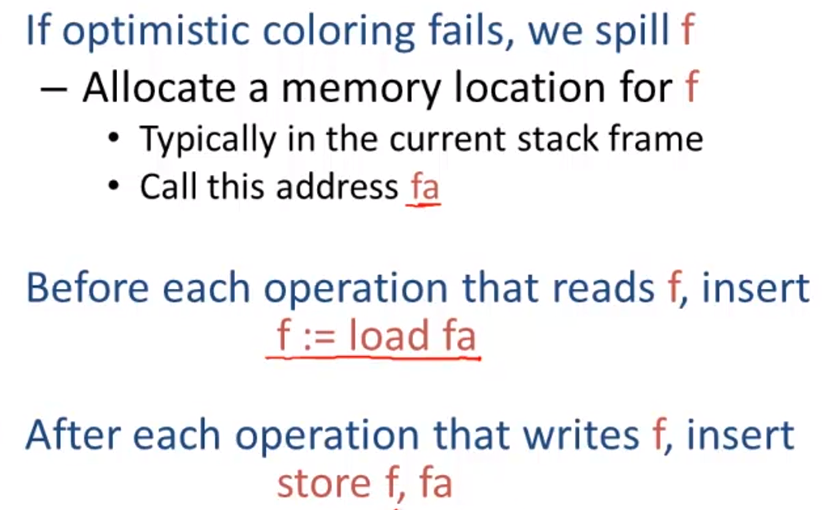
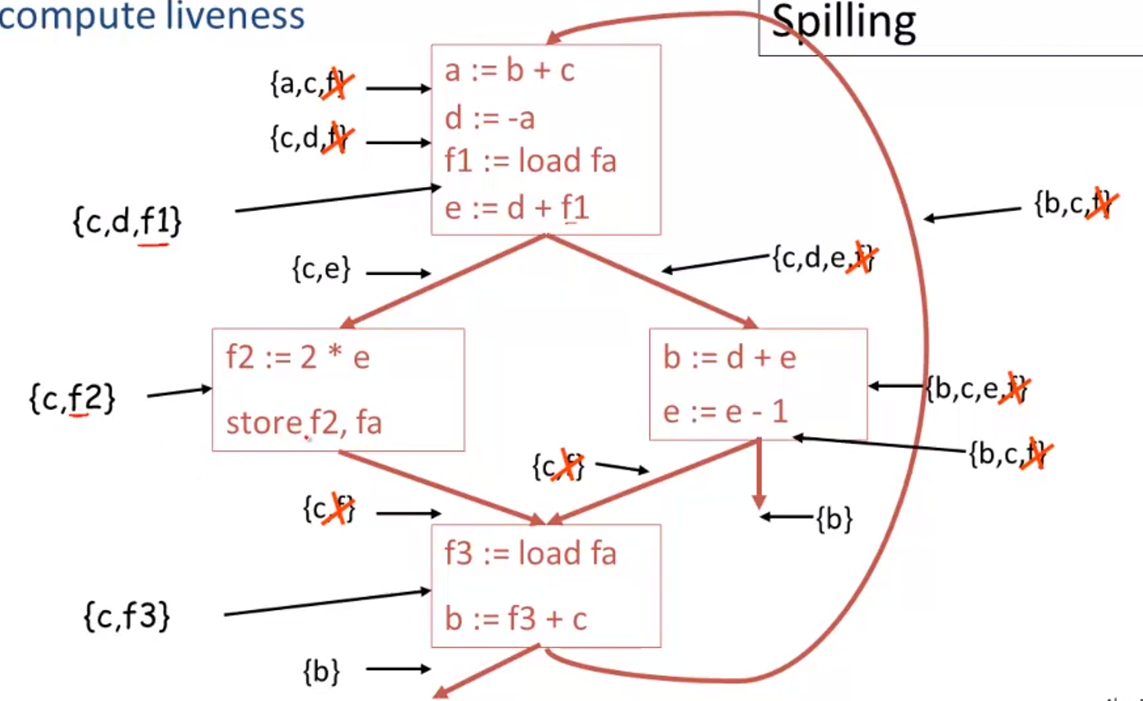
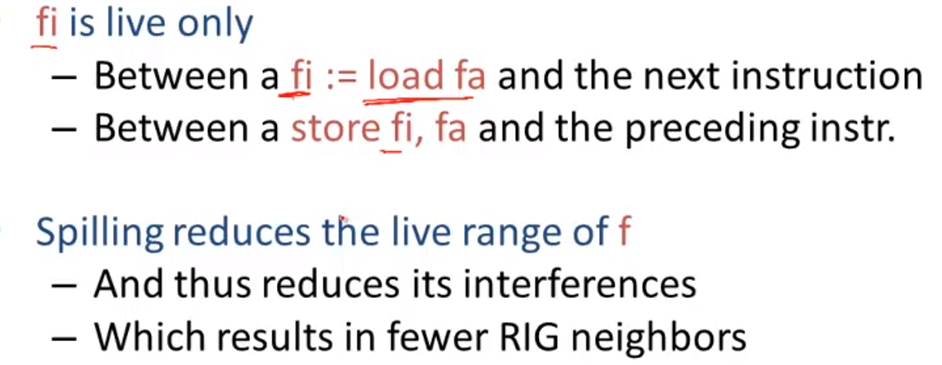
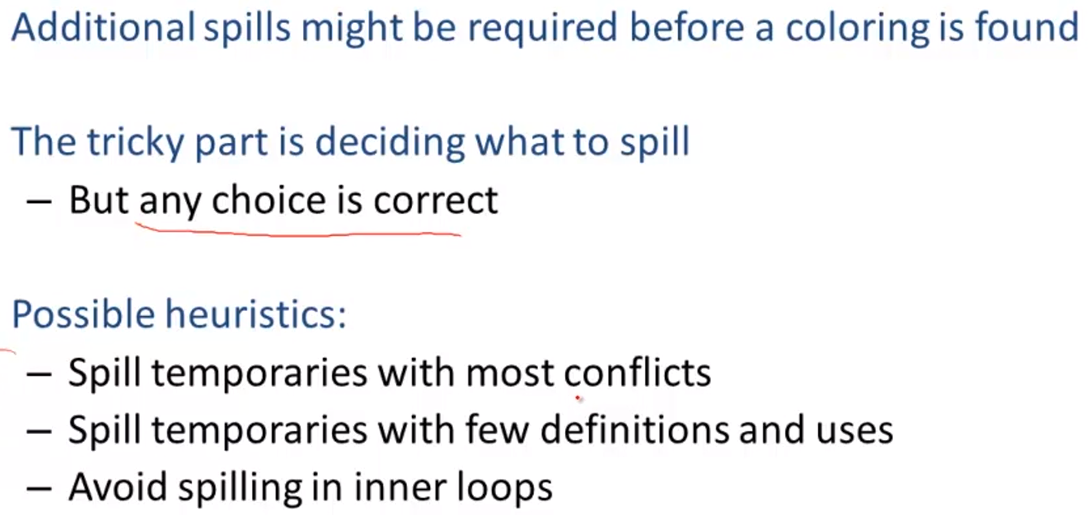
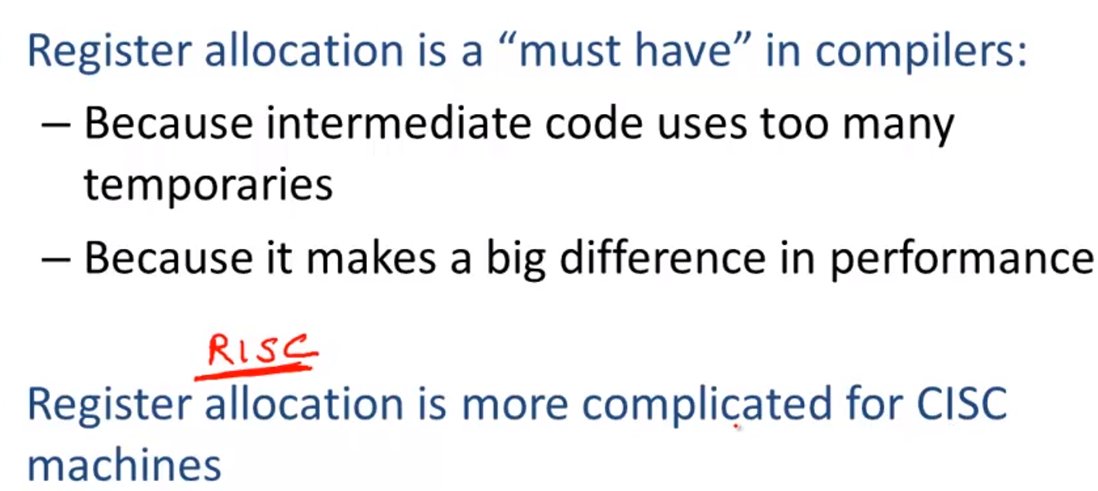
Managing Caches
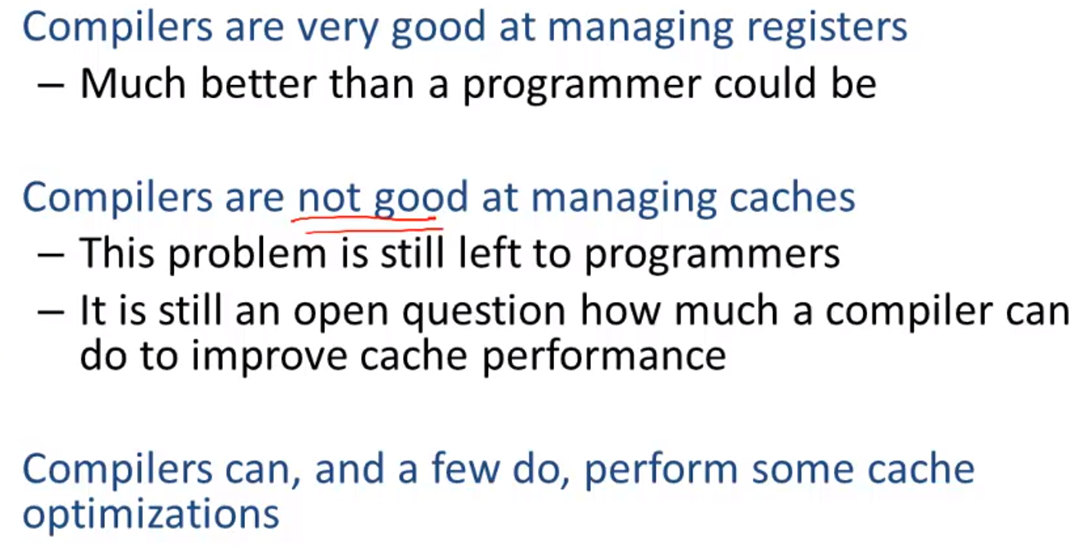
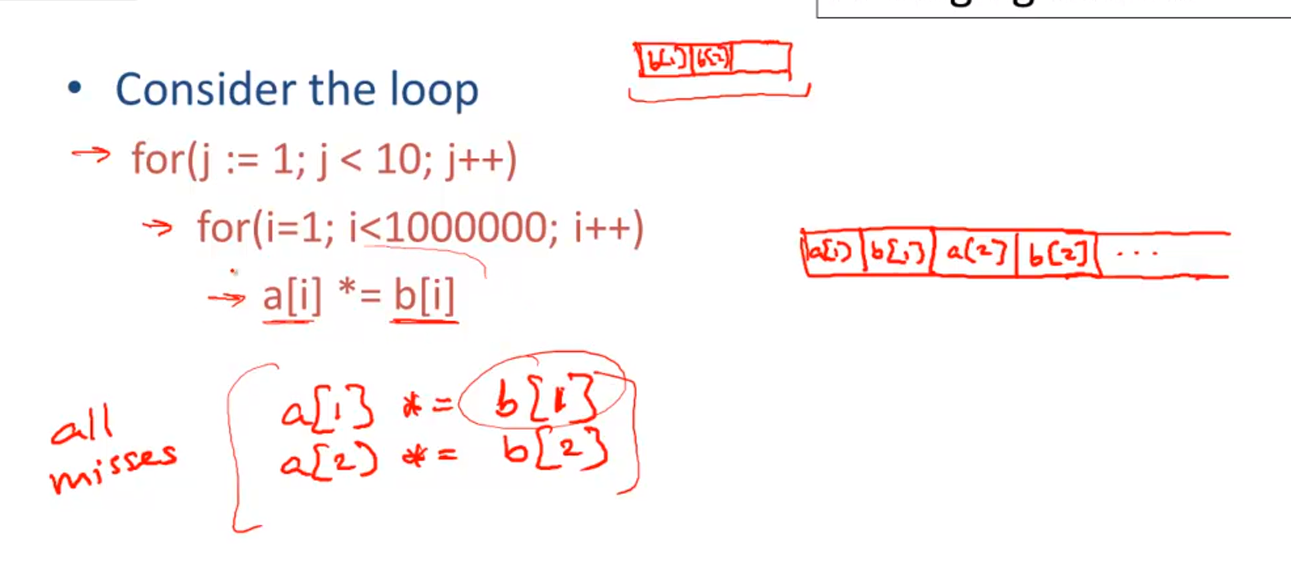
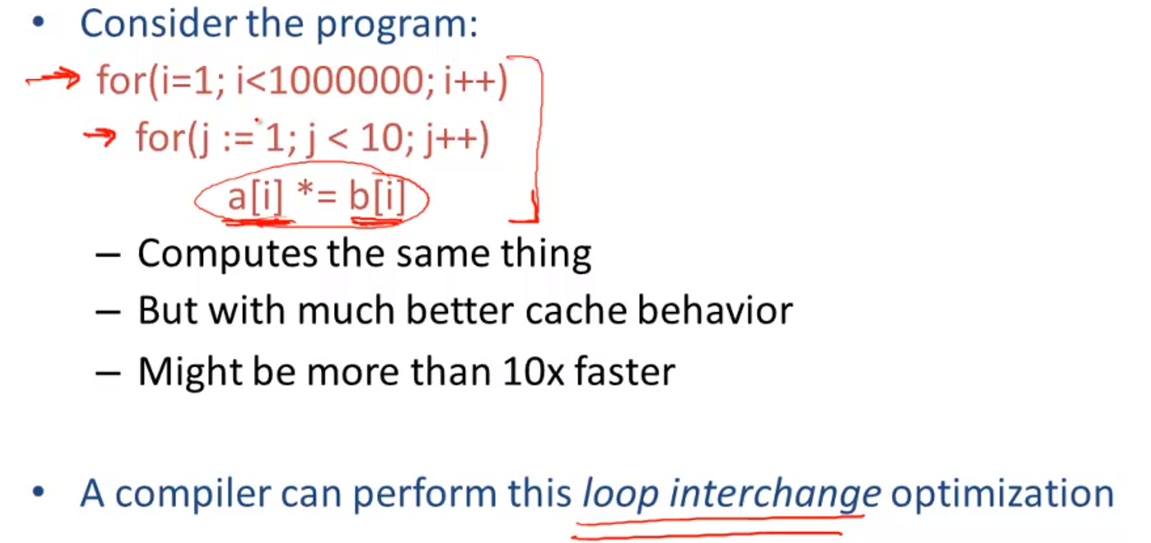
Garbage collection
Automatic Memory Management

How to know an object will “never be used again”?

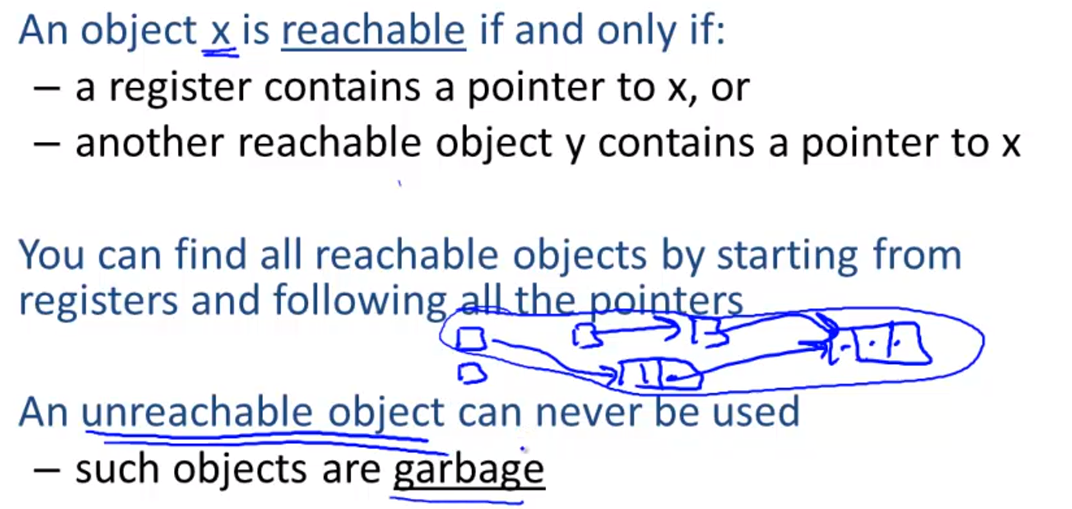
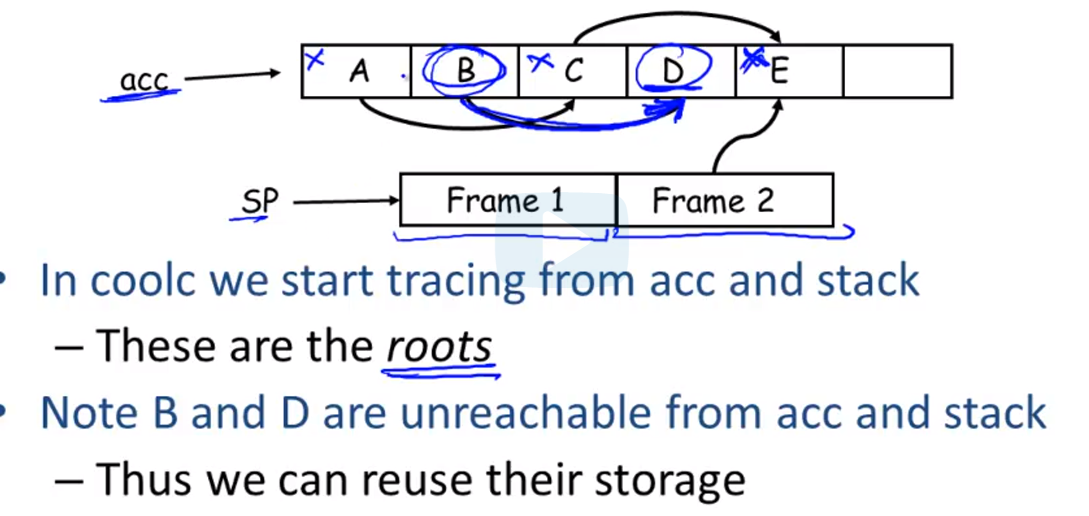
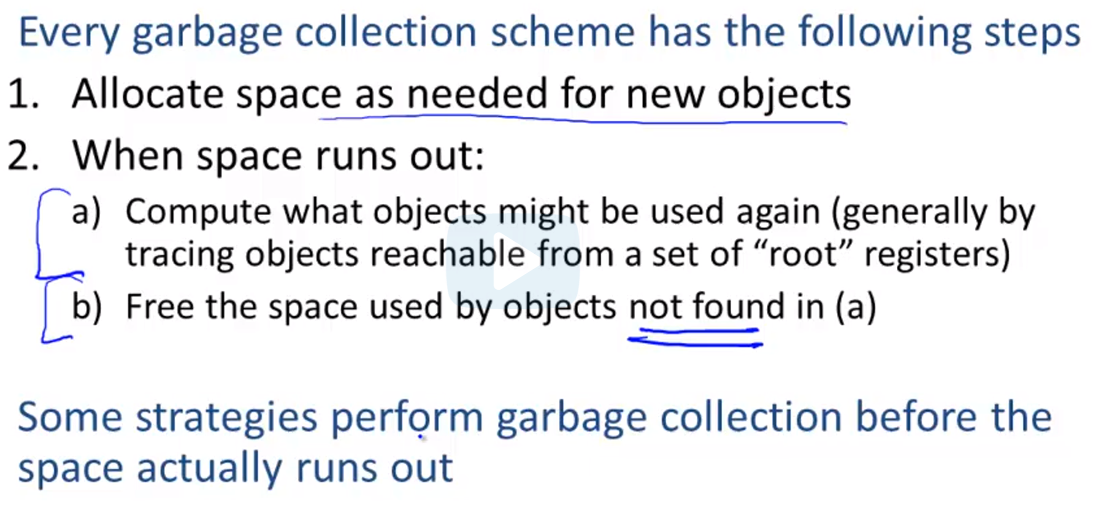
Mark and Sweep
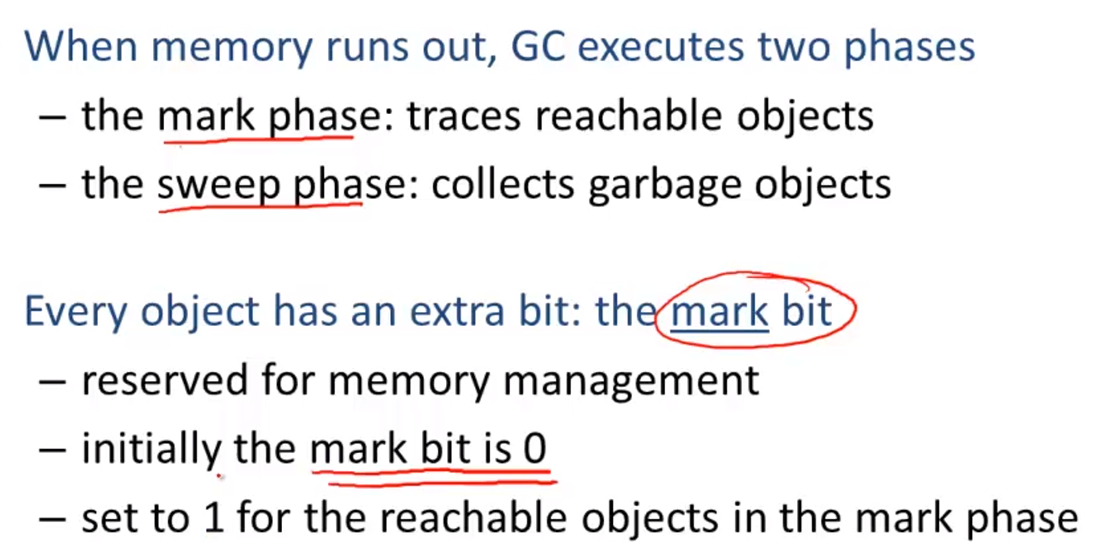

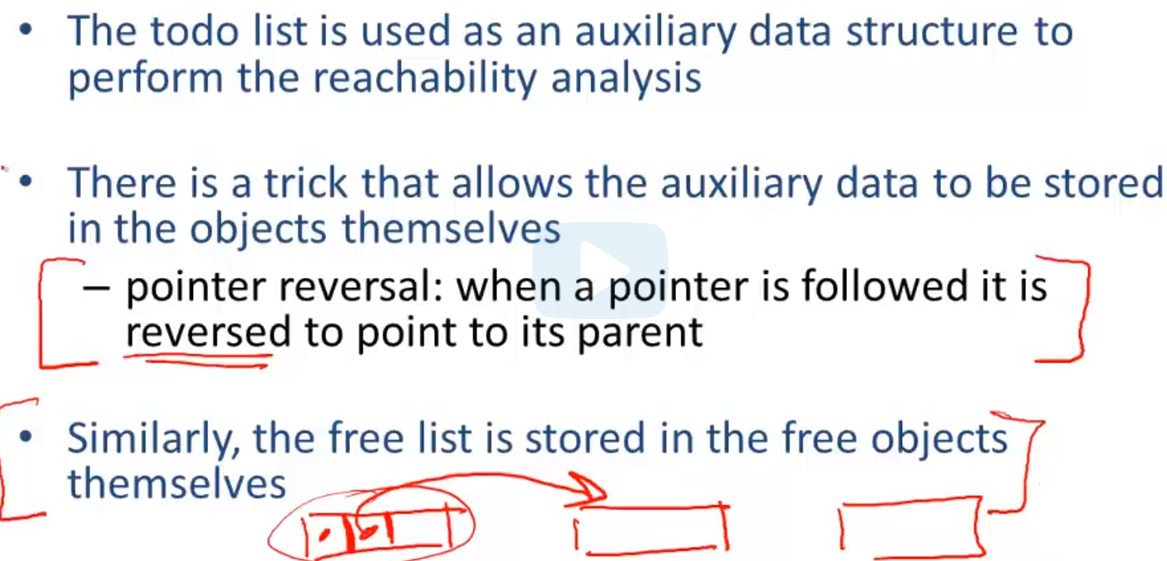
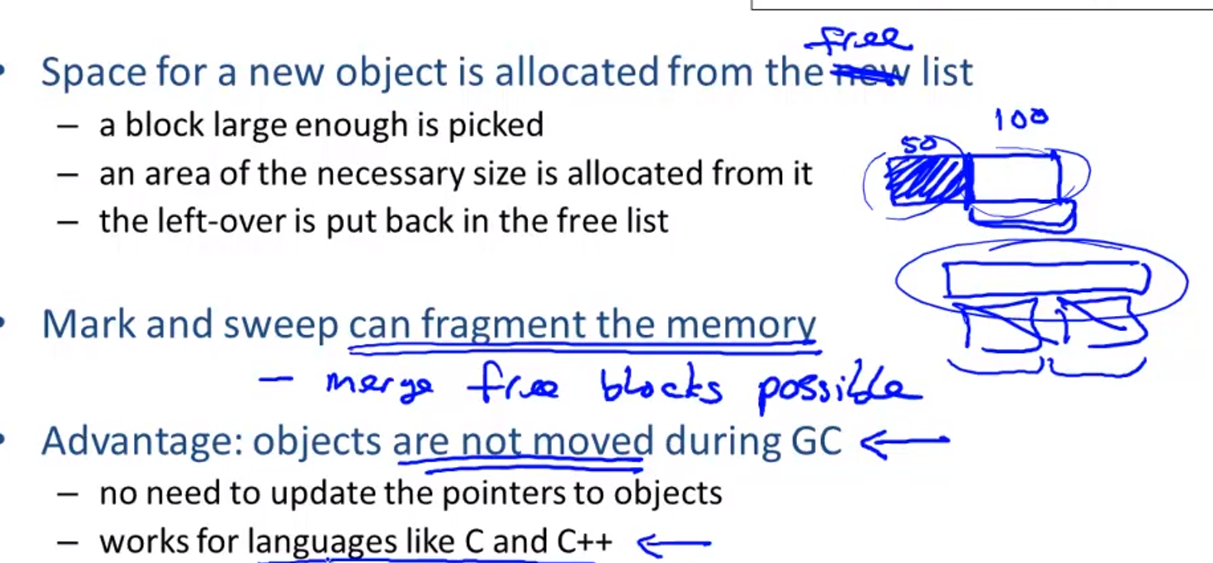
Stop and Copy
当旧区域满的时候,将有用的复制到新区域,然后新旧区域名字对换。
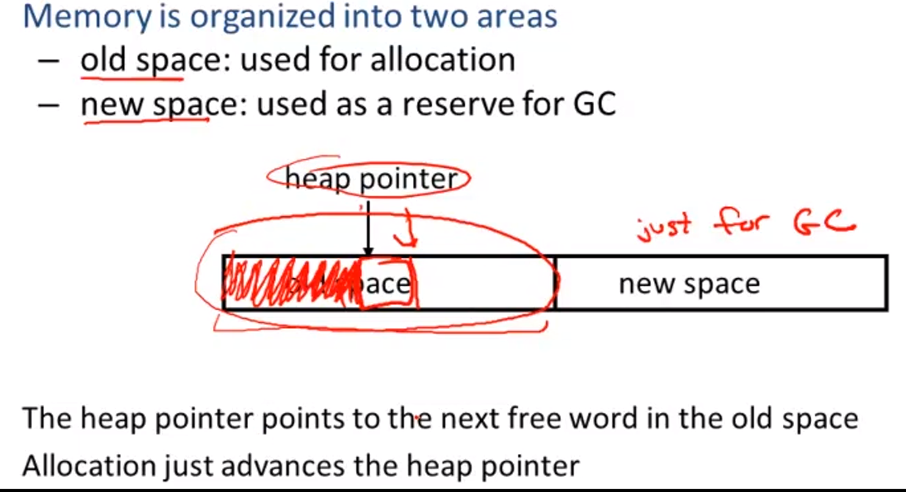
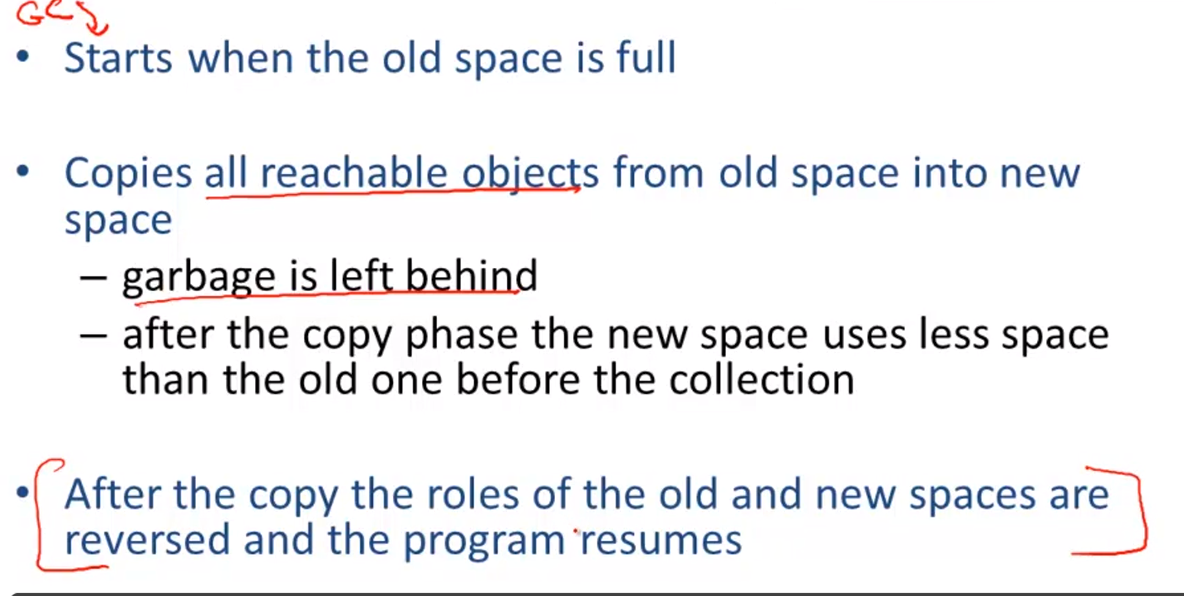

被复制过去之后,指针访问旧区域的时候,会发现旧区域已被标记,然后会更新指针指向新区域
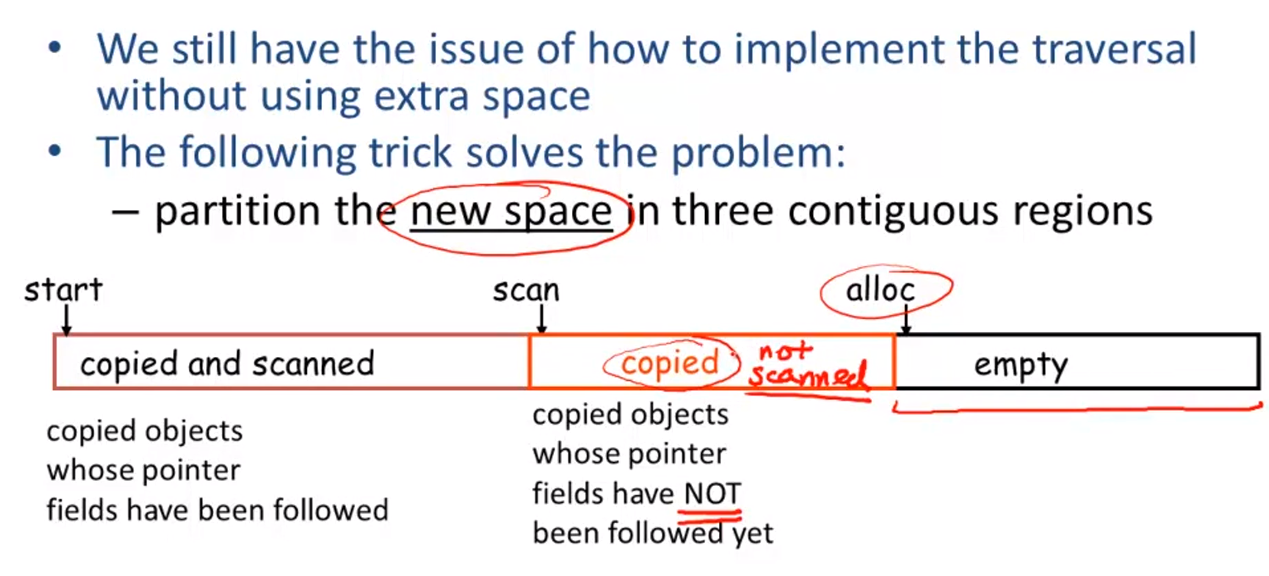
scan到alloc之间就是需要被更新的
solution
先复制A,然后根据指向按序复制到新区域并更新pointer
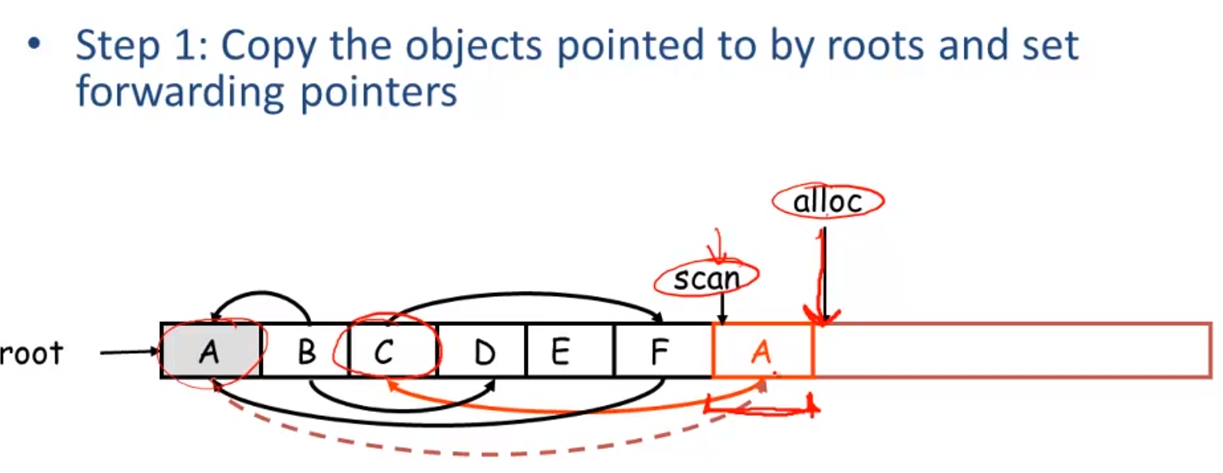
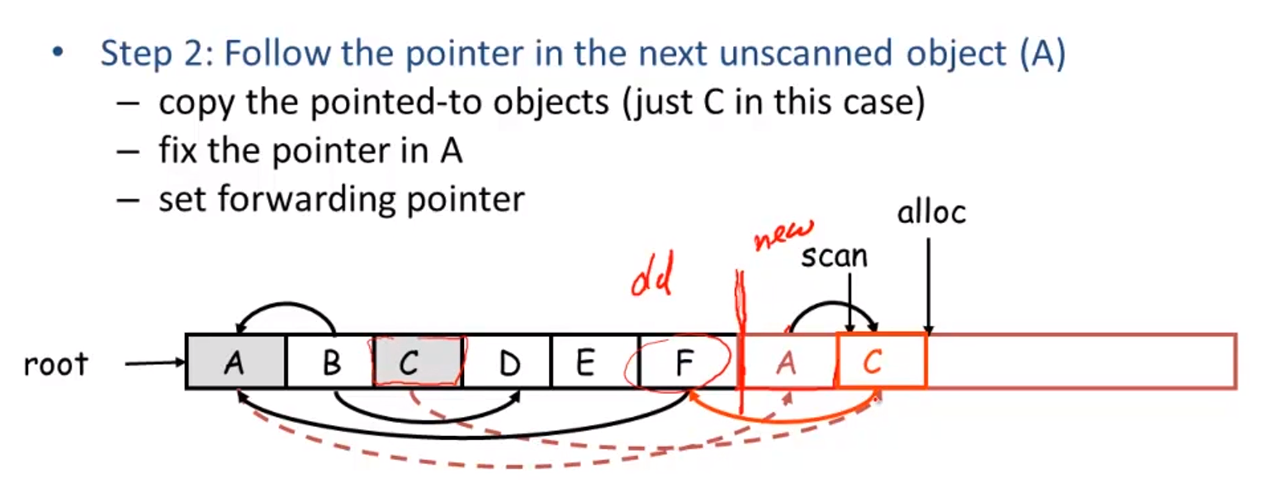
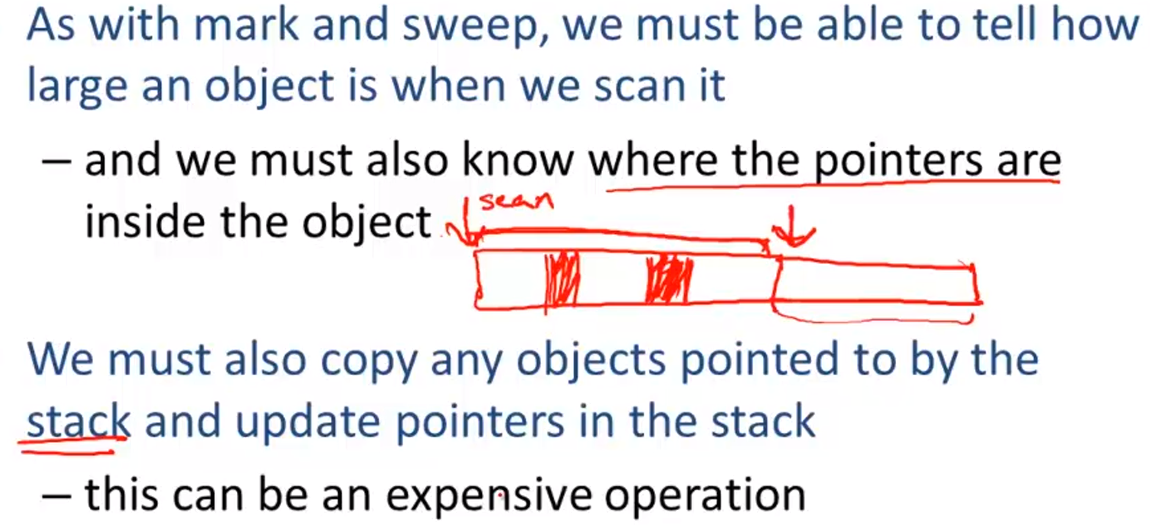
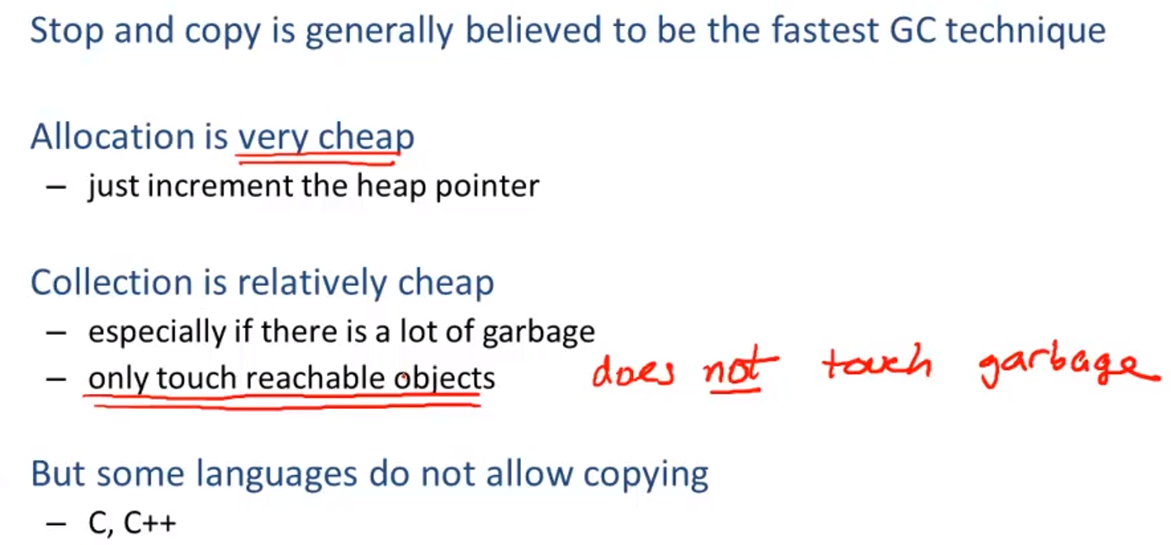
Conservative Collection

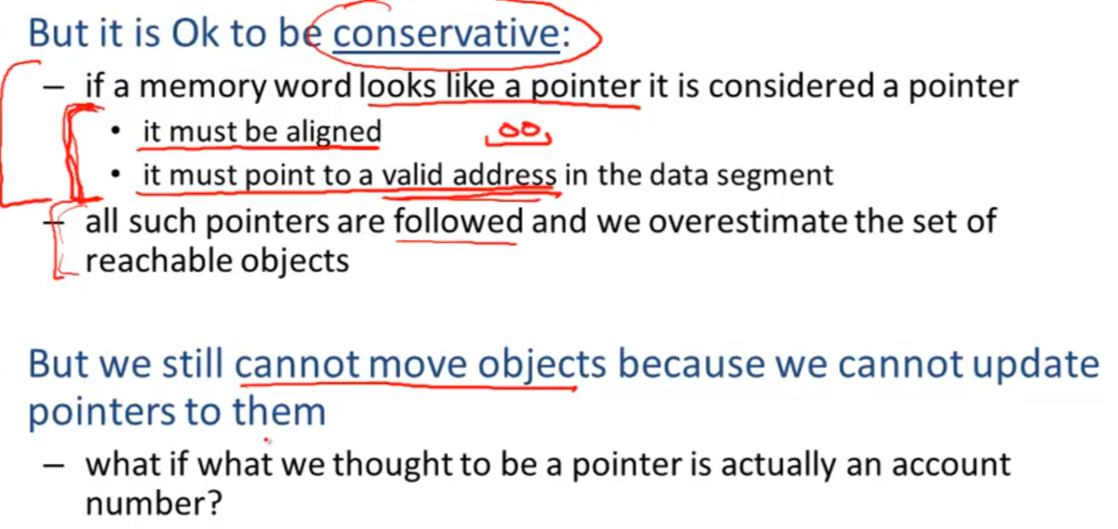
Reference Counting
Try to collect an object when there are no more pointers to it.


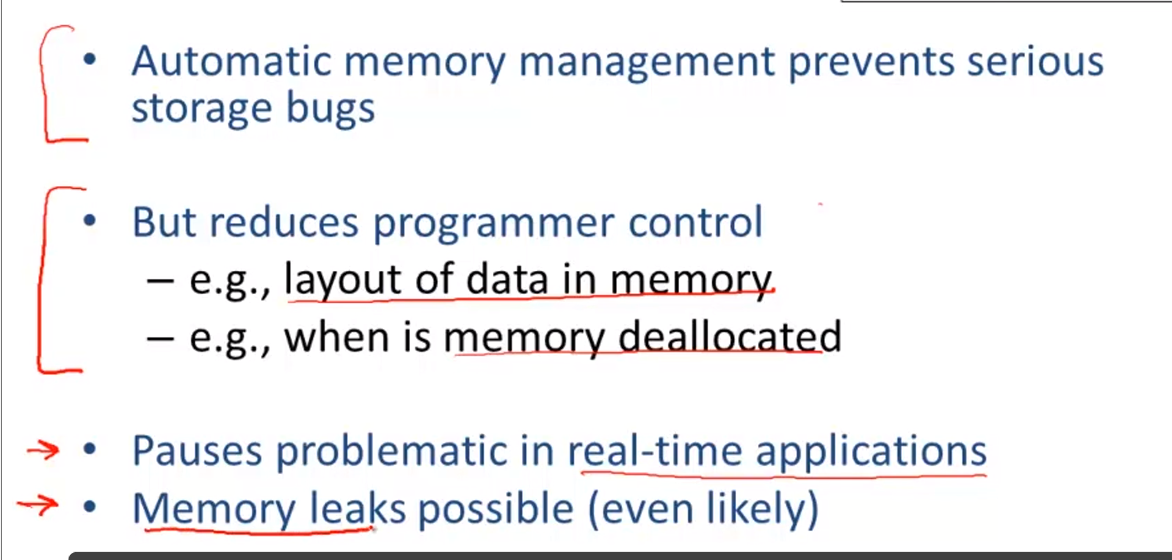
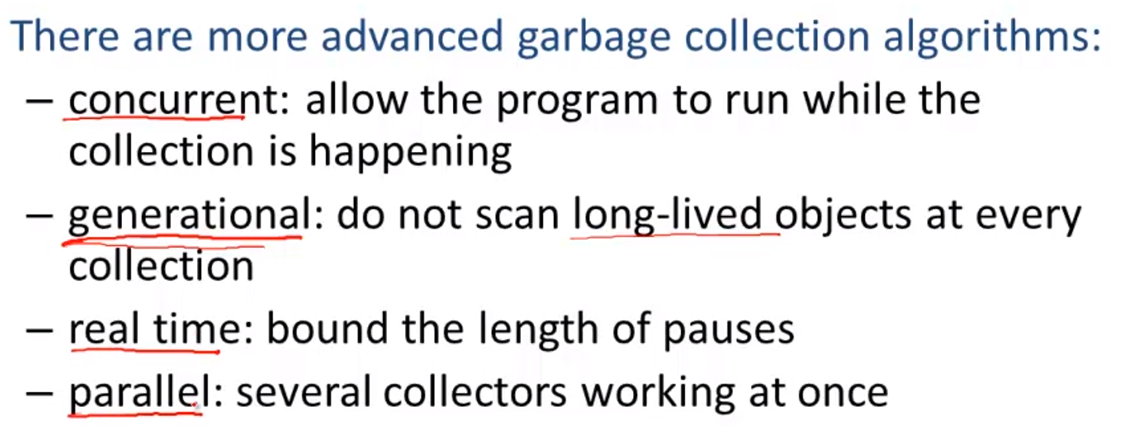
「真诚赞赏,手留余香」
真诚赞赏,手留余香
使用微信扫描二维码完成支付
